You are using an out of date browser. It may not display this or other websites correctly.
You should upgrade or use an alternative browser.
You should upgrade or use an alternative browser.
Symphonium Audio Crimson
- Added by Head-Fi'er
- Create date
-
- Tags
- crimson symphonium audio
SherryLion
New Head-Fier
Pros: 1. Delightful and balanced sound
2. Musical and engaging response
3. Detailed and airy presentation
4. Expressive and well-bodied notes
5. Controlled yet impactful bass
2. Musical and engaging response
3. Detailed and airy presentation
4. Expressive and well-bodied notes
5. Controlled yet impactful bass
Cons: 1. A nitpick actually, rarely sibilance surfaces and becomes noticeable on bright tracks or female vocals emphasised tracks.
Review Of The Symphonium Crimson

Introduction
This may be the first time I am assessing an audio product outside of the Chi-Fi business, but the company and their product, which I have previously been pleased with, are not new to me. Symphonium Audio is a Singaporean company founded in 2016 by three entrepreneurs who want to convey the delight of sonic bliss to the entire globe while also creating something special and unique. Many audiophiles, like myself, have previously praised their efforts and quality in producing such excellent products. I've already tested several of their offerings, including Helios and Meteor, which both astounded me with how easy they sounded. Though I wasn't able to evaluate them, I was fortunate enough to review one of their newest releases, the Symphonium Audio Crimson, but before I go any further, I want to clarify a few points.

Disclaimer
*This is a review unit, courtesy of Pritam from Audio Store. All thanks to them for providing. And as I've said in all of my evaluations, the same is true for this one: all of the concepts I've expressed below are entirely my own, original ideas that haven't been influenced by anyone else. If interested, go to this link.
*I am not associated with the connection and receive no financial assistance from anyone.
*For the remainder of the review, I will refer to these IEMs as “Crimson.”
*I am using different Ear-tips for convenience and better versatility.
*Finally, I will only evaluate the Crimson based on their performance, even though I will explain how it feels and seems physically and aesthetically.
Specification
The Crimson is equipped with an all-balanced armature driver made up of four BAs and three in-house created technologies. TrueX 4-way crossover is used for driver integration and employs two distinct but complementary technologies: FLAT and PHAT. FLAT ensures low impedance and immunity from impedance mismatch, while PHAT ensures no unnecessary frequency inversions or phase cancellation. The Crimson shell is made of high-grade T6 heat-treated AL6061 aluminium alloy, with a new colour scheme over the faceplate including a premium carbon fibre in the centre that pays homage to the brand's origins and resilience. The shell's design and feel are highly premium and minimalist in appearance, giving it a professional and distinctive vibe. The shape is also not an issue for my ears because they fit and isolate properly; nevertheless, people with small ears should be aware that the shells are on the larger side. The included cable is an Altalune Audio Novaron 26AWG Type 2 Litz copper cable with a modular termination on one end and a spring-loaded 0.78mm two-pin connector on the other. In my perspective, the cable appears substantial but feels light in my palm; it also combines nicely with the Crimson. The cable is also available in two variants: 4-core or 8-core unique offerings. The bundle also includes three different sizes of Azla Sednafit standard eartips, three different sizes of Divinus Velvet eartips, and a 3.5mm and 4.4mm termination plug. According to the technical parameters, the IEM's impedance is 6.05 Ohms and its sensitivity is 106dB. The frequency response spans 10 Hz to 24 kHz. The cable impedance for the 4-core cable is 0.12 Ohms.
Sound
I have come across the Crimson IEMs and I have to say that they are a cut above my best-sounding IEM, the Prestige LTD. The Crimson provides an incredibly enjoyable experience, surpassing any other IEMs I have heard, whether they are top-of-the-line or not. The Crimson’s presentation is expressive yet smooth, with a balanced and warm response that accurately reproduces the quality of the notes while providing a playful presentation of the vocals and instruments. The newer BA IEMs can sound less metallic or artificial, but Symphoniom has gone above and beyond in this regard. I have previously thought that the Helios offered better detail retrieval than the Thieaudio Monarch MKII, but I preferred the Monarch MKII’s pleasing tonality, which became my favourite at the time. However, the Crimson has now generously offered everything I wanted and more, including the weight and impact of the bass, and the musicality in the presentation of the vocals and instruments in the upper frequencies while retaining a pleasing tonality. I truly enjoy these IEMs and would like to explore their sound further to find out more about their exceptional quality.

Treble
Upon careful consideration, I must admit that the LTD has a more vibrant and lively treble region than the Crimson. While the Crimson's response strikes me as somewhat crazy, its sound is airy and expansive, with both vocals and instruments possessing a comforting, nuanced quality that never compromises their tonal integrity. The passive, cohesive response maintains a mesmerising quality of the presentation. The upper treble offers a hint of zing, allowing cymbal crashes or chimes to stand out in the overall mix, which adds distinction and favourability for the listener. Songs like Kujira Yumemi's "Kenka" showcase the chimes in a stunning, expressive way, without overwhelming the listener and losing fidelity. The lower treble also offers a similar experience, with a direct, forward approach that does sacrifice the lean adequacy and sharpness of the notes yet brings vibrancy to the presentation. The notes have great energy, which is spread evenly over the entire region to bring each note to life for the listener. The separation between vocal notes and instruments is impressive, creating a clear and defined soundstage. Despite this, the soundstage never feels too vast, allowing for a more nuanced, intimate listening experience. Additionally, the 4k dip creates a safer approach for the notes while maintaining a linear response. To sum up, the treble region's overall response is extensive, airy, and detailed, with a pleasing balance between expressiveness and fidelity.
Mid Range
The Symphonion Crimson offers a truly captivating experience when it comes to the mid-range notes of both vocals and instruments. The vocals are rendered with full-bodied emotion and realism, while the instruments stimulate the senses and bring the entire soundscape to life. Listening to Miller’s “Anytime Anywhere” with the Crimson is truly a treat, with multiple vocals coming across close, clear, and full of character. The upper mid-range is well-rounded and tonally balanced, with forward vocals that draw the listener in and playful instruments that make the presentation enjoyable and welcoming. Compared to the Monarch MKII, the Crimson’s response is even better, with superior revelation of both vocals and instruments, albeit at the expense of some openness and spaciousness. The response is still lively, keeping the listener engaged and interested. The impact of the high and low notes is naturally occurring and true to life, with a dense quality that is particularly impressive for a response that relies solely on BAs. While the lower notes can sometimes feel hollow, the lower mid-range maintains a heftiness without becoming muddy or mumbly. Overall, the mid-range presentation of the Crimson is authentic, expressive, and truly captivating.
Bass
When it comes to the bass response of this particular IEM, it is truly remarkable. It is the best bass I have heard from an all-BA IEM that falls under this price range. The tuning is such that it follows a neutral with sub-bass boost tuning, which results in an exceptional listening experience. What is particularly impressive is how the BA bass can deliver such quality and flexibility that is on par with what a dynamic driver can produce. However, what sets it apart is the cleanliness and accuracy of the impact of the notes. It is different from the natural decay that a dynamic driver produces but in an admirable way. The impactful notes are truly a delight for my ears, and I enjoy the weight and quality of the sound. The bass response is well-balanced and emphasises the sub-bass region, while also allowing for the mid-bass presence to be sustained. The deep rumble and punch of the bass have a noticeable impact on the response, making it an effective occurrence. The mid-bass presence brings a warmer response to the sound and delivers nice slams and powerful thumps in the mix. The mid-bass does leak into the lower mid-range, but it is not enough to detract from the overall quality of the sound. As you listen, you can feel the air pressure filling up your ears, giving you a sense of thumps and heaviness, while still resolving fast to keep the upper frequencies clean and clear. All in all, this IEM delivers an exceptional bass response that is sure to impress.
Technical Performance
As an avid audiophile, I must say that the technical prowess of the Crimson IEM is truly marvellous in my eyes. However, I must admit that I haven’t given as much time to other IEMs around this price range, which makes it a bit difficult for me to evaluate it fairly. That being said, when it comes to comparisons, I can only truly compare it to the Thieaudio Monarch MKII or Thieaudio Prestige LTD. In terms of sound response, the Crimson IEM is more intimate and better expressed in terms of forwardness and involvement in the mix. To be more specific, the sound quality is simply outstanding and the level of detail and clarity is unmatched.

Soundstage, Sound Imaging & Separation
Although the stage gives a more holographic response, it falls short in the closer approach, where the notes sound fuller and more complete. The sharpness and cleanliness of the notes, however, do provide great imaging capabilities. Even with such a response, the separation between the notes is surprisingly distinctive, which helps to better understand the direction of the sound. Nevertheless, when I compare it to the LTD or Monarch MKII, I find it to be a little stepped back. These two bring a more spacious sound while generating strong imaging and better distinction between the notes.
Speed & Resolution
When I listen to LTD, it gives me a clear understanding of what resolution is. The Crimson defines it as having a highly detailed response, whether it’s macro or micro details. The notes’ attack and decay are fast-paced, yet not too fast or slow, creating a natural sound. However, sometimes, it fails to achieve that natural sound.
Sound Impressions
Sources
Sony WM1A - While listening to the Crimson with WM1A, I noticed a marked improvement in the vocal expression and note clarity. The notes were crisp and clear, and the overall sound was simply stunning. The treble had an airy quality to it, which allowed the vocals to sound even more expressive and complete. However, this did come at the cost of sounding a little light, which sometimes resulted in a faint sibilance in the lower treble region. Despite this, the tonal balance remained undisturbed. Additionally, the bass had a fuller and richer sound, whether in the sub-bass or mid-bass range. The upper frequencies were kept clean, but the impact of the bass made it sound organic and natural. Overall, listening to the Crimson with WM1A was a truly exceptional experience.

Tempotec V6 - As I was listening to the Crimson with V6, I couldn’t help but notice the forwardness of the vocals in the overall response. The treble was exceptionally smoothed over, and the mid-range vocals were pushed up, resulting in a more vocal-centric sound. However, when it came to the bass, I was pleasantly surprised to find that even though it was well-controlled, it still managed to deliver a powerful punch. The result was a slightly dark, yet energetic response that left me thoroughly impressed.

Simgot DEW4X - As I was listening to music on the Crimson with DEW4X, I couldn't help but notice the transparent response and enhancement over all frequencies. The sound was clearer and more expressive than ever before, with every detail feeling stronger and more potent in the mix. This allowed for better clarity overall, making it easier to hear every note and nuance in the music. However, while the bass and treble did feel a little more linear and clearer, it also made the music sound less organic and natural. The tonality faced a leaner presentation of the notes, which might not be preferable for those who prefer a warmer, more natural sound.

Quloos MUB1 - During my listening experience with the Crimson and MUB1, I couldn’t help but notice how the response of the sound felt soft and rounded. While the detailed aspects of the notes were not as prominent, there was an improved grasp of the tonal quality which made the listening experience quite enjoyable. Another aspect that stood out was the spaciousness of the response, which allowed the vocals to sound open and free. Additionally, the treble felt extensive and airy, while the bass took a backseat in terms of power and impact, resulting in a sound that was warmer and more mellow than before. Overall, the listening experience was quite pleasant.

Comparison Between Symphonium Crimson and Thieaudio Prestige LTD
Despite having similar frequency responses, I found both to be distant in sound, primarily because of the different configuration setups of drivers and synergy across the frequency response spectrum. The Crimson responds in a more fun and lively manner, bringing forth a lot of energy in both the instruments and the vocals. Nonetheless, I do believe that the Prestige LTD generates a sound that is larger and more expansive, with more zing and sparkle in the air and a strong overall contrast in the notes. The Prestige LTD's leaner response sounds a little more mysterious and captivating, but the Crimson does a better job of tonally accurate note depiction than the Prestige LTD. The Prestige has a more U-shaped sound than the Crimson, and as a result, it has a less forgiving and warmer tone with finer details. The Prestige LTD enhances the texture and details more than the Crimson, but the Prestige LTD wins out when it comes to the bass response's natural decay and dynamic physicality. The bass response in the Crimson is more precise and noticeable overall. The energy in the overall mix is more concentrated within Crimson, which accentuates the forwardness and lively response; however, the Prestige LTD produces a well-balanced response that allows for great separation, layering, imaging, and staging in terms of technical sound, resulting in a better perception of depth and width than the Crimson. Overall, I feel the Crimson to be more melodic and delightful to listen to, whilst the Prestige LTD provides an accurate understanding of sound and its features.

Tracks
Millet - Anytime Anywhere
Anri - I can’t stop the loneliness
Kohana Lam - A Few Sentimental
Kohana Lam - Loving Me, Loving You
Uru - Kimino Shiawasewo
Uru - Kamihitoe
Kujira Yumemi - Kenka
Majiko - Kokoronashi
Anly - Sukinishinayo
Miliyah - Kono Yumega Samerumade
Rokudenashi - The Flame Of Love
Yu-Peng Chen - A New Day with Hope
Yu-Peng Chen - Another Hopeful Tomorrow
Yu-Peng Chen - For Riddles, for Wonders
Valentino Khan - Satellite
Kai Wachi - Happier By Now
Jawns - Erotica
ISOxo - how2fly
Kai Wachi - Happier By Now
Weeknd - Popular
YUNGBLUD - When We Die(Can We Still Get High)
Bring to Horizon - Kool-Aid
Middle Kids - Bend
FLETCHER - Leads Me On
Loathe - Aggressive Evolution
The Weeknd - Save Your Tears
Sigrid - Burning Bridges
AURORA - Black Water Lilies
AURORA - Runaway
X Ambassadors - Renegades
Lupe Fiasco - Words I Never Said
Macklemore & Ryan Lewis - Can’t Hold Us
Gotye - Somebody That I Used To Know
Jay-Z - Run This Town
Lady Gaga - Poker Face
Lady Gaga - Just Dance
Ladytron - Ghost
Travis - Love Will Come Through
LINKIN PARK - Somewhere I Belong
DJ Shadow - Six Days (Remix)
Hoobastank - The Reason
Ricky Martin - I Don’t Care
Tool - 7empest
Tool - Vicarious
A Flock Of Seagulls - Space Age Love Song
Zack Hemsey - Vengeance
Elton John - I’m Still Standing
The Moody Blues - Nights In White Satin
Micheal Sembello - Maniac
Guns N’ Roses - Sweet Child O’ Mine
A.R. Rahman - Kun Faya Kun
Conclusion
To end this review, What Symphonium Audio strides to achieve and what goals they have set have been validated by Crimson, The precision in quality and redefining the parameters of elegance in sound reproduction is achieved through Crimson. The musical and lively response with robust and cohesive quality across the overall tuning makes it one of the most enjoyable, detailed and engaging IEM. A wonderful and satisfying innovation, to be sure. However, I cannot speak for the audiophile community regarding whether the price justifies the overall offering. However, when I compared my beloved PRESTIGE LTD to Crimson, I found the Crimson to be on par with LTD while offering a different taste, so Crimson has my wholehearted recommendation. You won't be able to let them go once you get them on your ears, I promise.

V
vineetkrshukla95
Nice one, comparison was great
o0genesis0o
Headphoneus Supremus
Pros: + Laser-sharp instrument separation and layering
+ Outstanding detail retrieval
+ Immersive and 3D soundstage and imaging
+ Snappy and exciting transient response
+ Subbass rumble and texture
+ Tonality is spot on
+ Outstanding detail retrieval
+ Immersive and 3D soundstage and imaging
+ Snappy and exciting transient response
+ Subbass rumble and texture
+ Tonality is spot on
Cons: - Upper treble can become harsh with a shallow fit
- Stock tips might not provide the necessary deep fit to avoid treble harshness
- Can be demanding in terms of the DAC/amp to pair with it
- Stock tips might not provide the necessary deep fit to avoid treble harshness
- Can be demanding in terms of the DAC/amp to pair with it
There is an inherent beauty, a classical beauty, in doing things right. To optimise. To be efficient. To get the most out of the least.
Classically beautiful. That’s how I think about a new wave of IEM boutiques run by young teams with a strong engineering background and a good taste of aural experiences. A while ago, I have had the pleasure to test and write about Helios from Symphonium, a Singaporean IEM manufacturers whose pride is engineering excellence. In the following months, inspired by my experience with Helios, I added its budget-friendly sibling, the Meteor, to my small collection. Yet, despite all their merits, these IEMs have not fully resonated with me.
Now, Symphonium is back for the third round with their current flagship, the Crimson. Is this finally the one? Read on to find out, my friends.
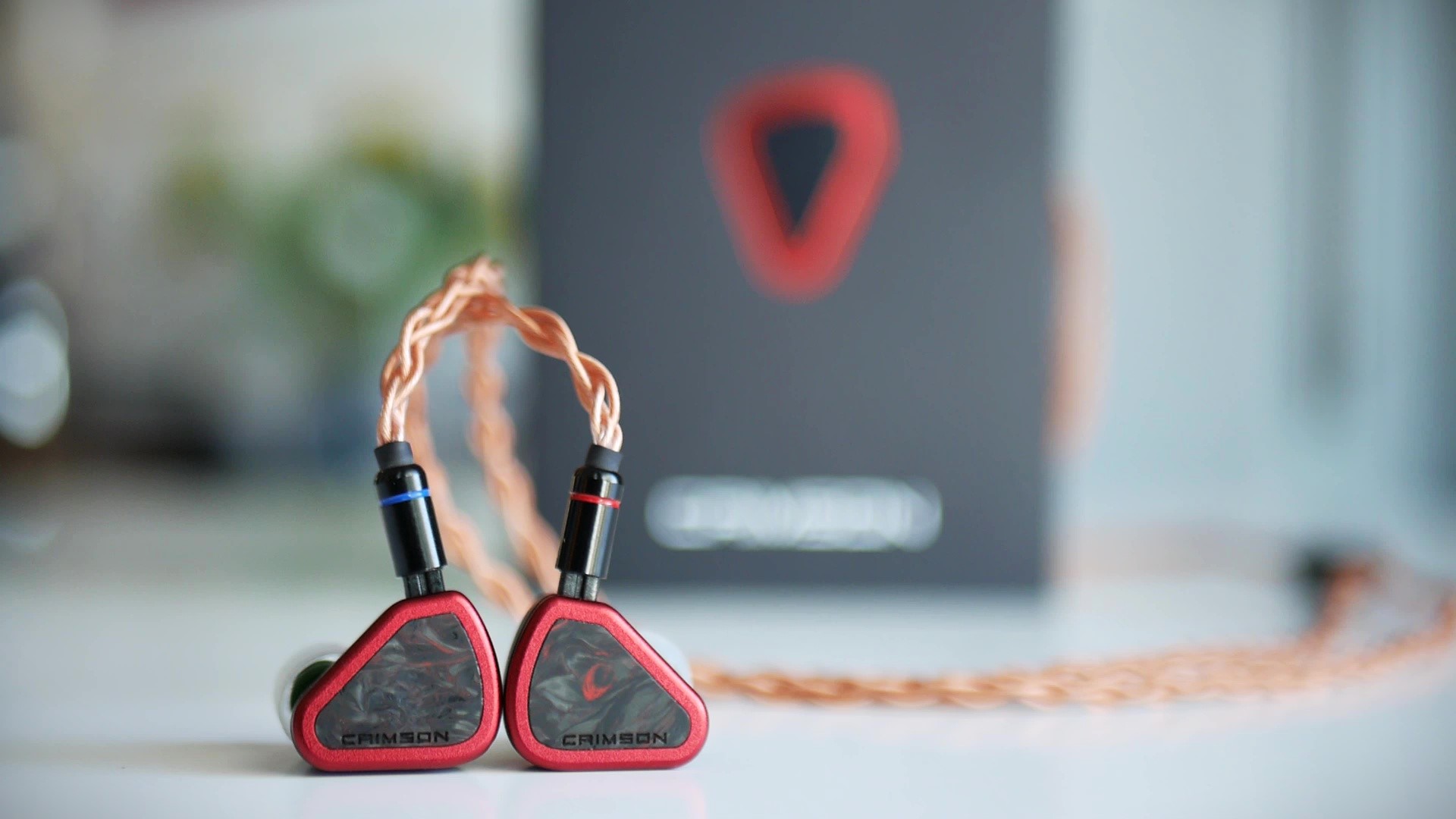
Like most Symphonium IEMs, Crimson has four BA drivers and a complex crossover circuitry, all encased in a reversed tear-shape metal shells.
4 BA drivers, you ask?
Yes. Crimson has 4 BA drivers, just like Helios and Meteor before it. Yet, these IEMs sound quite different in both tuning and technical performance.
Some familiar technologies from Helios and Meteor make a return with Crimson:
Before moving on, let’s quickly talk about packaging and accessories. Again, little has changed since Helios.
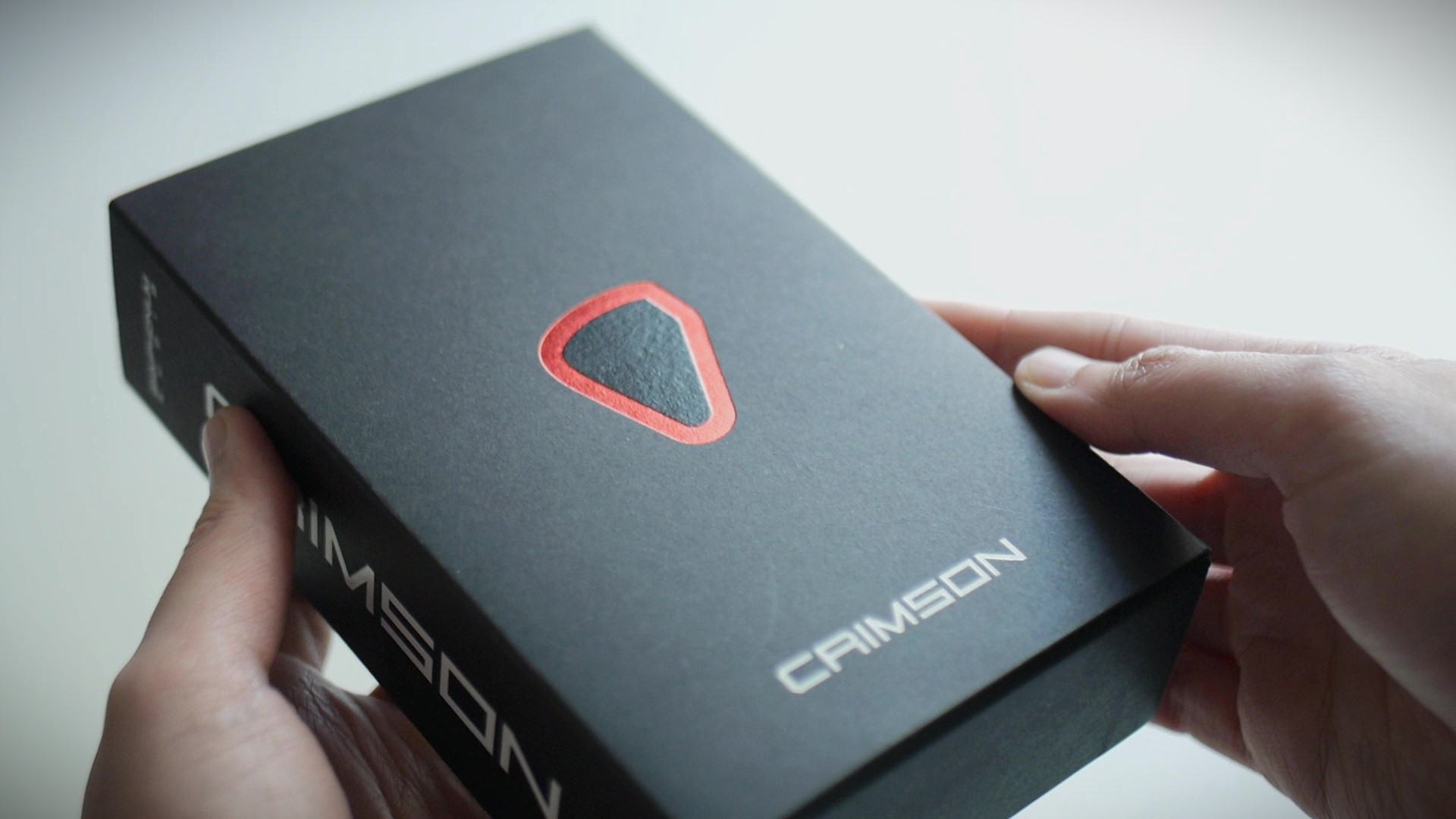
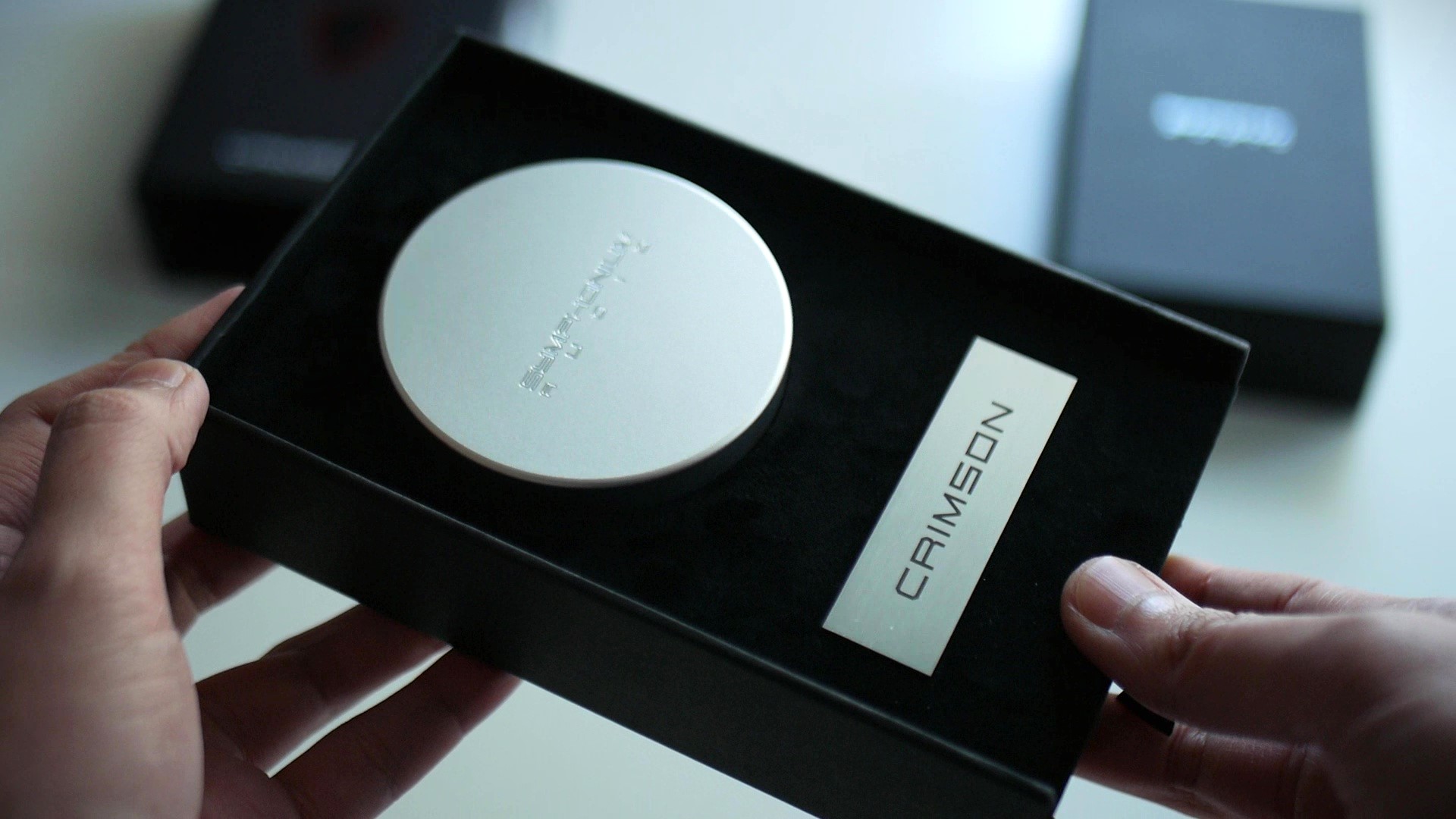
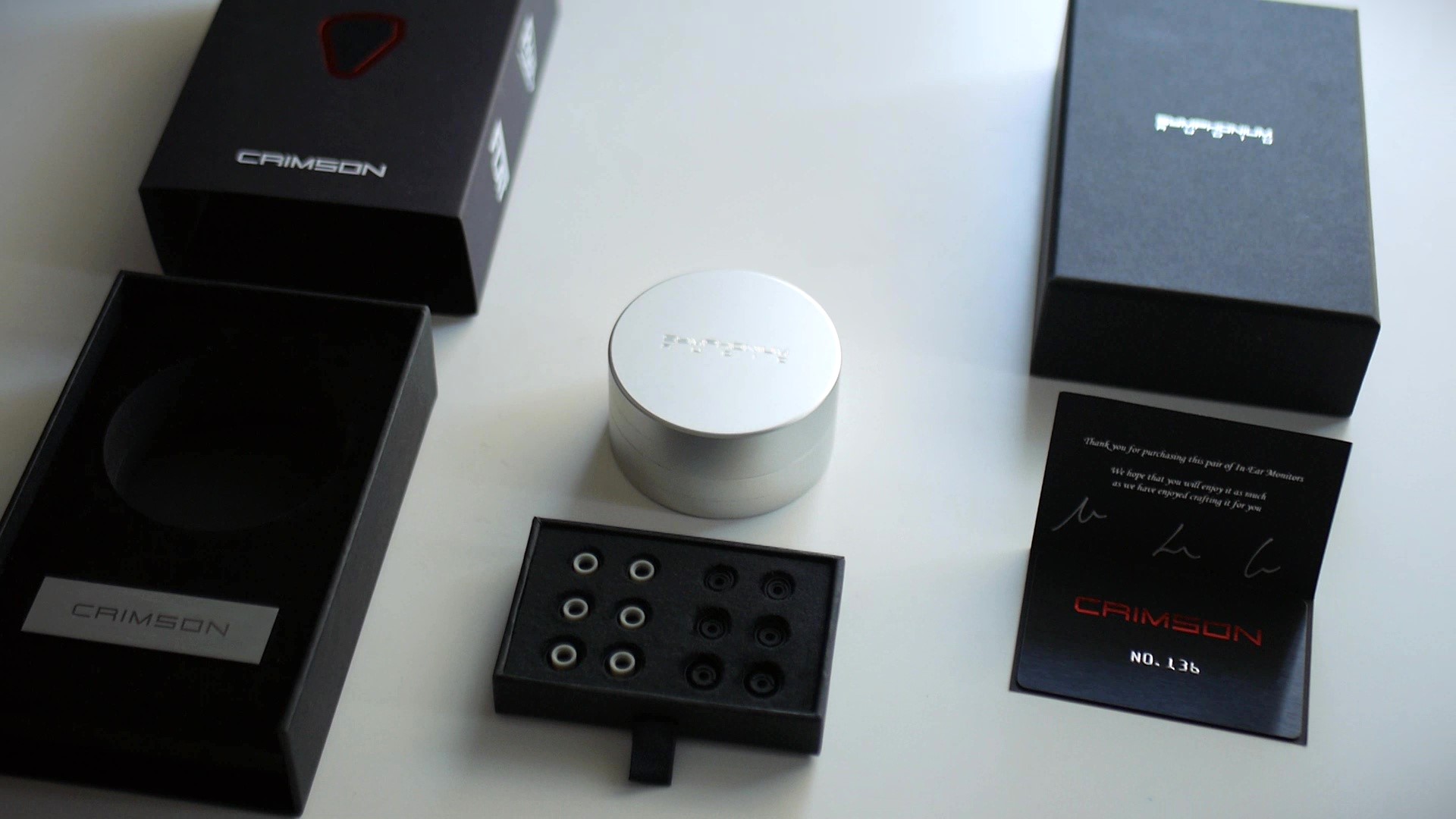
Crimson comes in a surprisingly small box and stored in a surprisingly small metal case. Inside the case, you can find the IEM itself and a cable of your choice.
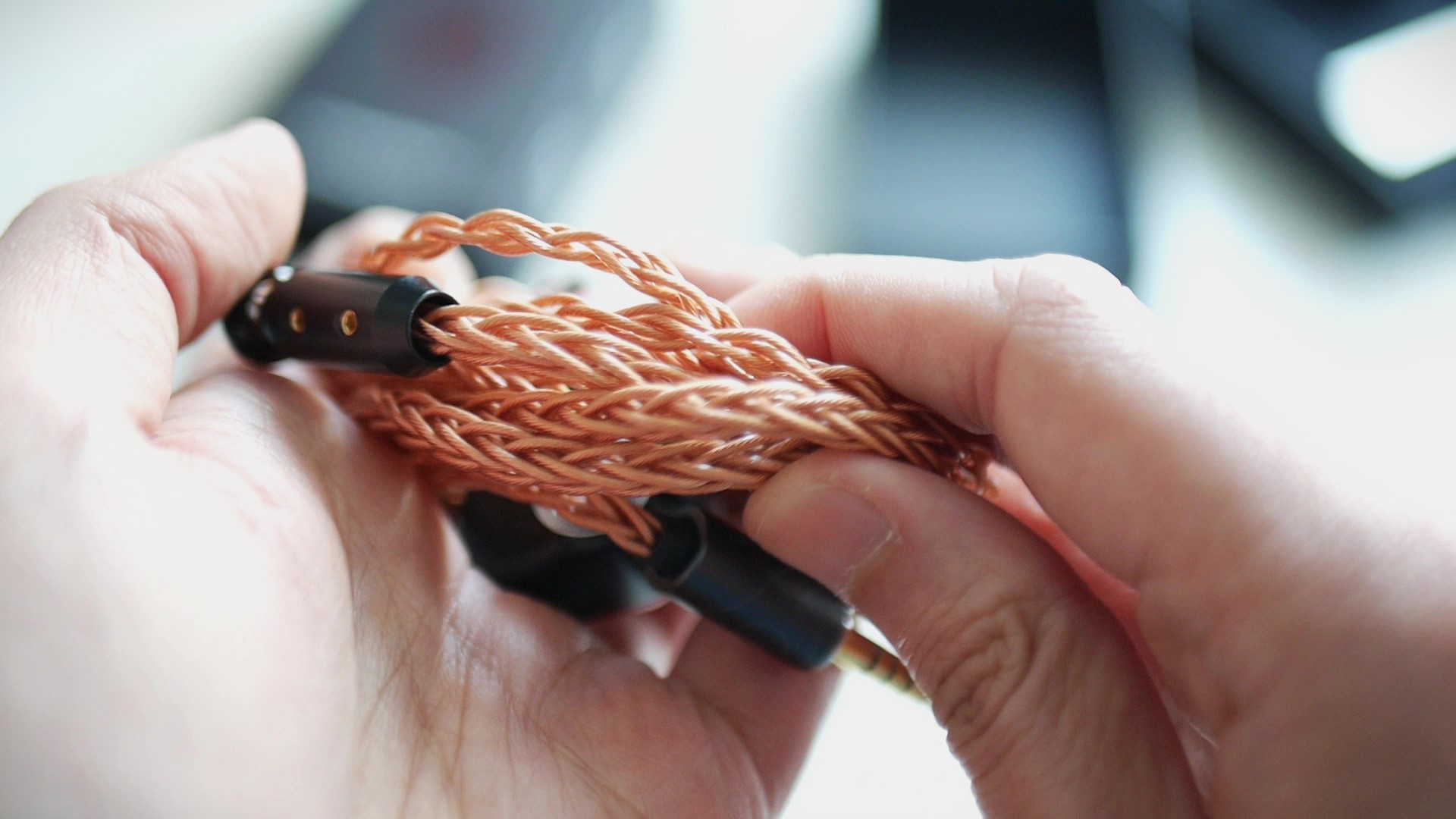
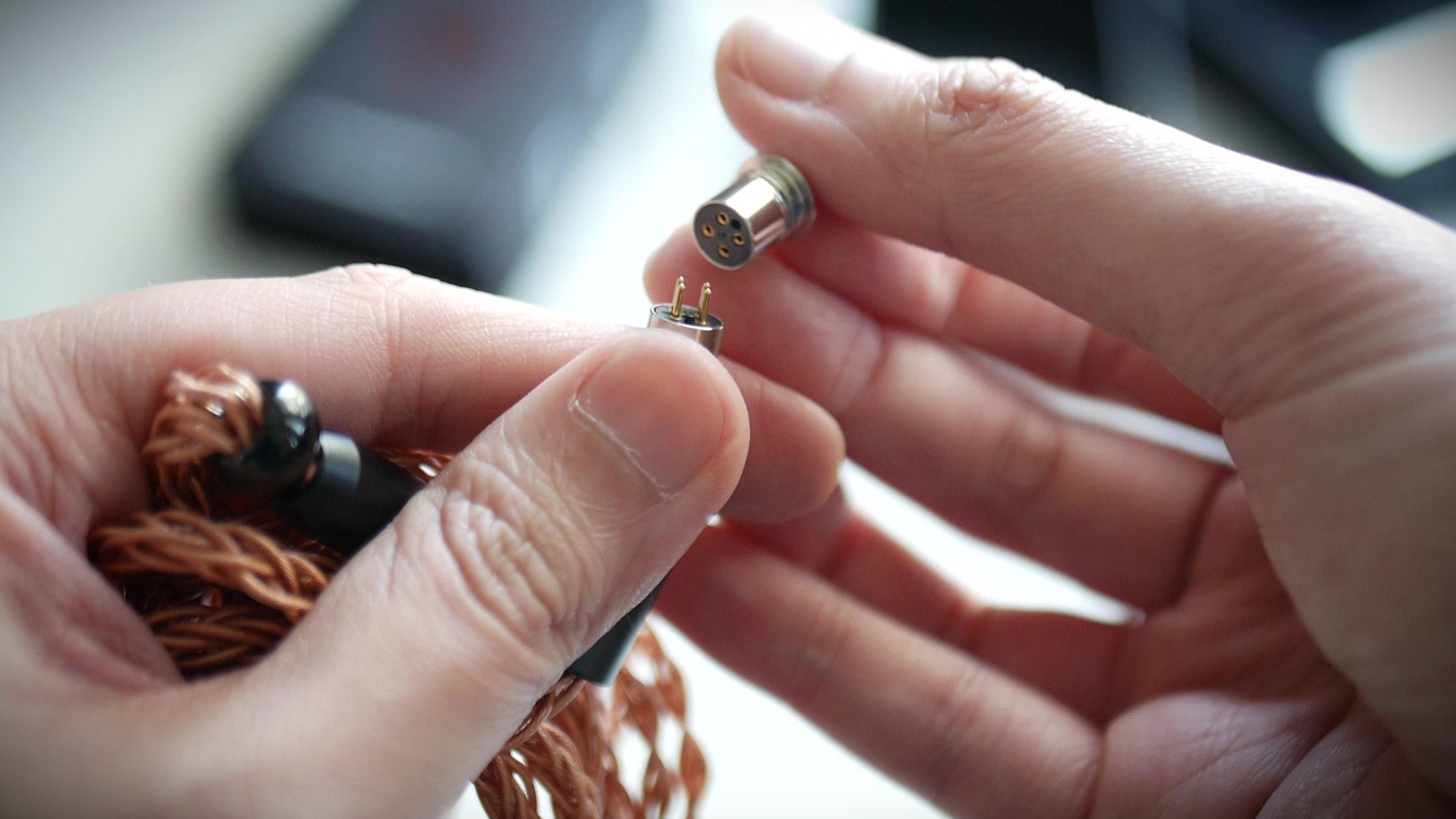
My unit came with the upgraded 8-wire cable with interchangeable plug. Despite having 8 wires, the cable is supple and very well behaved. The thickness of the cable also matches the size of the earpieces.
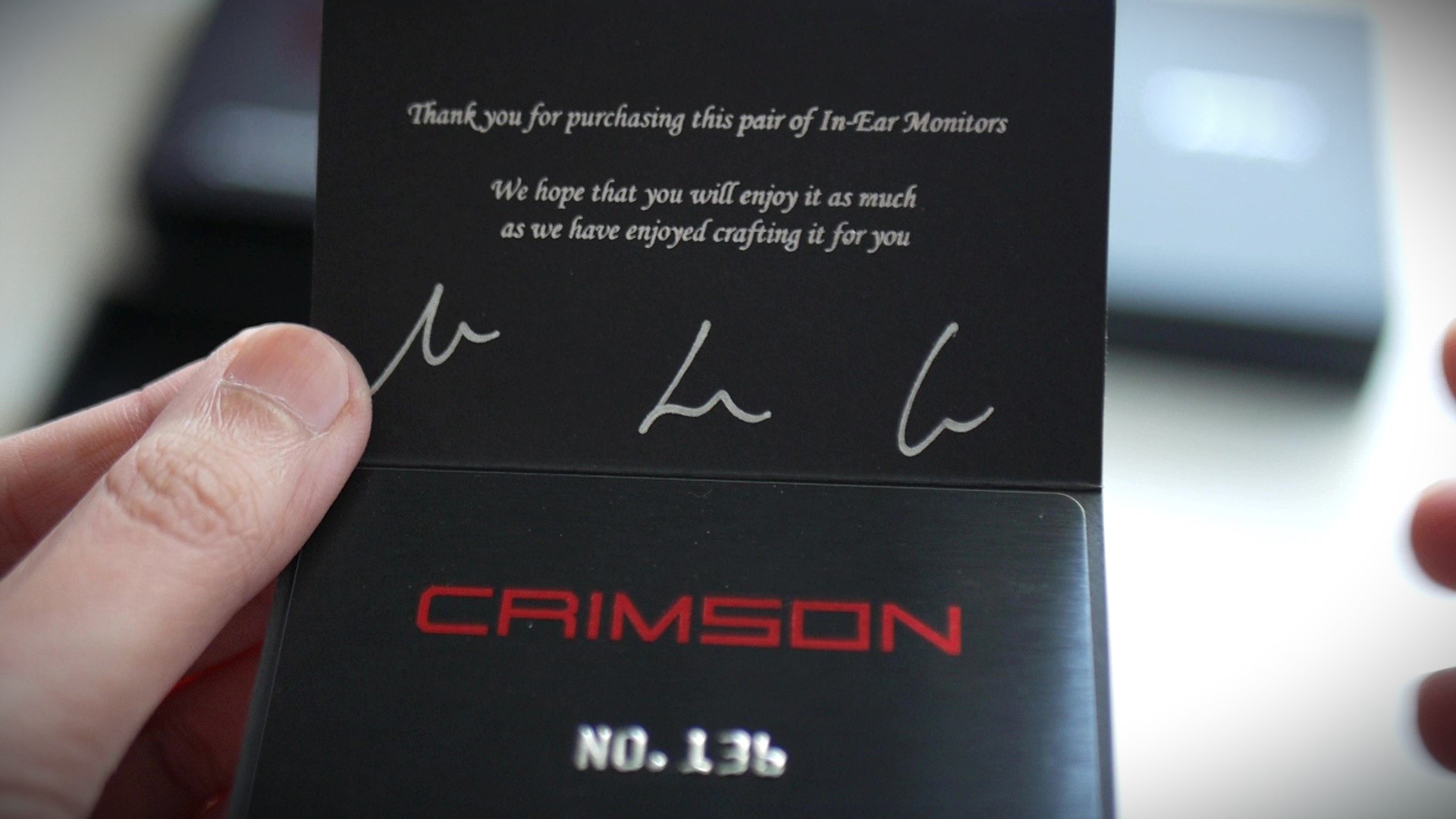
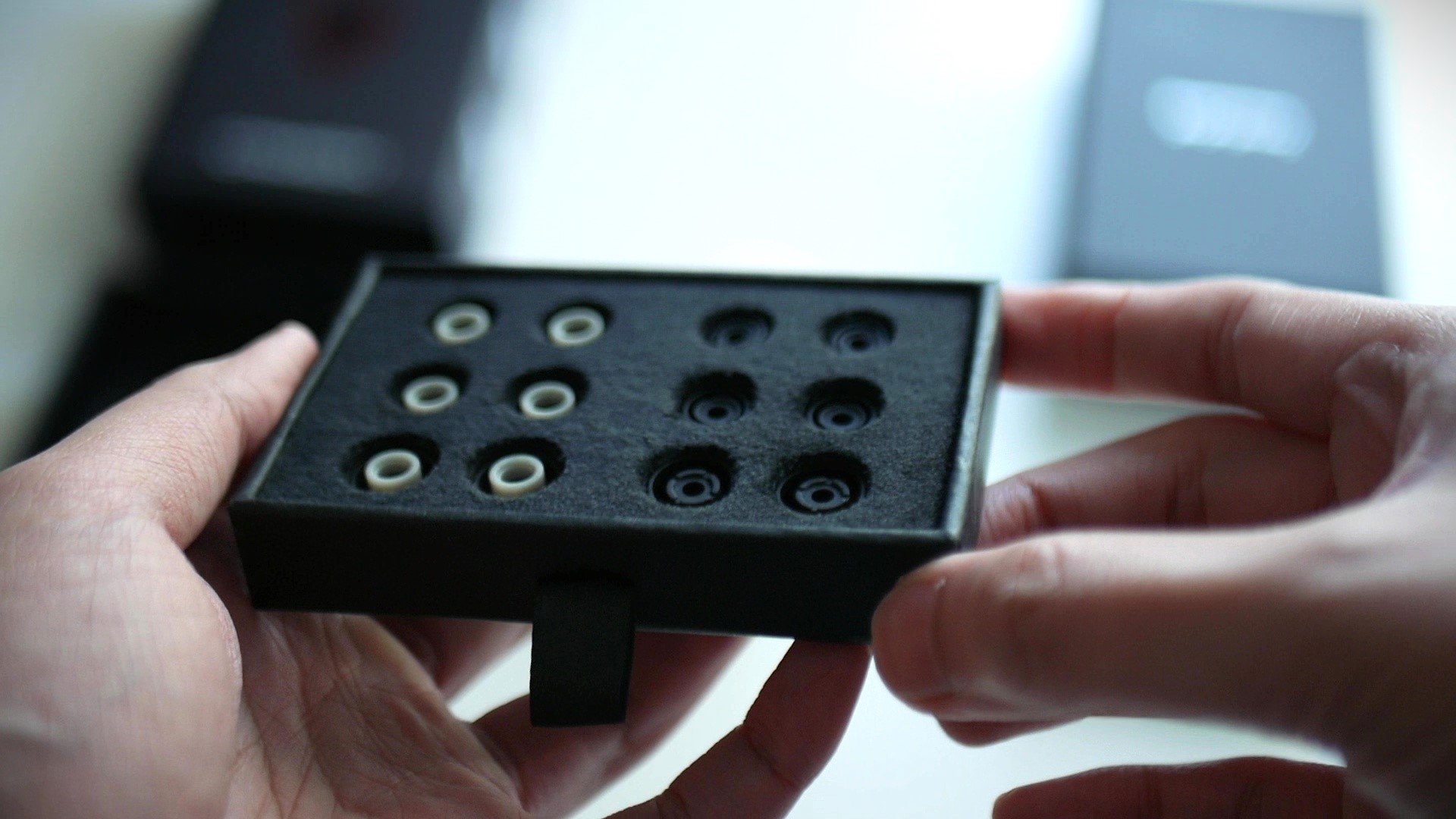
At the bottom of the box, we can find a drawer that contains two types of quality ear tips (Azla SEDNA and Divinus Velvet) and and a warranty card with signature from Symphonium team members.
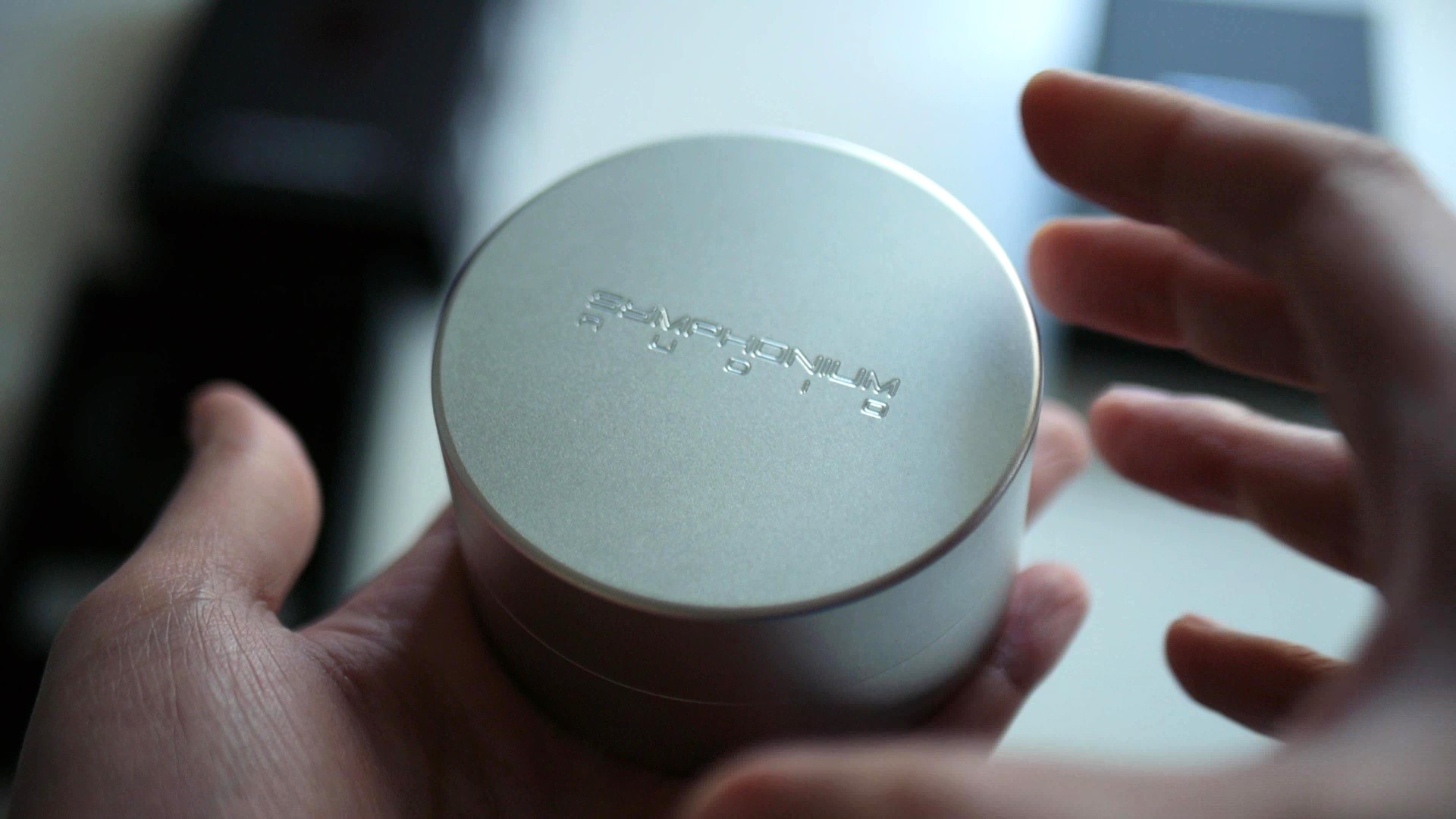
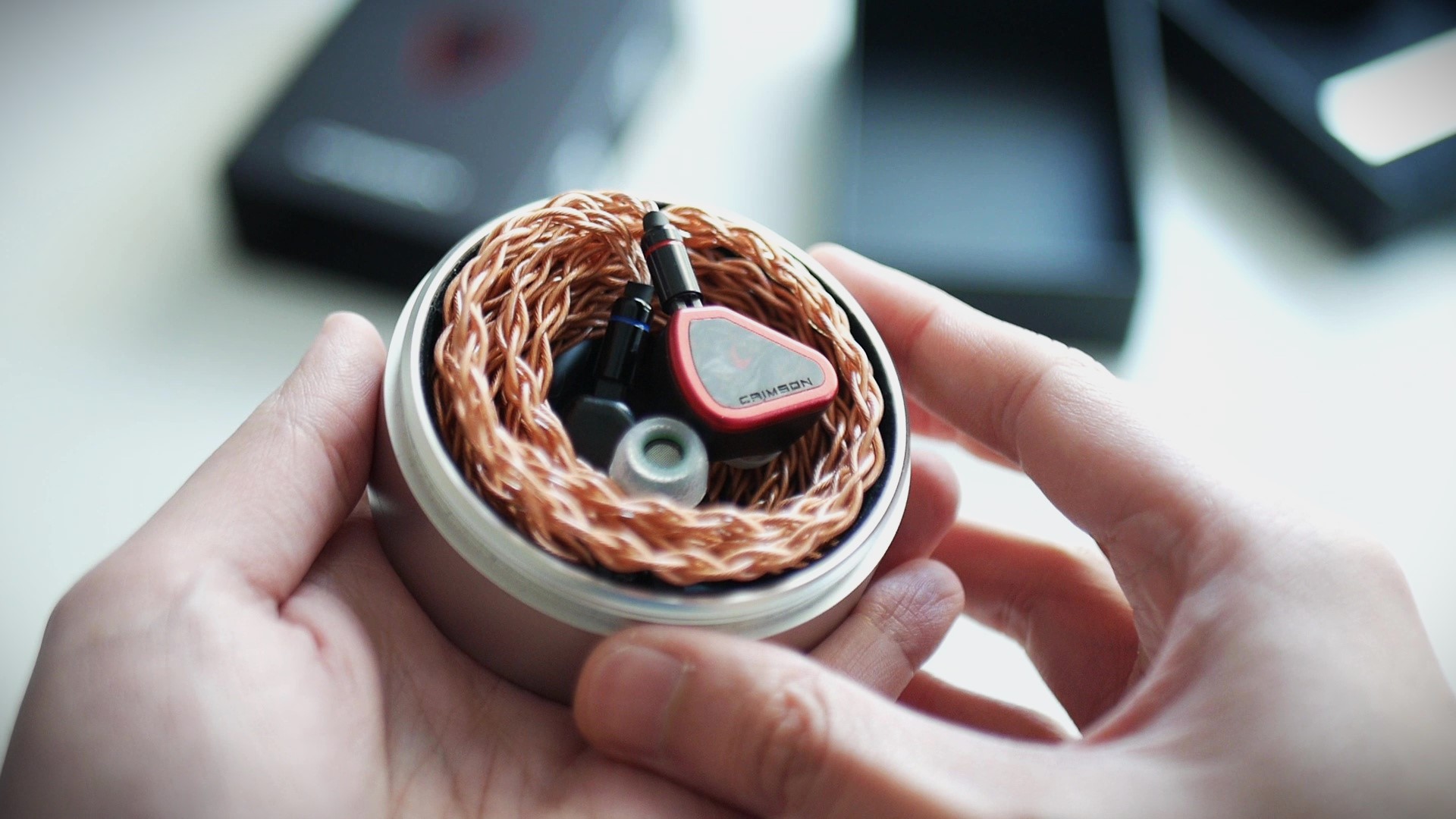
The earpieces of Crimson are encased in the same aluminium alloy material that was used by Helios. The size of the earpieces are also identical. However, Symphonium has made some adjustments to make the fit of Crimson much better than Helios. The most significant change was the reduction of nozzle length. No longer we have to tolerate long and thick nozzles to enjoy that sweet sweet treble extension.
The earpieces of Crimson are fully sealed. Therefore, depending on the type of ear tips that you use, there is a chance that you would encounter pressure build up (that stuffy, vacuum-sealed sensation in the ear canal that can be quite fatiguing). Fortunate for me, I did not encounter that problem during my tests. With either the medium Divinus Velvet ear tips supplied in the box or my own set of medium Sancai wide bore ear tips, the IEM seem to disappear in my ears even in longer listening sessions that last up to a few hours.
Because there is no dynamic driver inside Crimson, there has been no incidence of driver flex during my tests.
Ear tips recommendation: the choice of ear tips are very personal because our ears can be quite different. I found that Crimson sounds much better with short ear tips with wide opening. These tips allow me to minimize the length of the nozzles, which in turn smoothen the treble response. In fact, when I used the stock SEDNA ear tips, which extends the nozzles quite a bit and pushes the IEMs further away from my ear drums, I hear a noticeable treble peak that manifests in a high-pitch “hiss” at the top of higher vocals, cymbals, hats, and trumpets. This hiss and the corresponding harshness was gone when I switched to the Sancai ear tips.
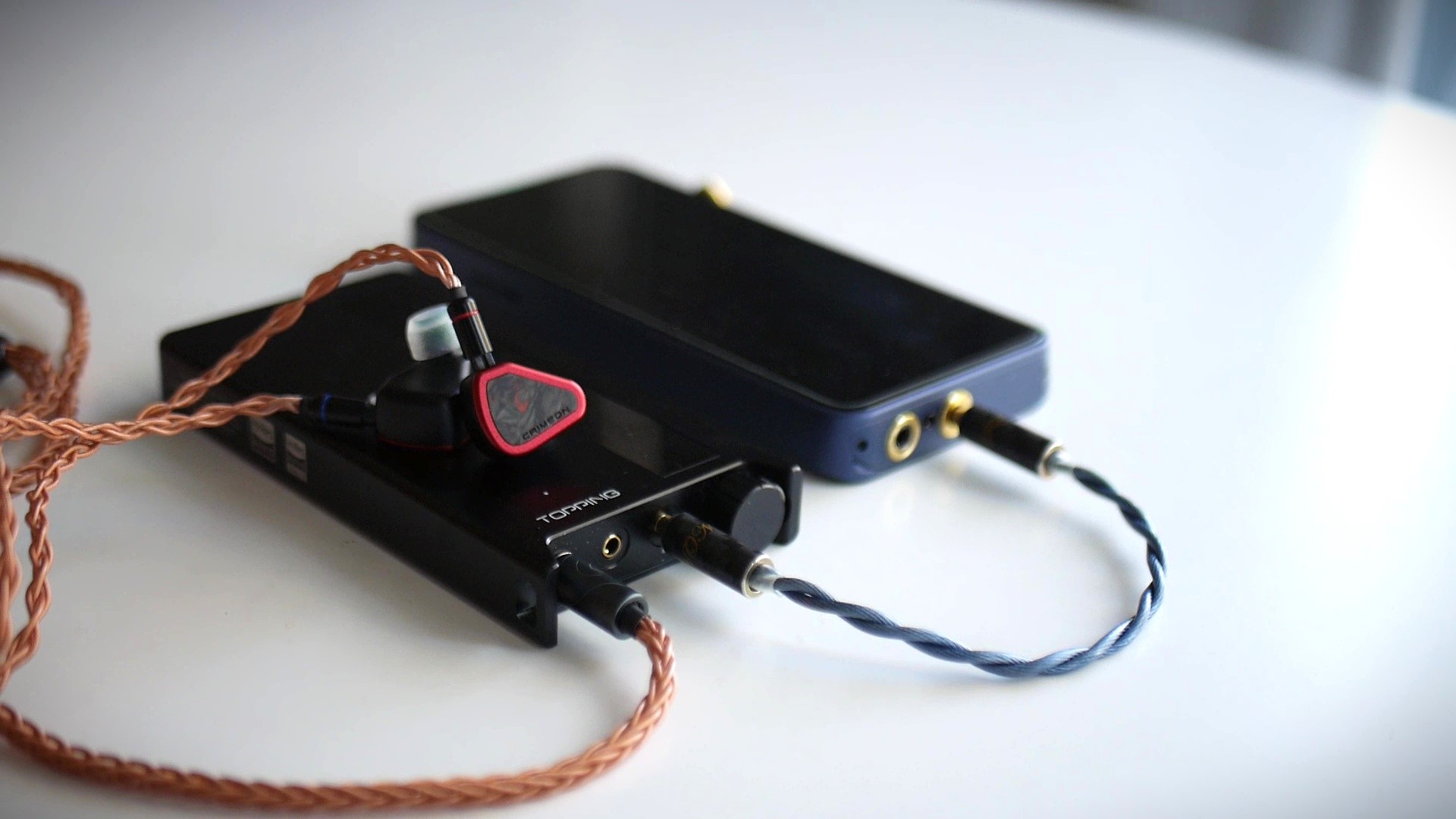
An IEM builder once told me that more complex crossover designs tend to make IEMs very difficult to drive. Crimson might be an example of this conjecture. With the impedance of 6.05ohm@1kHz and sensitivity of 106dB/Vrms@1kHz (83dB/mW@1kHz), Crimson is a very difficult IEM to drive indeed. You need an amplifier that can maintain stable current supply when facing large volume peaks (transients), especially when the peaks are in the bass region.
Usual disclaimer: when I say that an IEM is “difficult to drive”, it does not mean that I cannot get loud sound out of them from a weak amplifier. It means that that sound is noticeably more muffled, muddy, and more congested with these devices. In other words, a “difficult to drive” IEM does not sound very good without good amplification but can “scale” when paired with a stronger amplifier.
So, how difficult are we talking about?
The Apple’s USB-C to 3.5mm adapter (a.k.a., “Apple dongle” a.k.a., “all that you need”) at the maximum output can barely reach listenable volume when I listen to the album LIVE by Hans Zimmer. The bass is barely present. When a track forces the bass to appear, the bass lacks the crisp, snappy attacks and the texture is barely passable. Whilst the stage is properly wide, it feels 2D, lacking the near-to-far placement of instruments (depth and layering). Whilst it is not unlistenable, I can’t recommend this pairing unless you have nothing else on your hand. Interestingly, the Apple dongle got warm after a few songs.
Just for fun, I tried to drive Crimson with the headphone out of ASUS ROG Ally handheld gaming device. Again, the bass was weak and blurry. Interestingly, the sound started to distort at transient peaks in the music.
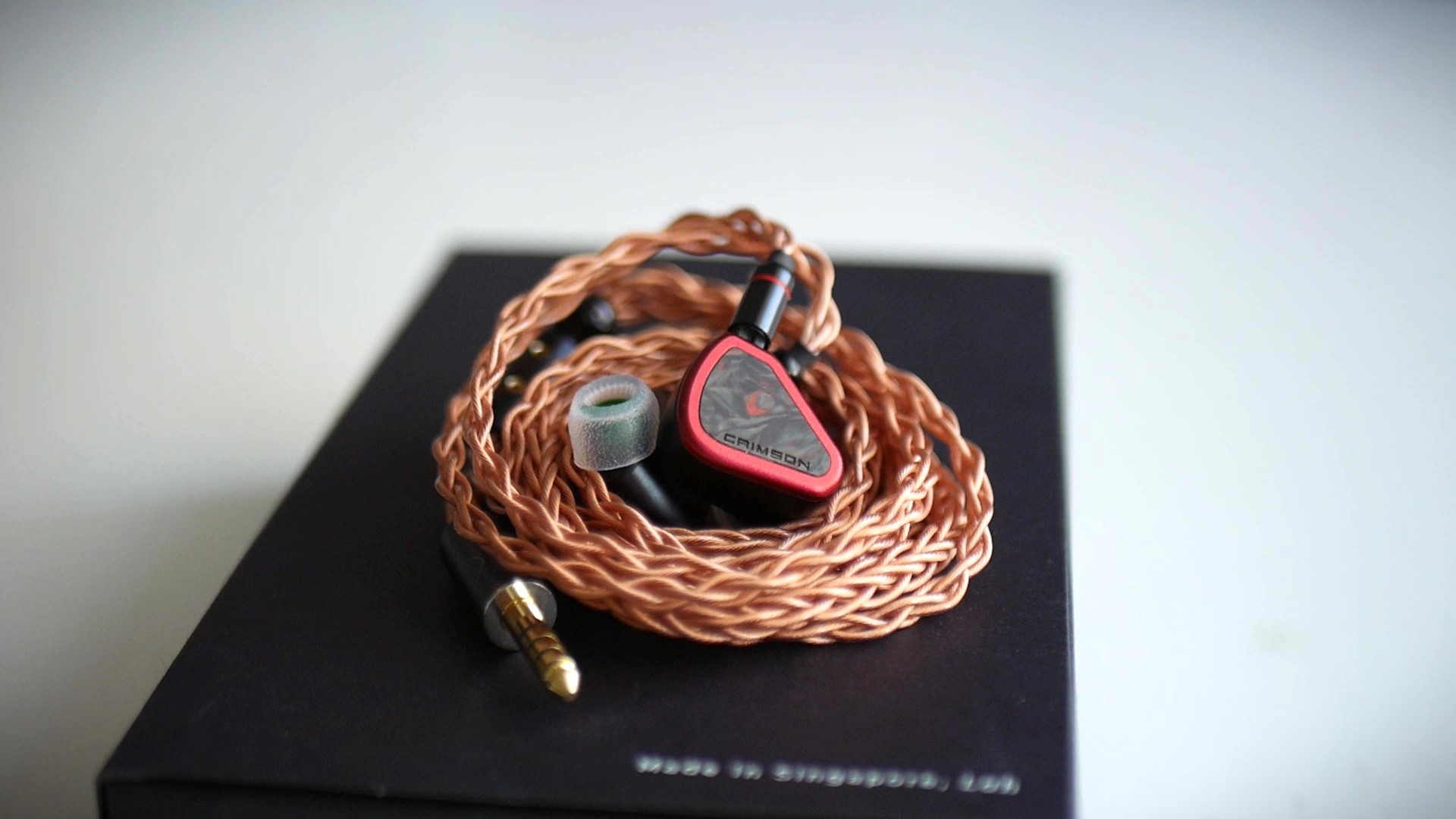
Upon switching to a good USB DAC (a.k.a., “dongles”) such as AFUL Snowy Night, two differences were immediately audible. Firstly, the bass becomes tight. Every bass kick in the Gladiator Suite has a snappy physical sensation somewhere in my throat, like a quick “jab” (no, it’s not as painful as it sounds). Simply put, the dynamic of Crimson is awaken: snappy, precise, and powerful. Secondly, the stage becomes noticeably more 3D. Now, there is not just left-to-right placement of instruments on a flat plane. I can easily hear the layering of different elements in the mix from closer to further away. The micro details of each instruments are also much easier appreciated as they are not blurred into each other like with the Apple dongle.
How far can we “scale”? For this test, I connected Crimson to my desktop DAC/amp combo FiiO K7, which can push up to 2000mW into a 32ohm load at 1% distortion. Yes, Crimson does sound better, particularly in terms of how large the soundstage be projected. Take the beautiful passage at around 2:06 in the Gladiator Suite Part 3 as an example. Whilst Snowy Night does a good job, the K7 does a better job, as if a “wall” that confines the outermost layer of the stage where the choral section sits was broken. The difference here is without a doubt a “refinement” rather than “correction” like the difference between Apple dongle and Snowy Night. However, it is substantial and consistent enough for me to report in this review.
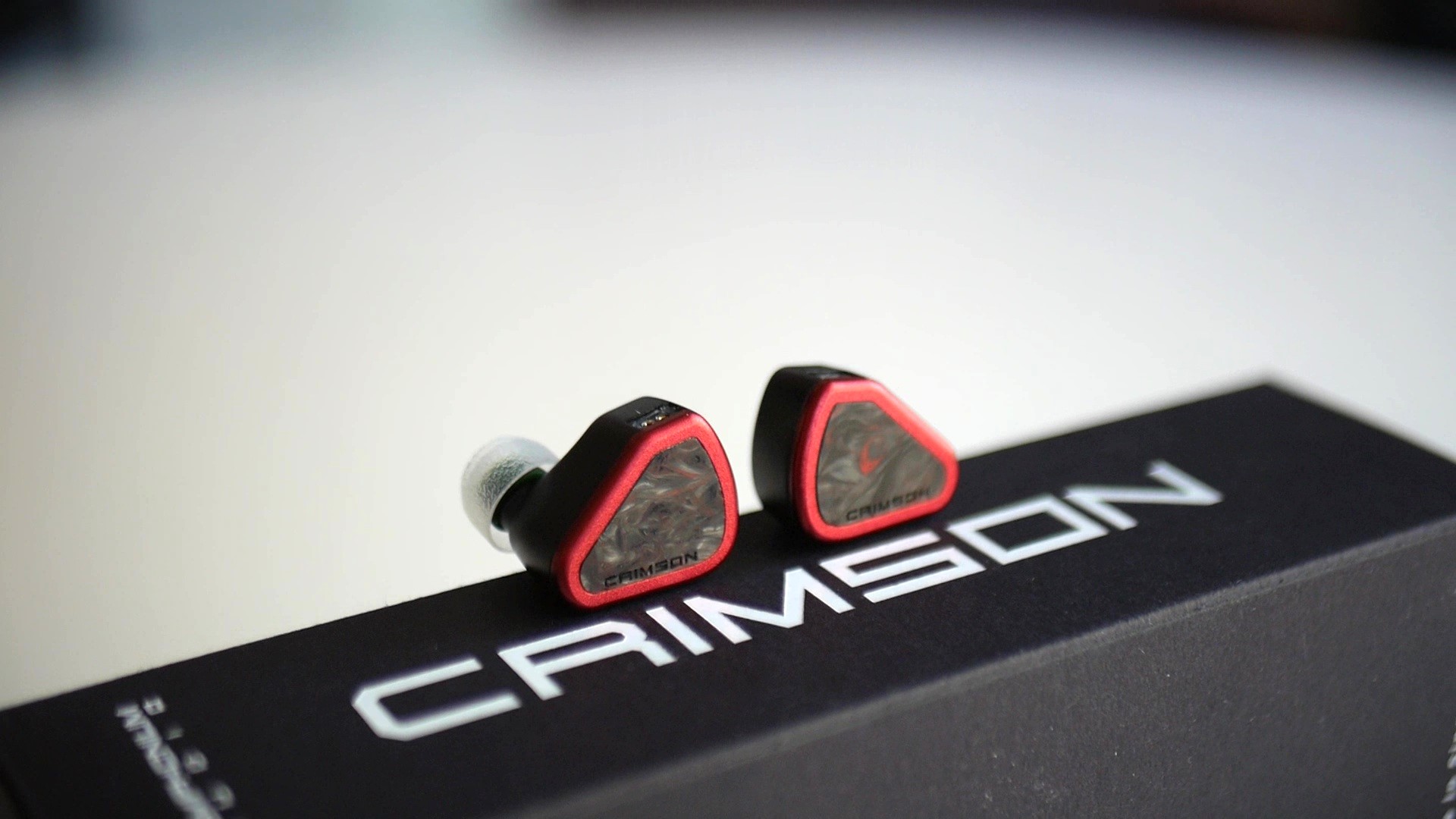
How about Digital Audio Player (DAP)? For this test, I rely on my iBasso DX300, an older TOTL DAP with four CS43198 (two more than the Snowy Night) and an amplifier that can deliver 1240mW into 32ohm load. The result was not unexpected. I heard an almost identical staging performance to that of K7, though the DX300 reveals some micro details that are much harder to hear on K7. Moving down to more modest DAPs like my trusty HiBy R3II reveals a “scaling down” in performance to roughly the level of a good dongle.
Before we move on, I would like to emphasise how revealing Crimson can be. For example, when I was going through my test tracks, there was a recording with clarinet and saxophone where I can hear details down to the air vibrating the reeds before and after the notes. It was unmistakably there when I listened with my DX300. Yet, even when I turn the volume way higher, I cannot hear those details with my K7. Does a bit micro details matter? Maybe not. But I was surprised when I hear the difference.
It means, to my ears, the midrange of Crimson is simply open and transparent. There is no additional warmth to add any “analogue glow” to make voices and instruments more pleasing. Crimson also does not pull back the upper midrange, so voices are placed upfront and intimate if the mix demands so. At the same time, Crimson does not have that “forced clarity” expressed by some IEMs with strong upper midrange emphasis, such as my Effect Audio Gaea. Perhaps, the best way to describe the midrange of Crimson is “disappearing.” Is it a good thing? To me, definitely.
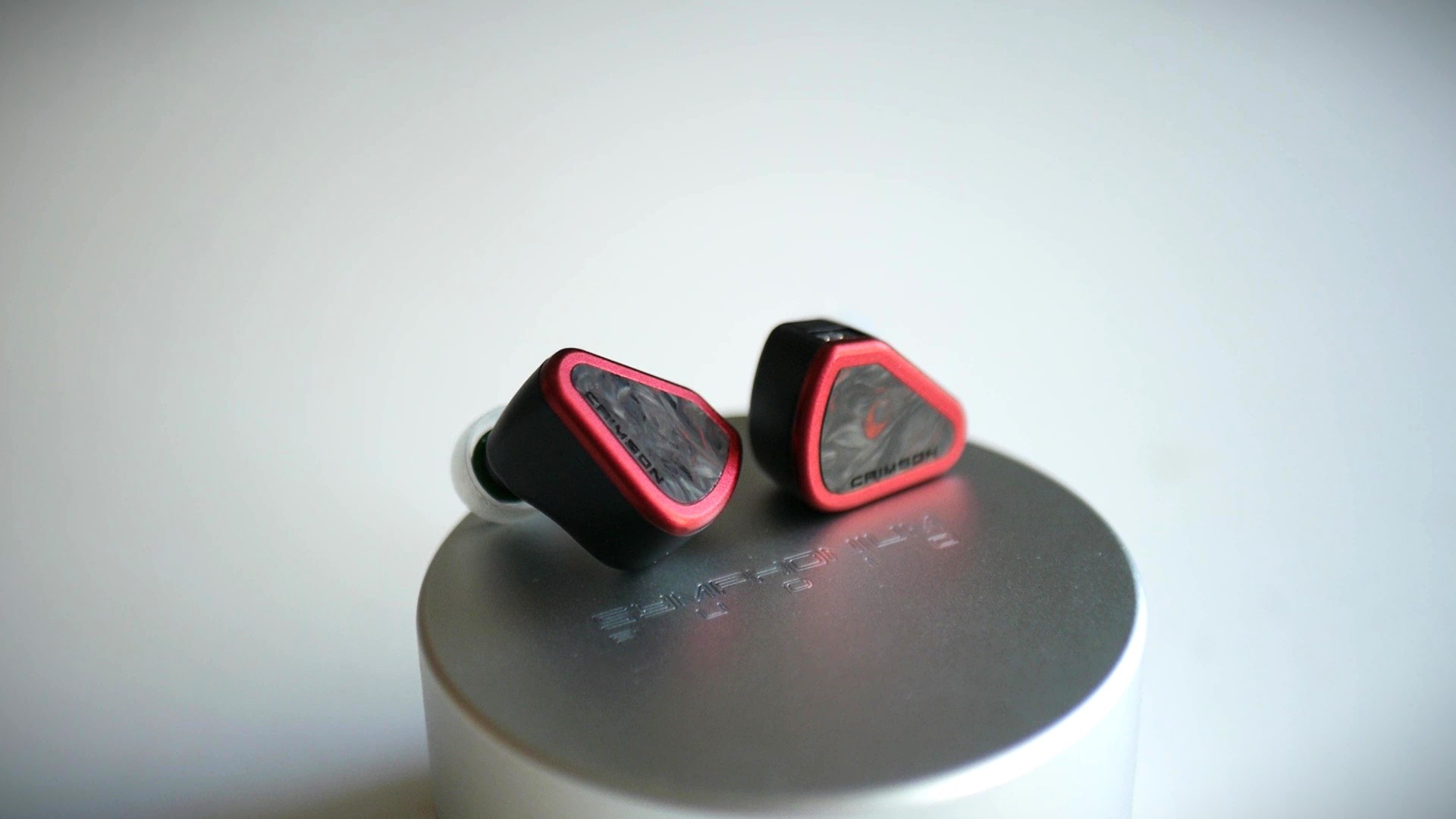
The neutral midrange is flanked by a strong bass shelf and an extended treble. Crimson maintains the clean bass shelf that focuses in the subbass, meaning this IEM can rumble. Fortunately, the dip in the midbass region (a.k.a., the bass punches), one of the most divisive design decision of Helios, was removed. As a result, the bass of Crimson is no longer kinda-odd-and-hollow like Helios. The amount of bass is also quite indulgent. With that being said, the bass response of Crimson is tight. The bass attacks feel snappy like whip cracks rather than big pillowy POOF like some IEMs with dynamic drivers, or even some 64 Audio IEMs like U12T.
The treble is where Crimson shines. But before we discuss treble further, I can’t emphasis enough the need to explore different ear tips to get these IEMs fit correctly. If the length of the tube from drivers to ear drums becomes too long (i.e., the IEMs hanging outside the ears), unpleasant treble harshness would appear.
When the fit is right, I can hear a smooth, well extended, and detailed treble response. High pitched instruments such as cymbals and hats are present yet not emphasised above the midrange, such as the singer and guitars. The stick impact of cymbals and hats are cleanly articulated. The body of the sound of cymbals and hats are full and nuanced, rather than simply splashes of high pitched noises. The decay of these instruments are extended and fully resolved until they disappear below the audible threshold, rather than being dropped off abruptly.
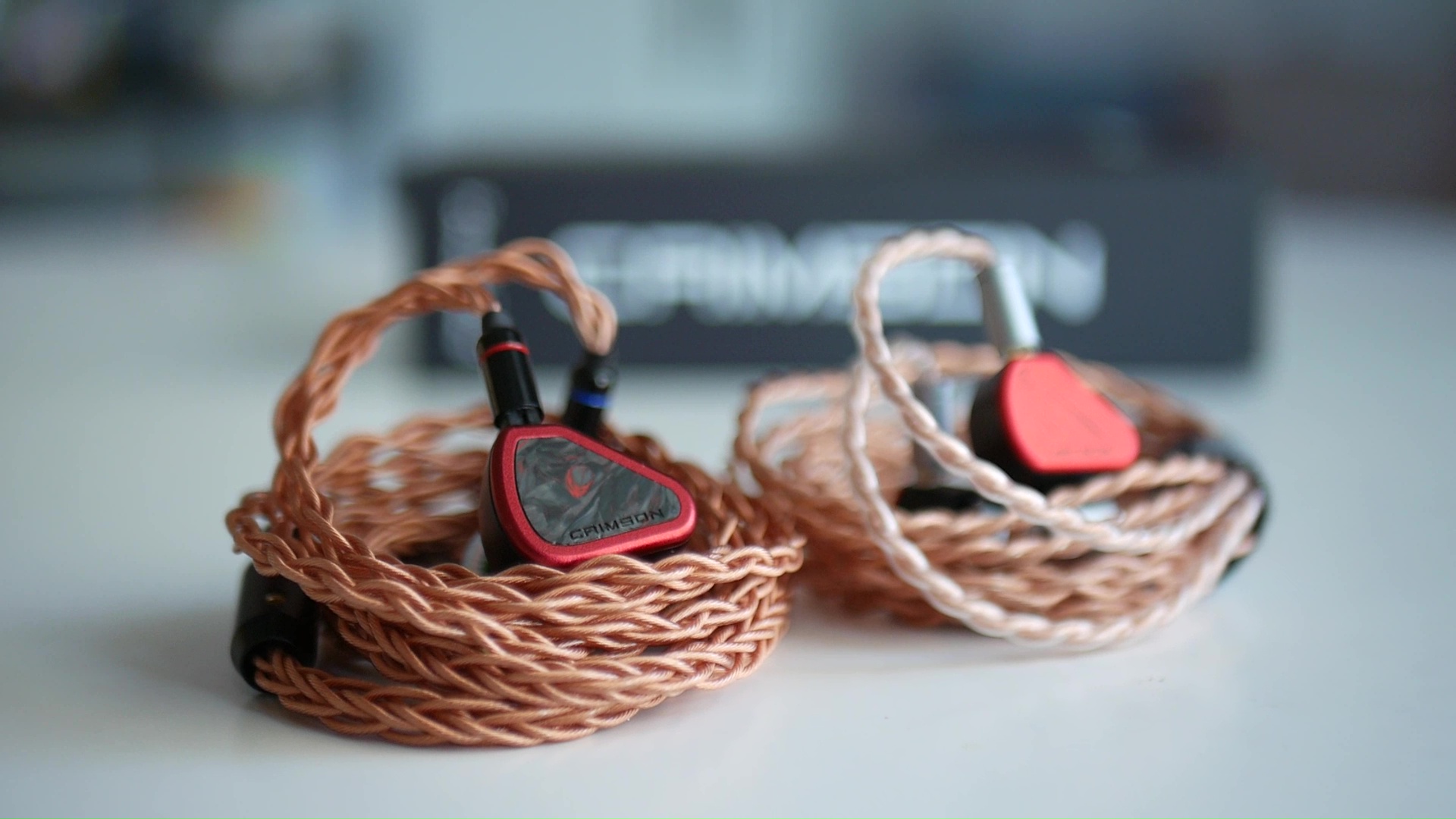
Another advantage of Crimson’s excellent treble extension is the ability to reveal micro details. For instance, when I listen to And the Waltz Goes On performed by Andre Rieu and his orchestra, I can hear much more details from the opening phrase of the saxophone, down the to the sound of the air going through the reed before and after a note. The reverberation in Bach: Goldberg Variations, BWV 988: Aria recording by Lang Lang is fully audible, crisp, and clear. Don’t get me wrong, the excellent detail retrieval is not just to brag that “I can hear the reed vibrating, can you?” That little bit of extra details is available to every elements in every recording, lending orchestral and live recording a palpable “realness.”
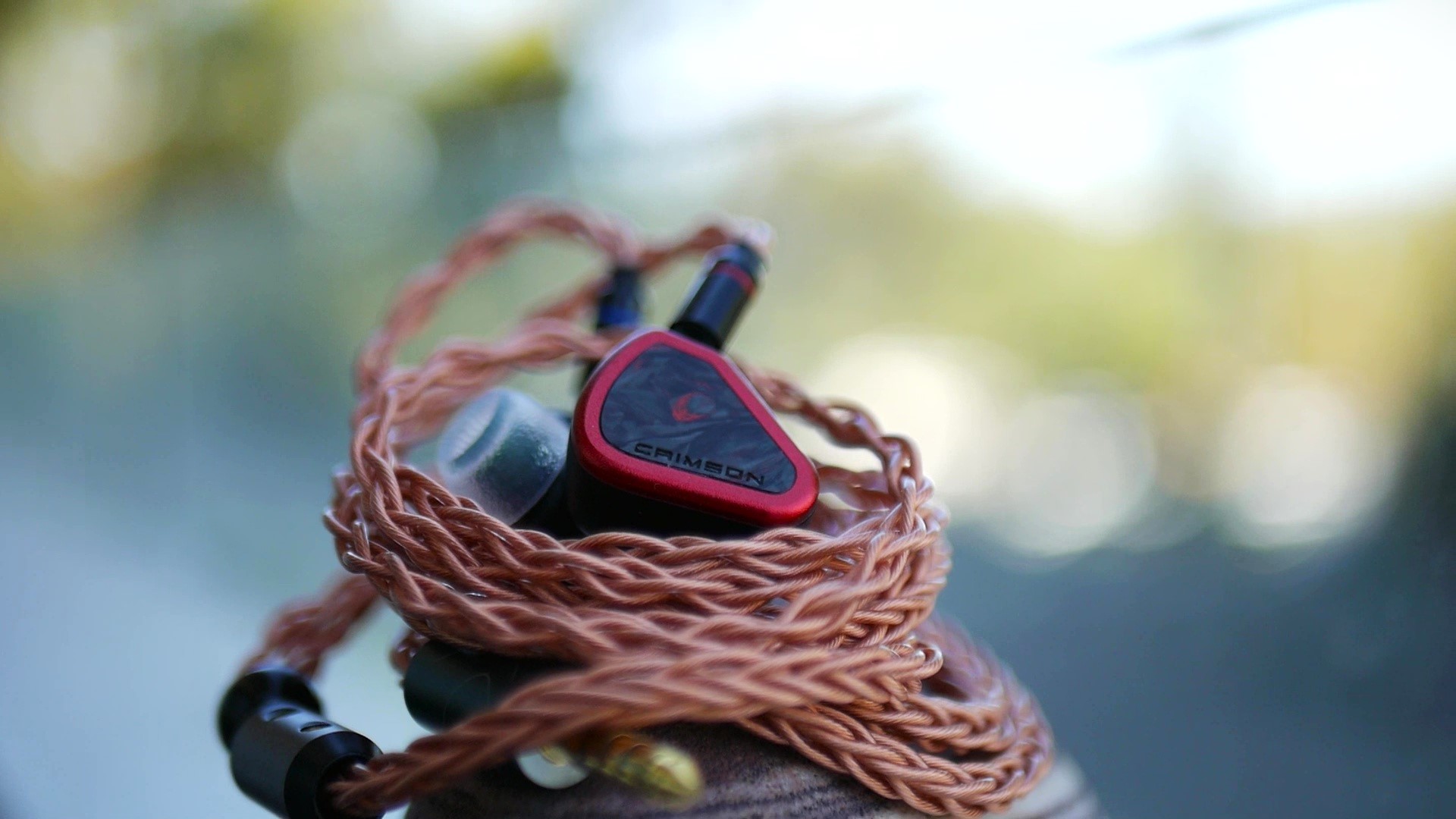
Excellent treble extension combined with careful channel matching together one of the biggest strengths of Crimson: soundstage imaging. If the sonic image is supposed to be large, misty and diffused like the opening of A Way of Life - The Last Samurai, Crimson can convey that. At the same time, it can pin point the direction and distance of the string that appears at around 1:17, like shining spot over the foggy misty ambience. Switching to Final Mission - Quantum Burst by Kenji Kawai, I hear a fully filled sound scape with different elements occupying their precise location, both left-to-right and near-to-far. The bass is upfront and centered. The strings are on the left but their reverb can smoothly pan to the right channel. The choral section around 0:54 seems to float higher up on the stage. The brass seems to be on the front-left, further away, behind the strings. Around 1:15, trumpets pop up close to the right ears. Around 3:00 the male choir comes in on the front-right, sounding distant and further into the background, contrasting against the busy foreground. I can go on and on. At this point, it’s my ability to note down the impressions and the resolvability of my source chain that create bottleneck, rather than the IEM itself.
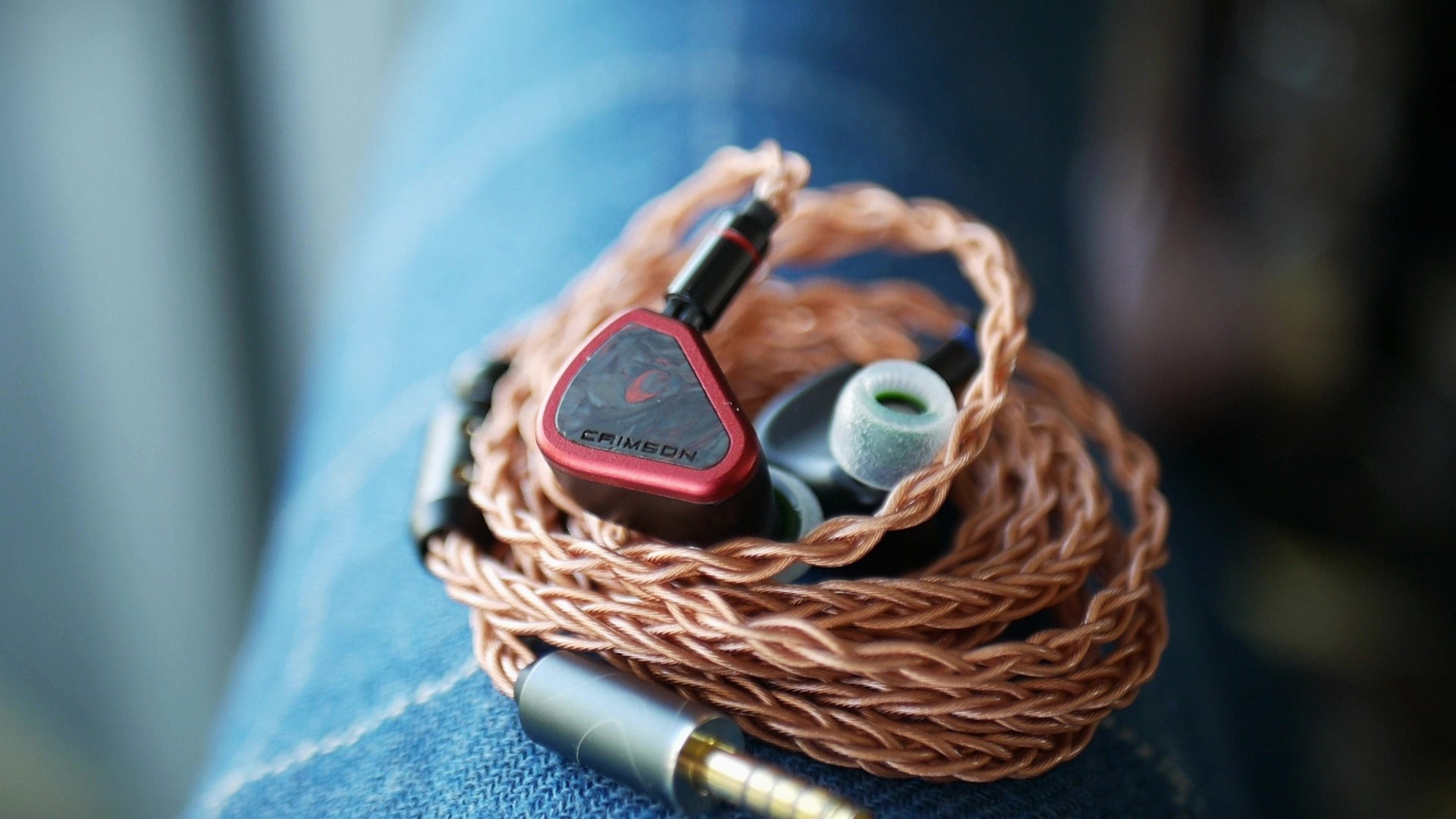
FPS gaming is where the ability to reproduce spatial cues of Crimson truly shines. For example, CS-GO Gameplay by Throneful shows a large and spherical stage, making it easy to discern the distance of gunshots from all directions. When the sound comes from the sides, at times I feel like they come from outside the ears, around the shoulders. Still, most of the time the sound does not get out of the head stage, like most IEMs.
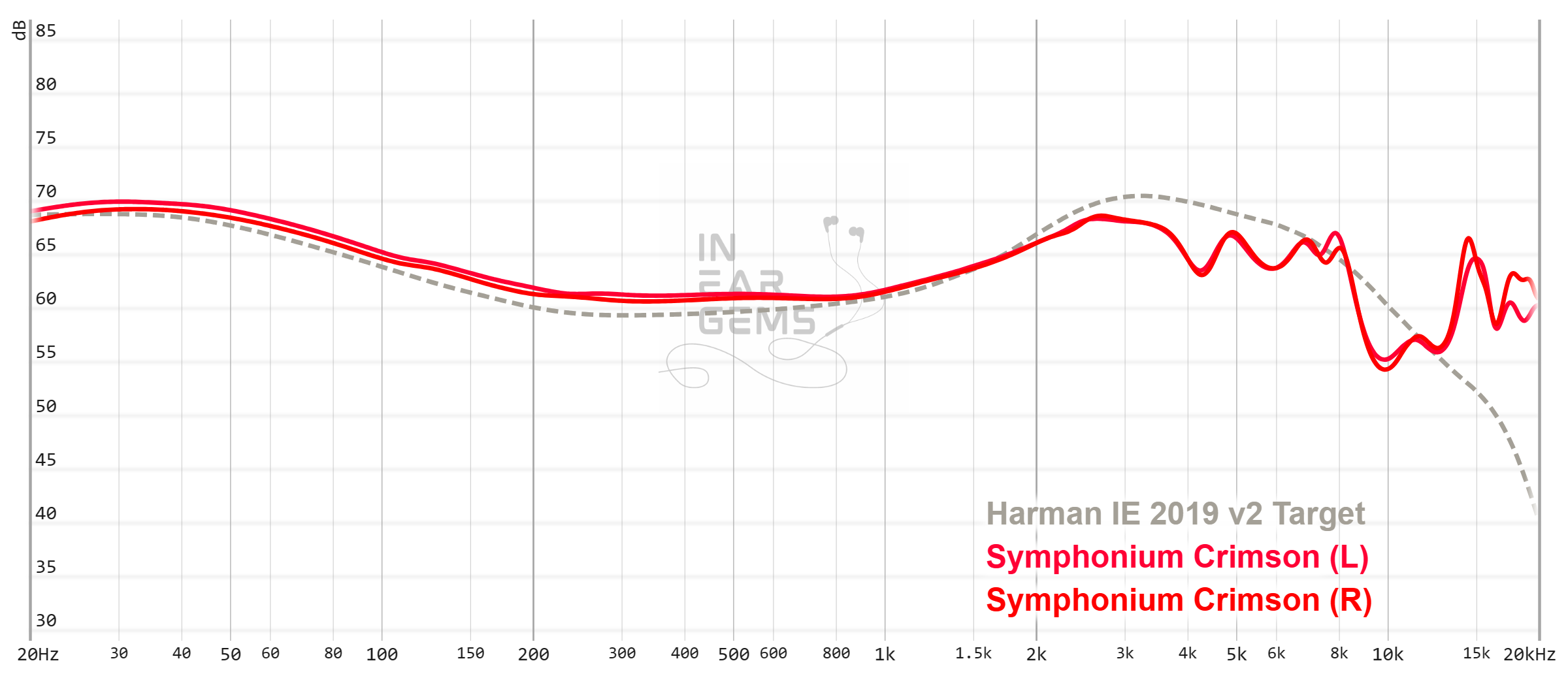
It is helpful to think of an IEM as a filter that highlights or subdues different parts of the incoming audio signal. This effect can be measured objectively by the squiggly lines above, called Frequency Response (FR) graphs, which measure how loud an IEM is at different frequencies from 20Hz (bass) to 20kHz (upper treble). Subjectivity is how your ears and brain interpret the effect of that filter on your music and decide whether it is “enjoyable.” There are some “rules of thumb” when it comes to tonality, but most interesting IEMs usually bend the rules masterfully.
The frequency response of Crimson brings a lot of joy to my inner geek. It roughly follows the Harman target where it makes sense, but make sensible adjustments where the target becomes questionable:
The dip around 250Hz that “detaches” the bass from the midrange and makes the bass impact mysteriously disappear in some recordings, a noted problem some “full Harman” IEMs and the Helios, was completely fixed. The bass shelf of Crimson glides down from 32Hz to join the midrange smoothly the midrange at 250Hz.
The midrange frequencies between 250Hz and 1kHz is ruler-flat. The upper midrange of Crimson shares the same tuning decision as that of Helios. In particular, Symphonium diverges from the Harman target at around 2.5kHz and keeps the response around 3dB lower than the target all across the upper midrange and lower treble region, mitigating the shrill and harshness that the target carries. Interestingly, the combination of a ruler-flat midrange and the milder upper midrange also ensures that Crimson does not sound unnaturally lean or bright.
It just works.
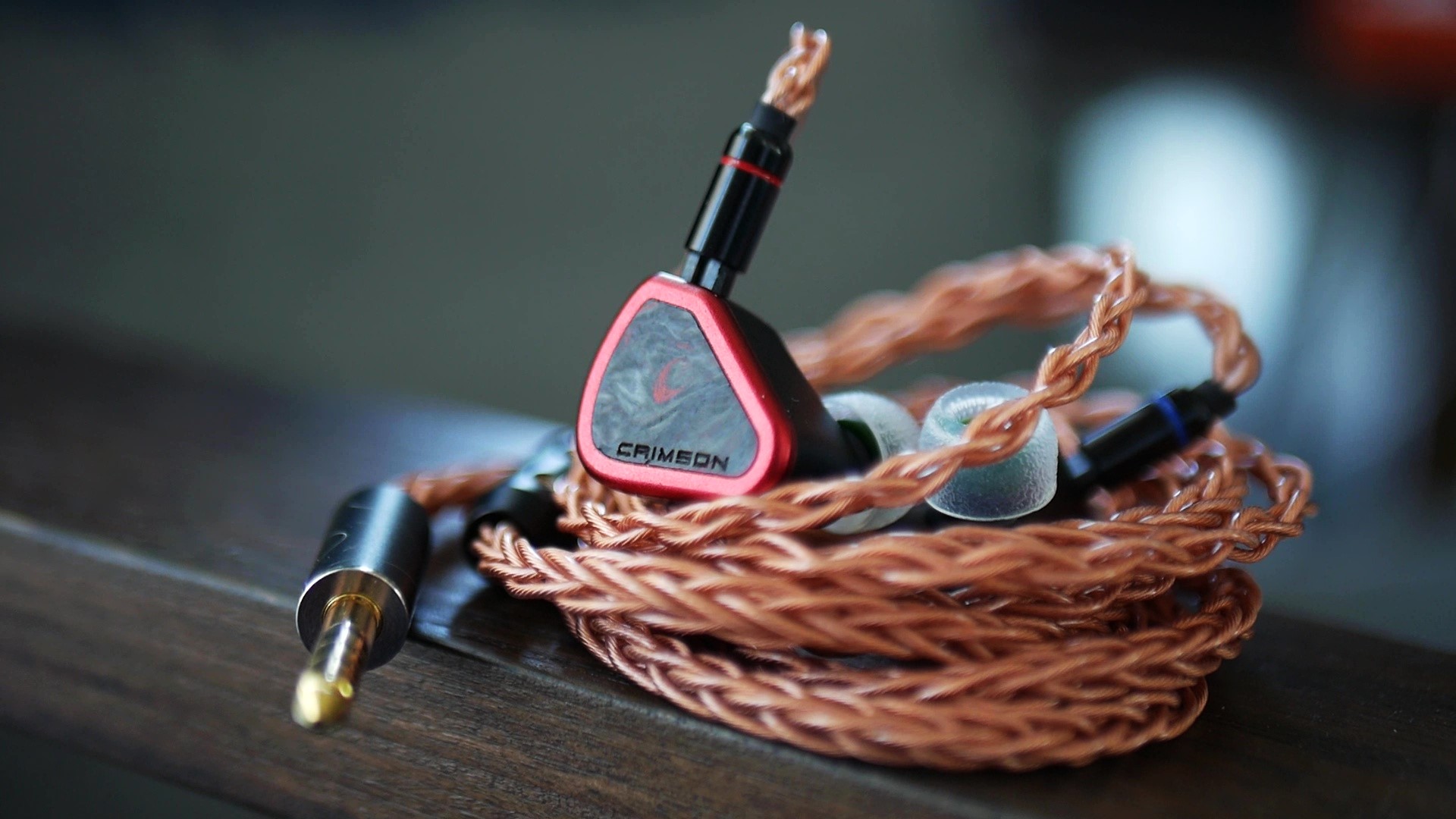
The high frequencies are where the confidence of my frequency response measurement drops because (1) anything above 8kHz is likely not 100% correct and (2) how one wears the IEM can introduce significant variations in this region. When I compare my measurement of Crimson with the official graph of Symphonium, I found that all the peaks and dips are roughly the same, but my valley at between 10kHz and 12kHz is at least 3dB more extreme.
Regardless of the graph, Crimson has excellent treble extension, helping it to localise the sound precisely on the soundstage and resolves details down to the minutes that my DAC and amp can reveal. And what is nice is that Crimson does not have a peak somewhere around 12kHz like my U12T that can be fatiguing in some recording. To ensure the best treble extension and minimize the risk of treble peaks, I would use wide bore tips and wear the IEM as deep as I can.

Resolution is a fascinating subject due to the difficulty of pinning down what it really is. To me, “resolution” can be broken down into three components: (1) Sharpness, incisiveness, or “definition” of note attacks (see the figure above). (2) The separation of instruments and vocals, especially when they overlap on the soundstage. (3) The texture and details in the decay side of the notes. The first two give music clarity and make it easy to track individual elements of a mix. The last provides music details and nuances. Smooth and well extended treble response plays a crucial role.
If I were to describe the resolving ability of Crimson in one word, it would be “effortless.” Given a well produced recording, Crimson makes it easy for me to hear everything. Instruments have precise boundary and strong clarity, likely due to the proper energy in the upper midrange. Micro details are there. If a recording was mixed with reverberation, I would be able to hear it clearly.
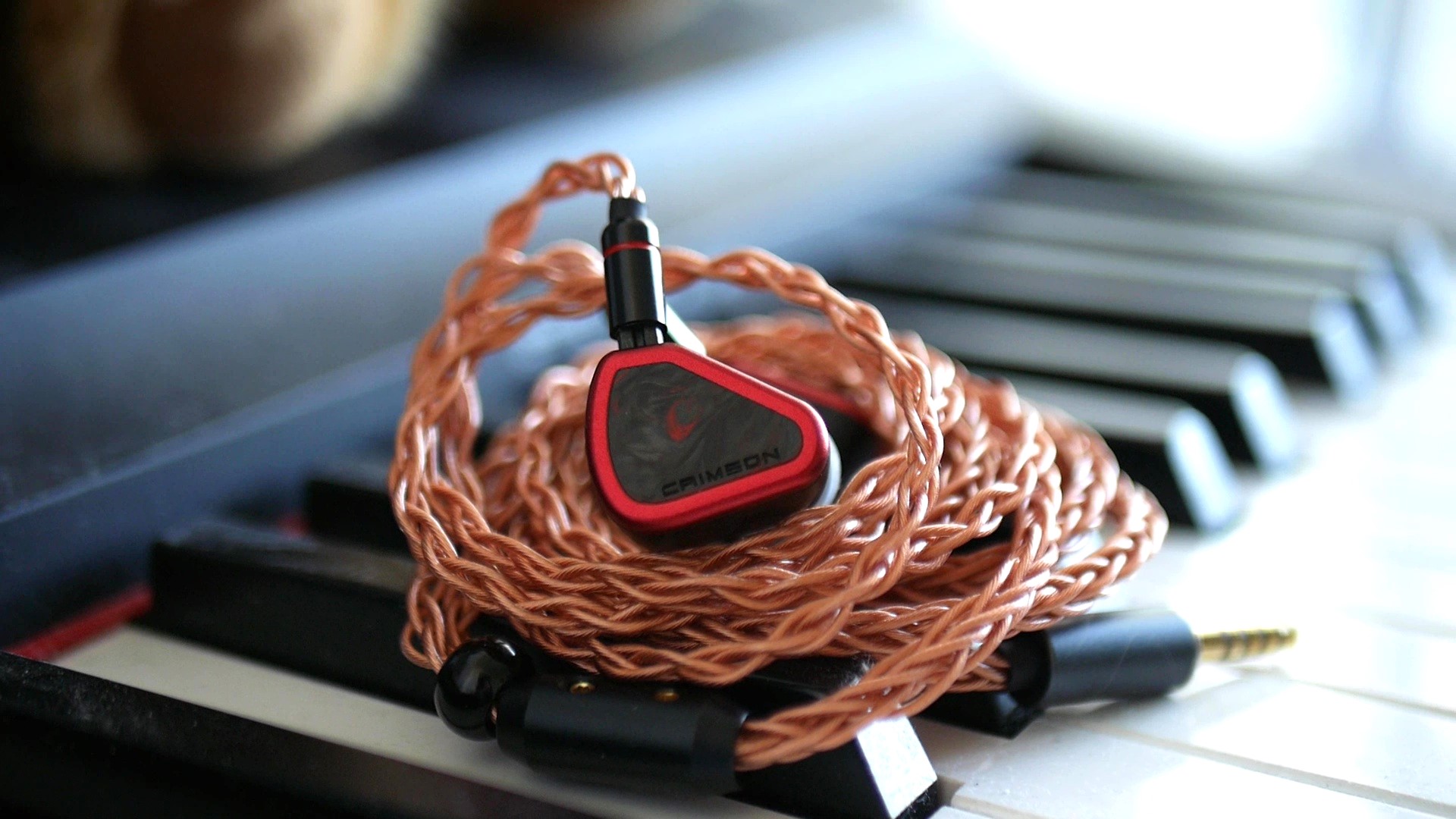
So, we know that Crimson is resolving. But how resolving?
For this test, I’m pitching it against my trusty U12T and Gaea. The most interesting observation, to me, was the contrast between the naturally detailed presentation of Crimson and U12T against the “forced clarity” of Gaea. For example, when I listen to A Way of Life - The Last Samurai, instead of a misty and somewhat distant presentation (at times), the way Gaea presents this recording reminds me of a photo that has been processed with the exposure and clarity sliders cranked up. Everything is brighter, more upfront, and indeed clearer, but not quite “right.” But I digress, let’s go back to Crimson. The Symphonium IEM has the brightness that sits between U12T and Gaea. Despite not pushing everything forward, Crimson shows more nuances and details, especially in the decay end of the notes comparing to Gaea. The Crimson and U12T trade blows on everything, from separation, instrument placement, to micro details.

Stereo imaging or “soundstage” is a psychoacoustic illusion that different recording elements appear at various locations inside and around your head. Your brain creates based on the cues in the recording, which are enhanced or diminushed by your IEMs, your DAC, and your amplifier. Some IEMs present a wide but flat soundstage. Some present a “3D” soundstage with layering, depth, and height. In rare cases, with some specific songs, some IEMs can trick you into thinking that the sound comes from the environment (a.k.a., “holographic”)
Crimson has the ability to project a large and 3D soundstage with good width, depth, and height, if such information is embedded in the recording. The strength of this IEM lies in precision. As I mentioned earlier, thanks to the treble extension, with the right recording, the instruments can have such “realness”, as if they are 3D blobs in space that I can mentally reach out and grab them.
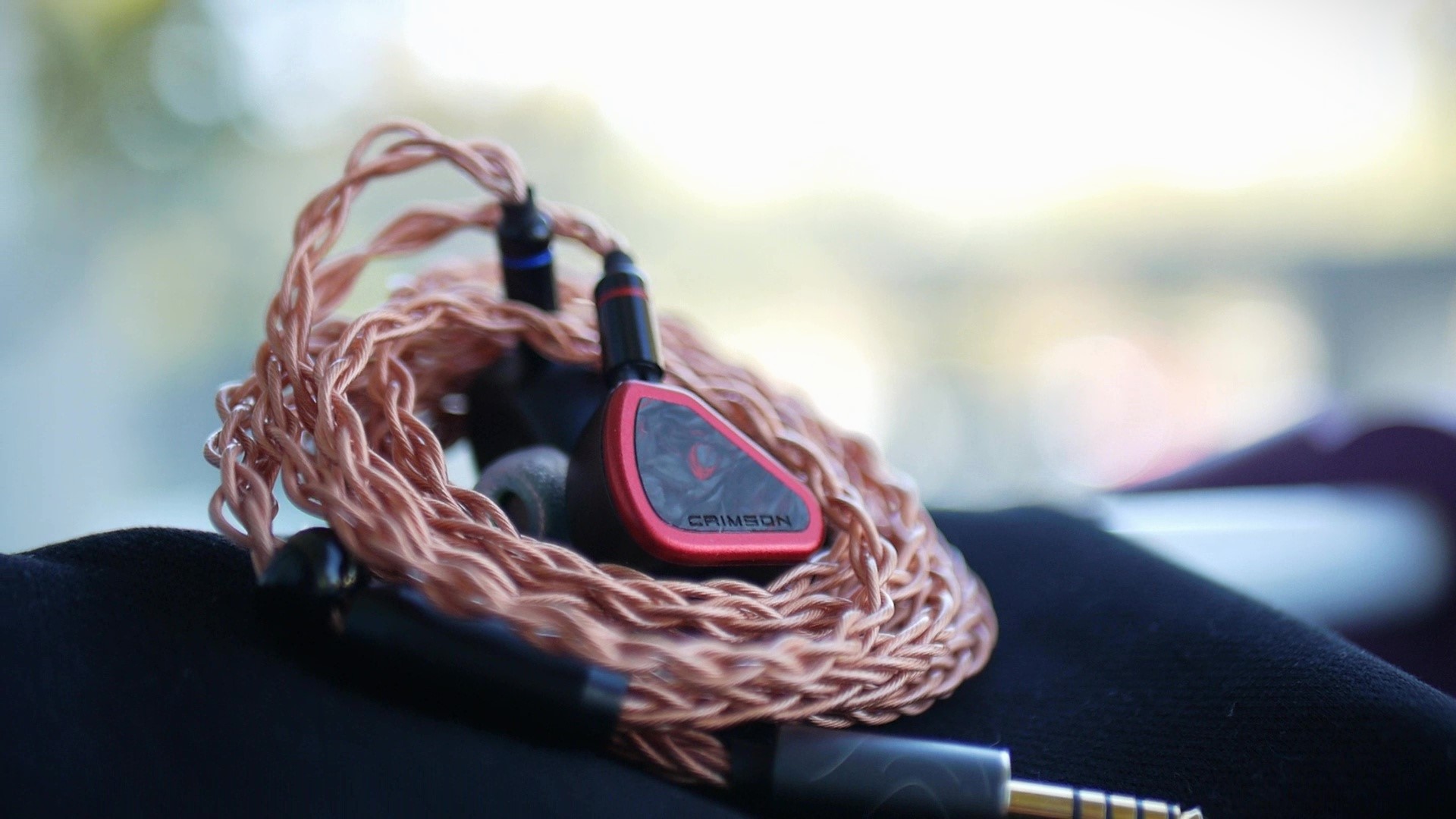
Still, I need to control the expectation here: Crimson is an IEM. Having a “large soundstage” does not mean that it would sound like listening to a pair of floor speakers in a living room. It also rarely makes a sphere of sound around the head like a pair of open back headphone. Instead, the virtual picture of the sound painted inside the head feels larger and more 3D than other IEMs and sometimes, in rare cases, can break the head stage to create the illusion that sound comes from the room. If you approach Crimson, or any IEM for that matter, with the expectation of speakers or headphones, you would find whatever soundstage these IEMs project negligible. If you approach from an IEM perspective, the stage here is quite impressive.
How good, you might ask?
I would say the overall expansion of the stage is identical to my trusty U12T. However, the distribution of instruments on the stage is different. The U12T has more density at the middle of the stage, whilst the Crimson distributes the instruments more evenly.

I also had the pleasure to compare the Crimson against the Noble Audio Spartacus, a cutting edge 6-driver IEM with 2 Sonion bone conductors. Again, I hear a similar expansion of the stage, but Spartacus has even more density at the middle of the stage than U12T, giving it a focused presentation. At the same time, possibly thanks to the bone conduction drivers, or (more likely) some treble emphasis around 8kHz region, this IEM can push some elements in the mix way higher than both Crimson and U12T, as if they come from above my ears.
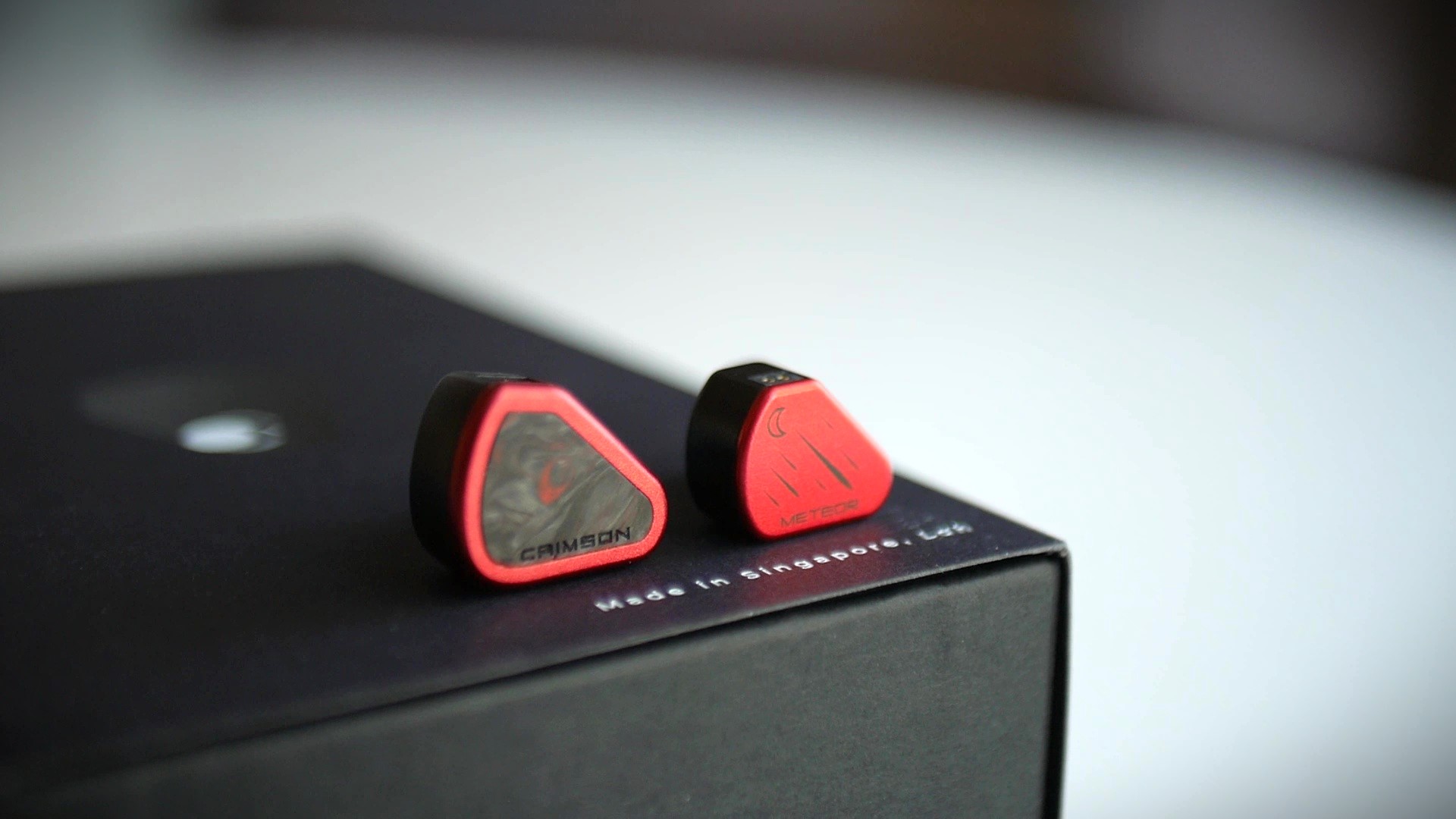
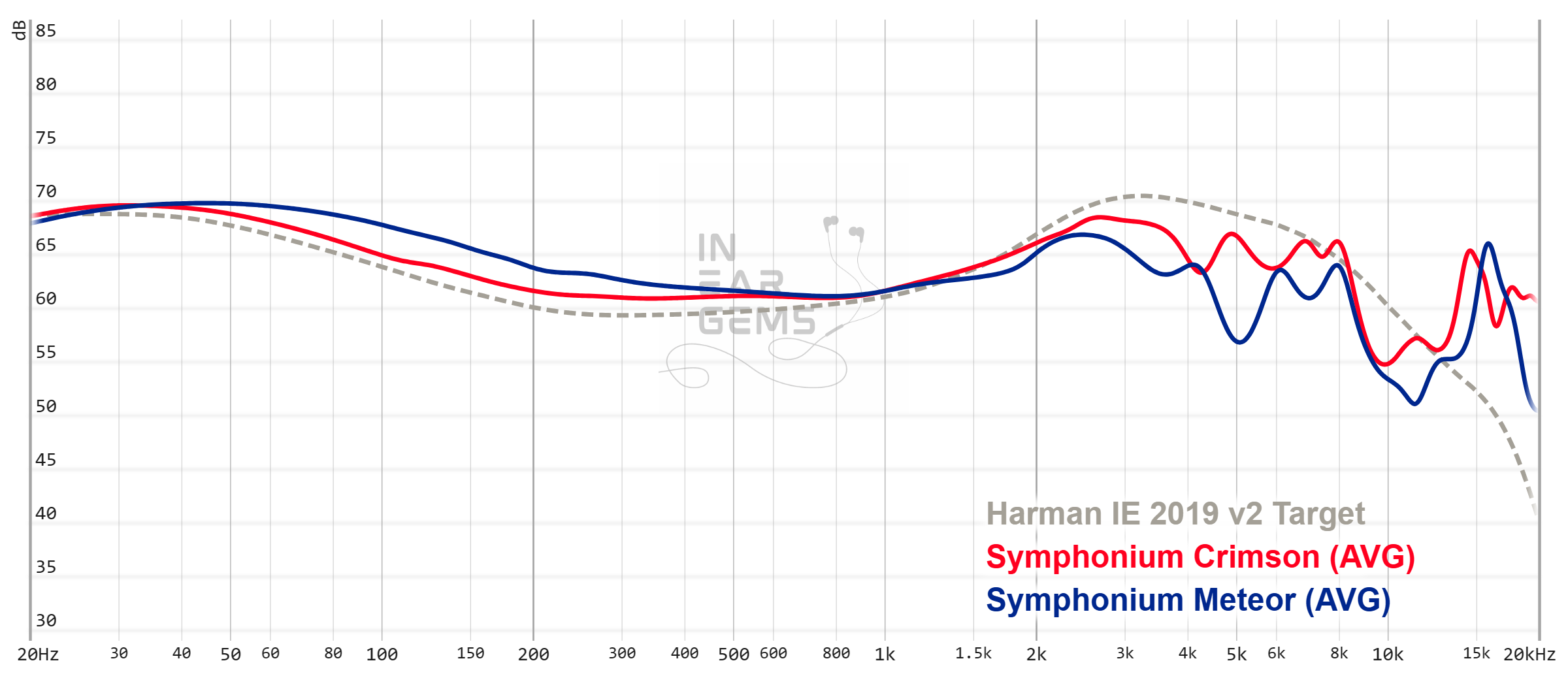
Vs Symphonium Meteor: 4 drivers vs 4 drivers. PHAT vs PHAT. Symphonium vs Symphonium. These IEMs have more similarity than what one might expected. Both have excellent treble extension that brings a “special effect” to the way they project stereo images. Both have surprisingly great bass despite using BA woofers. Both have great dynamic (loudness swings) However, Meteor has a slightly warmer midrange whilst Crimson is more transparent. The bass punch of Meteor also that “poofy”, rounded attacks that can feel as if there is air being pushed. Meanwhile, Crimson’s bass is snappy. The clarity and separation of Meteor is also a few step behind Crimson.
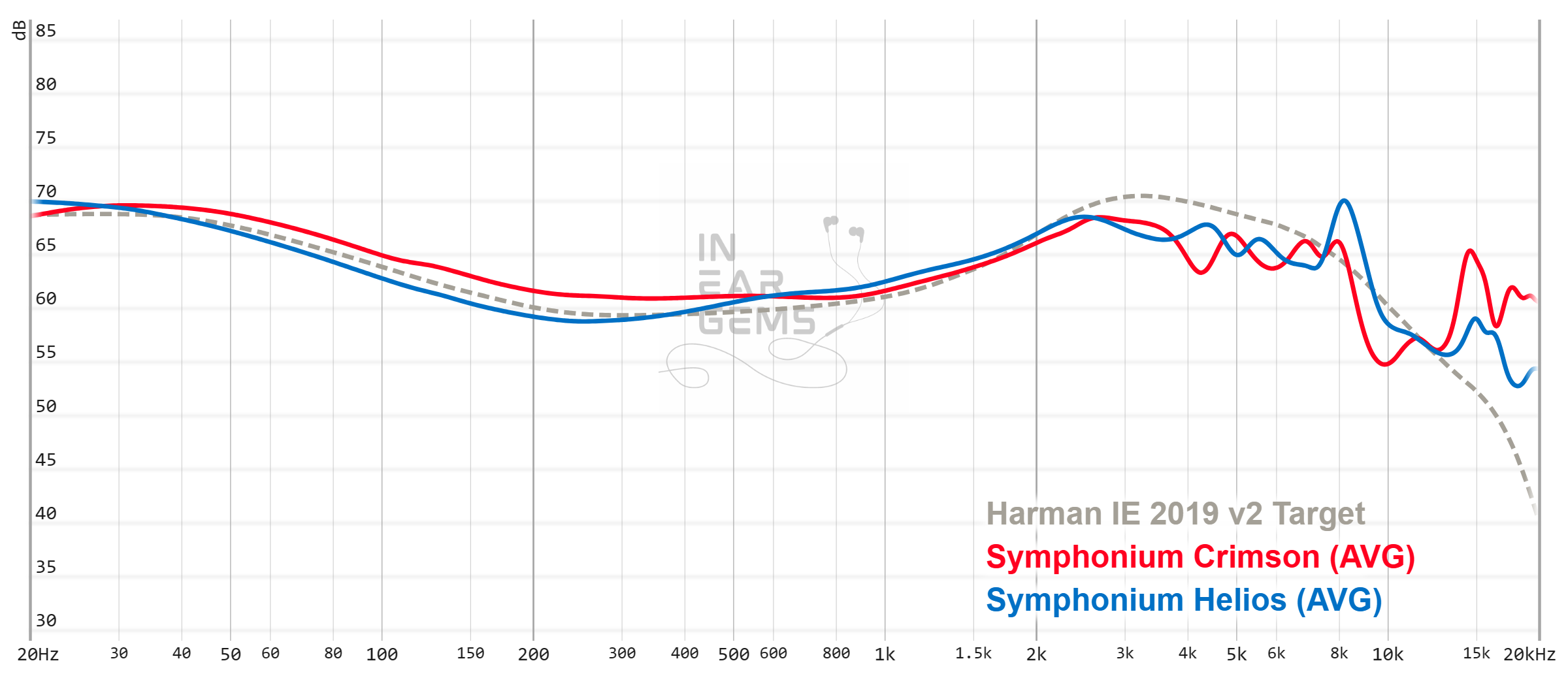
Vs Symphonium Helios (from memory): The most noticeable differences between these IEMs are tonal balance and fit. Thanks to the shorter nozzle, Crimson is much easier to wear and much more comfortable than Helios. Tonality of Crimson is also easier to enjoy than Helios, at least to me, thanks to the removal of the dip at 250Hz. Resolution, particularly detail retrieval and separation, was another clear advantage of Crimson. Whilst Helios’ resolution can match or surpass some strong kilobuck performers, it fell a bit short in A/B tests against the likes of U12T. It’s no longer the case with Crimson.
Vs Noble Audio Spartacus: The tonality of Crimson and Spartacus are quite different from each other. Crimson’s midrange is all about neutrality, transparency, and openness. The midrange of Spartacus is thick, warm, and densely focused in the lower region. The bass of Crimson focuses on subbass energy and snappy attacks. The bass of Spartacus is more about thick, puffy midbass punch. Due to the tuning choice, Crimson and Spartacus present the soundstage quite differently. With Spartacus, all the energy of the stage and distribution of instruments focus thickly around the center. The Crimson has a more even distribution across a sphere. However, the Spartacus can convey an uncanny sense of height, which is unmatched by both Crimson and U12T. Resolution-wise, the difference between these high performers are quite small.
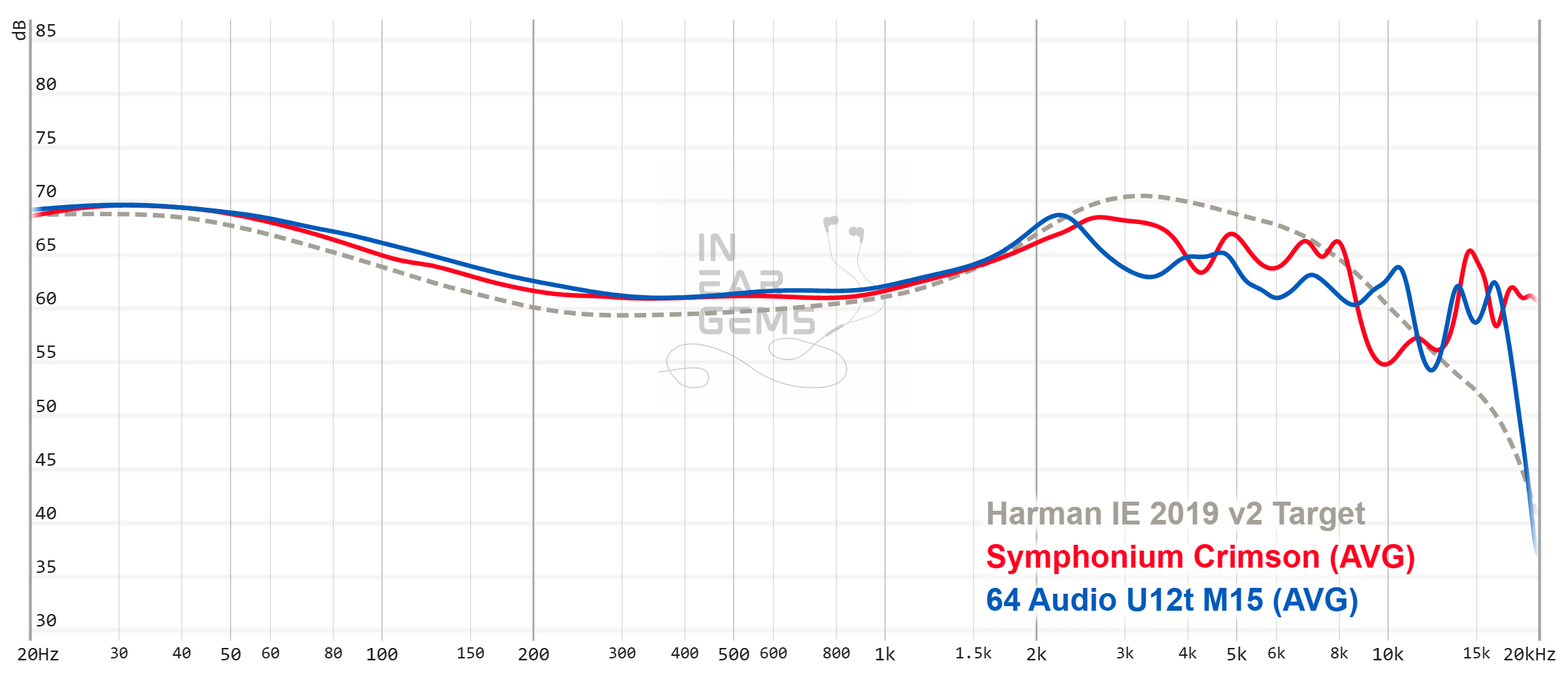
Vs U12T: To me, Crimson is a more energetic U12T. The bass of U12T is more rounded and rich, whilst the bass of Crimson is snappy. Both have enough subbass to convey a physical sensation. The upper midrange of Crimson is more emphasised, making vocals more forward with stronger clarity. The upper midrange of U12T has a dip around 3kHz, making vocals more easy going and more likely to break the head stage to appear somewhat in front of me. The stereo imaging capability and resolution of these IEMs are mostly identical. I would reach for either depending on the mood. Though when I play games with my handheld consoles, I would use U12T because it is much easier to drive.

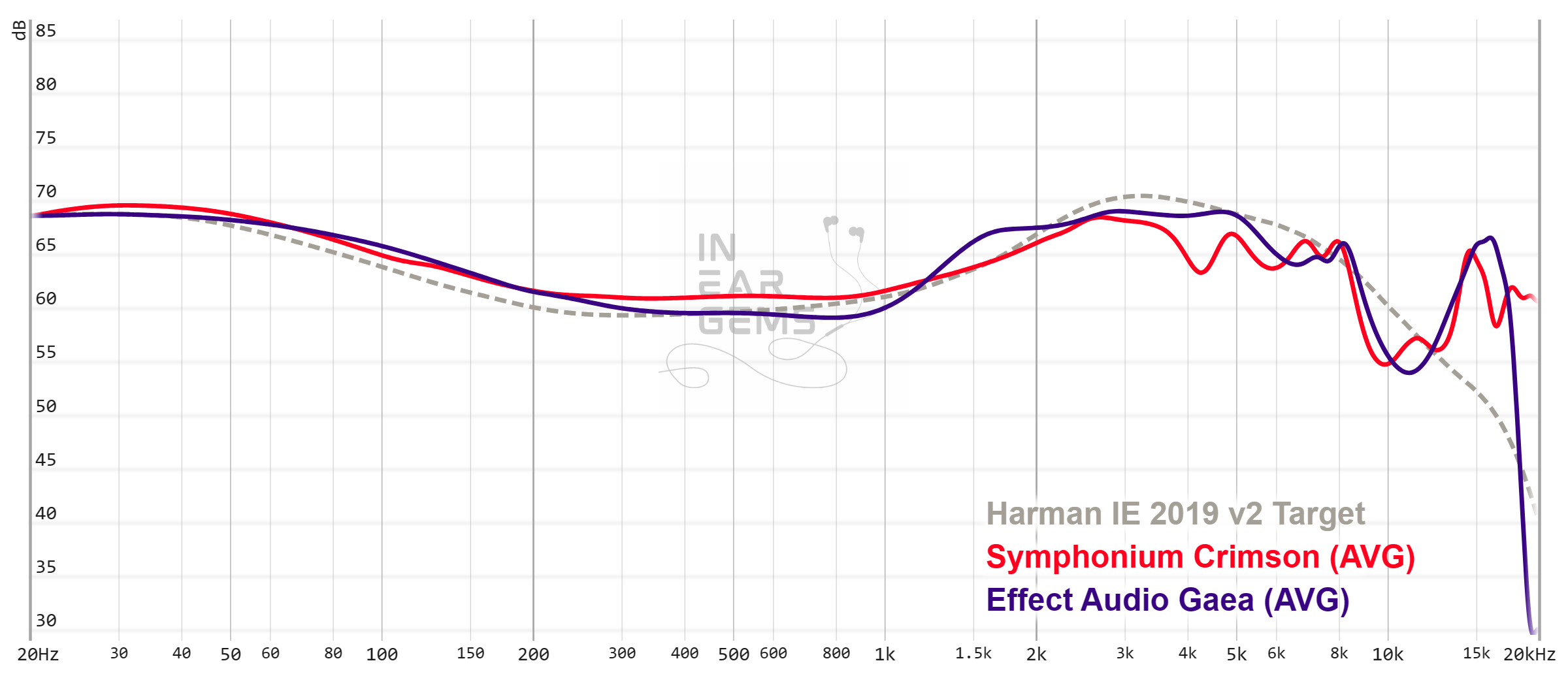
Vs Effect Audio Gaea: Whilst Crimson might feel bright on its own, it sounds quite ordinary next to the Gaea. Simply put, the tonality of Crimson is smack dab in the middle of “neutral” midrange, whilst Gaea stretches the boundary of upper midrange and lower treble, as if Elysian try to see how far they can increase the perceived clarity until the tonality becomes compromised and stop just before that happens. Regarding the resolution, I find that the Crimson does a better job, though at this high-end level, the gap is quite small. Regarding soundstage imaging, I find that the Gaea pushes the center of the soundstage where most actions happen more up-front, making the stage feels somewhat shallower than Crimson. Regarding macro dynamic, the ability to convey explosive volume swings that make music exciting, Crimson and Gaea trade blows.

So, what’s is the conclusion about Crimson? As usual, “it depends.”
If you want your music to be smooth and mellow with big, slow, enveloping bass, or if you primarily to music that is already energetic and edgy, perhaps Crimson would be too much for you.
However, if your idealisation of the “perfect” sound is the one with tack sharp instrument placement, snappy transient response, plenty of details, and a balanced U-shaped sound signature, if you listen to a lot of large orchestral music and soundtracks, then the answer is simple. Crimson is perhaps the closest to that “perfect” sound as it gets, without jumping into the abyss also known as “Top of the Line.”
What I like about this IEM:
Bias Score: 5/5 - I love this IEM!
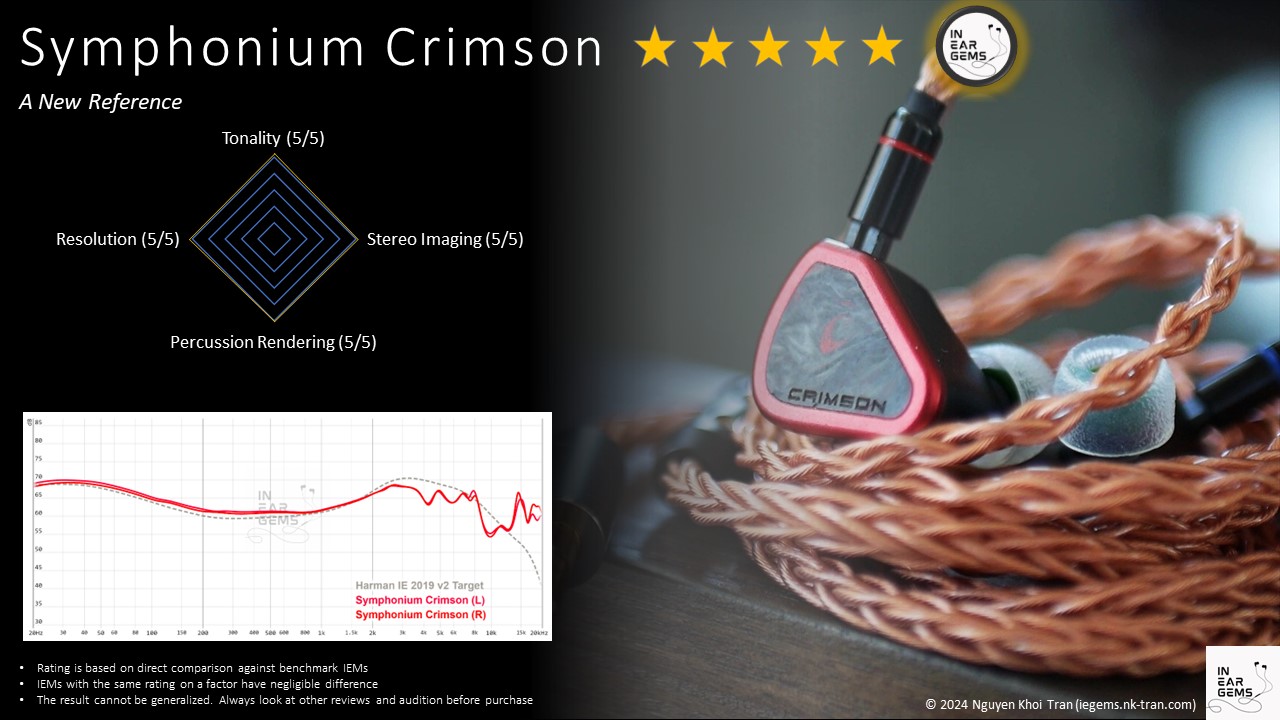
Updated: April 8, 2024
Classically beautiful. That’s how I think about a new wave of IEM boutiques run by young teams with a strong engineering background and a good taste of aural experiences. A while ago, I have had the pleasure to test and write about Helios from Symphonium, a Singaporean IEM manufacturers whose pride is engineering excellence. In the following months, inspired by my experience with Helios, I added its budget-friendly sibling, the Meteor, to my small collection. Yet, despite all their merits, these IEMs have not fully resonated with me.
Now, Symphonium is back for the third round with their current flagship, the Crimson. Is this finally the one? Read on to find out, my friends.

Forewords
- What I look for in an IEM is immersion. I want to feel the orchestra around my head, track individual instruments, and hear all of their textures and details. I’m not picky about tonality, as long as it is not make the orchestra, violin, cellos, and pianos sound wrong.
- I rate IEMs within with a consistent scale from 1 (Poor) to 3 (Good) to 5 (Outstanding). An overall ranking of 3/5 or above is considered positive.
- Ranking list and measurement database are on my IEM review blog.
- Terms used in my reviews are consistent with the glossary by Headphonesty
- This review is possible thanks to the Australian tour arranged by Symphonium and @Damz87 (Thank you!). I have no affiliation with or financial interest in Symphonium.
- The unit retails for $1499 (stock cable) and $1699 (upgraded 8-wire cable) at the time this review was published. Unaffiliated link: https://www.symphoniumaudio.com/products/crimson?variant=41361632788531
General Information
As of early 2024, Crimson is the flagship IEM of Symphonium, the best that they can offer.Like most Symphonium IEMs, Crimson has four BA drivers and a complex crossover circuitry, all encased in a reversed tear-shape metal shells.
4 BA drivers, you ask?
Yes. Crimson has 4 BA drivers, just like Helios and Meteor before it. Yet, these IEMs sound quite different in both tuning and technical performance.
Some familiar technologies from Helios and Meteor make a return with Crimson:
- TrueX 4-way Crossover: fancy techy way of saying that the crossover circuit of Crimson splits the incoming signal into 4 parts to feed 4 drivers, ensuring that drivers contribute energy within their optimal range with minimal overlapping. This technology first appeared in Helios. The Meteor uses a simpler version with only 3-way crossover.
- Featuring Filtered Linear Attenuation Tuning (FLAT): a fancy techy way to describe a circuit to ensure that the impedance curve of Crimson is linear. Whilst most IEMs with single dynamic driver has a flat impedance curve, multi-driver IEMs tend to have a lot of up and down between 20Hz and 20kHz, causing undesirable changes in frequency response with swapping between amplifiers with different output impedance. Similar technologies also appeared in 64 Audio IEM (LID circuitry), Fir Audio, FATFreq, and a few other manufacturers. Both Helios and Meteor have this technology.
- Phase Harmonic Attenuation Technology (PHAT): little details are available about this technology, besides the fact that it was developed to make the treble extension of Meteor possible. As far as I understand, this technique aims to reduce nozzle size by removing acoustic tubes whilst avoiding phase cancellations problems that ruin a smooth and extended treble response.
Before moving on, let’s quickly talk about packaging and accessories. Again, little has changed since Helios.



Crimson comes in a surprisingly small box and stored in a surprisingly small metal case. Inside the case, you can find the IEM itself and a cable of your choice.


My unit came with the upgraded 8-wire cable with interchangeable plug. Despite having 8 wires, the cable is supple and very well behaved. The thickness of the cable also matches the size of the earpieces.


At the bottom of the box, we can find a drawer that contains two types of quality ear tips (Azla SEDNA and Divinus Velvet) and and a warranty card with signature from Symphonium team members.
Physical Aspects


The earpieces of Crimson are encased in the same aluminium alloy material that was used by Helios. The size of the earpieces are also identical. However, Symphonium has made some adjustments to make the fit of Crimson much better than Helios. The most significant change was the reduction of nozzle length. No longer we have to tolerate long and thick nozzles to enjoy that sweet sweet treble extension.
The earpieces of Crimson are fully sealed. Therefore, depending on the type of ear tips that you use, there is a chance that you would encounter pressure build up (that stuffy, vacuum-sealed sensation in the ear canal that can be quite fatiguing). Fortunate for me, I did not encounter that problem during my tests. With either the medium Divinus Velvet ear tips supplied in the box or my own set of medium Sancai wide bore ear tips, the IEM seem to disappear in my ears even in longer listening sessions that last up to a few hours.
Because there is no dynamic driver inside Crimson, there has been no incidence of driver flex during my tests.
Ear tips recommendation: the choice of ear tips are very personal because our ears can be quite different. I found that Crimson sounds much better with short ear tips with wide opening. These tips allow me to minimize the length of the nozzles, which in turn smoothen the treble response. In fact, when I used the stock SEDNA ear tips, which extends the nozzles quite a bit and pushes the IEMs further away from my ear drums, I hear a noticeable treble peak that manifests in a high-pitch “hiss” at the top of higher vocals, cymbals, hats, and trumpets. This hiss and the corresponding harshness was gone when I switched to the Sancai ear tips.
Driveability

An IEM builder once told me that more complex crossover designs tend to make IEMs very difficult to drive. Crimson might be an example of this conjecture. With the impedance of 6.05ohm@1kHz and sensitivity of 106dB/Vrms@1kHz (83dB/mW@1kHz), Crimson is a very difficult IEM to drive indeed. You need an amplifier that can maintain stable current supply when facing large volume peaks (transients), especially when the peaks are in the bass region.
Usual disclaimer: when I say that an IEM is “difficult to drive”, it does not mean that I cannot get loud sound out of them from a weak amplifier. It means that that sound is noticeably more muffled, muddy, and more congested with these devices. In other words, a “difficult to drive” IEM does not sound very good without good amplification but can “scale” when paired with a stronger amplifier.
So, how difficult are we talking about?
The Apple’s USB-C to 3.5mm adapter (a.k.a., “Apple dongle” a.k.a., “all that you need”) at the maximum output can barely reach listenable volume when I listen to the album LIVE by Hans Zimmer. The bass is barely present. When a track forces the bass to appear, the bass lacks the crisp, snappy attacks and the texture is barely passable. Whilst the stage is properly wide, it feels 2D, lacking the near-to-far placement of instruments (depth and layering). Whilst it is not unlistenable, I can’t recommend this pairing unless you have nothing else on your hand. Interestingly, the Apple dongle got warm after a few songs.
Just for fun, I tried to drive Crimson with the headphone out of ASUS ROG Ally handheld gaming device. Again, the bass was weak and blurry. Interestingly, the sound started to distort at transient peaks in the music.

Upon switching to a good USB DAC (a.k.a., “dongles”) such as AFUL Snowy Night, two differences were immediately audible. Firstly, the bass becomes tight. Every bass kick in the Gladiator Suite has a snappy physical sensation somewhere in my throat, like a quick “jab” (no, it’s not as painful as it sounds). Simply put, the dynamic of Crimson is awaken: snappy, precise, and powerful. Secondly, the stage becomes noticeably more 3D. Now, there is not just left-to-right placement of instruments on a flat plane. I can easily hear the layering of different elements in the mix from closer to further away. The micro details of each instruments are also much easier appreciated as they are not blurred into each other like with the Apple dongle.
How far can we “scale”? For this test, I connected Crimson to my desktop DAC/amp combo FiiO K7, which can push up to 2000mW into a 32ohm load at 1% distortion. Yes, Crimson does sound better, particularly in terms of how large the soundstage be projected. Take the beautiful passage at around 2:06 in the Gladiator Suite Part 3 as an example. Whilst Snowy Night does a good job, the K7 does a better job, as if a “wall” that confines the outermost layer of the stage where the choral section sits was broken. The difference here is without a doubt a “refinement” rather than “correction” like the difference between Apple dongle and Snowy Night. However, it is substantial and consistent enough for me to report in this review.

How about Digital Audio Player (DAP)? For this test, I rely on my iBasso DX300, an older TOTL DAP with four CS43198 (two more than the Snowy Night) and an amplifier that can deliver 1240mW into 32ohm load. The result was not unexpected. I heard an almost identical staging performance to that of K7, though the DX300 reveals some micro details that are much harder to hear on K7. Moving down to more modest DAPs like my trusty HiBy R3II reveals a “scaling down” in performance to roughly the level of a good dongle.
Before we move on, I would like to emphasise how revealing Crimson can be. For example, when I was going through my test tracks, there was a recording with clarinet and saxophone where I can hear details down to the air vibrating the reeds before and after the notes. It was unmistakably there when I listened with my DX300. Yet, even when I turn the volume way higher, I cannot hear those details with my K7. Does a bit micro details matter? Maybe not. But I was surprised when I hear the difference.
Subjective Experience
Testing setup:- Sources: FiiO K7, AFUL Snowy Night, iBasso DX300
- Cable: stock 8-wire cable, 4.4mm connector
- Ear tips: Tangzu Sancai Wide Bore (Medium)
It means, to my ears, the midrange of Crimson is simply open and transparent. There is no additional warmth to add any “analogue glow” to make voices and instruments more pleasing. Crimson also does not pull back the upper midrange, so voices are placed upfront and intimate if the mix demands so. At the same time, Crimson does not have that “forced clarity” expressed by some IEMs with strong upper midrange emphasis, such as my Effect Audio Gaea. Perhaps, the best way to describe the midrange of Crimson is “disappearing.” Is it a good thing? To me, definitely.

The neutral midrange is flanked by a strong bass shelf and an extended treble. Crimson maintains the clean bass shelf that focuses in the subbass, meaning this IEM can rumble. Fortunately, the dip in the midbass region (a.k.a., the bass punches), one of the most divisive design decision of Helios, was removed. As a result, the bass of Crimson is no longer kinda-odd-and-hollow like Helios. The amount of bass is also quite indulgent. With that being said, the bass response of Crimson is tight. The bass attacks feel snappy like whip cracks rather than big pillowy POOF like some IEMs with dynamic drivers, or even some 64 Audio IEMs like U12T.
The treble is where Crimson shines. But before we discuss treble further, I can’t emphasis enough the need to explore different ear tips to get these IEMs fit correctly. If the length of the tube from drivers to ear drums becomes too long (i.e., the IEMs hanging outside the ears), unpleasant treble harshness would appear.
When the fit is right, I can hear a smooth, well extended, and detailed treble response. High pitched instruments such as cymbals and hats are present yet not emphasised above the midrange, such as the singer and guitars. The stick impact of cymbals and hats are cleanly articulated. The body of the sound of cymbals and hats are full and nuanced, rather than simply splashes of high pitched noises. The decay of these instruments are extended and fully resolved until they disappear below the audible threshold, rather than being dropped off abruptly.

Another advantage of Crimson’s excellent treble extension is the ability to reveal micro details. For instance, when I listen to And the Waltz Goes On performed by Andre Rieu and his orchestra, I can hear much more details from the opening phrase of the saxophone, down the to the sound of the air going through the reed before and after a note. The reverberation in Bach: Goldberg Variations, BWV 988: Aria recording by Lang Lang is fully audible, crisp, and clear. Don’t get me wrong, the excellent detail retrieval is not just to brag that “I can hear the reed vibrating, can you?” That little bit of extra details is available to every elements in every recording, lending orchestral and live recording a palpable “realness.”

Excellent treble extension combined with careful channel matching together one of the biggest strengths of Crimson: soundstage imaging. If the sonic image is supposed to be large, misty and diffused like the opening of A Way of Life - The Last Samurai, Crimson can convey that. At the same time, it can pin point the direction and distance of the string that appears at around 1:17, like shining spot over the foggy misty ambience. Switching to Final Mission - Quantum Burst by Kenji Kawai, I hear a fully filled sound scape with different elements occupying their precise location, both left-to-right and near-to-far. The bass is upfront and centered. The strings are on the left but their reverb can smoothly pan to the right channel. The choral section around 0:54 seems to float higher up on the stage. The brass seems to be on the front-left, further away, behind the strings. Around 1:15, trumpets pop up close to the right ears. Around 3:00 the male choir comes in on the front-right, sounding distant and further into the background, contrasting against the busy foreground. I can go on and on. At this point, it’s my ability to note down the impressions and the resolvability of my source chain that create bottleneck, rather than the IEM itself.

FPS gaming is where the ability to reproduce spatial cues of Crimson truly shines. For example, CS-GO Gameplay by Throneful shows a large and spherical stage, making it easy to discern the distance of gunshots from all directions. When the sound comes from the sides, at times I feel like they come from outside the ears, around the shoulders. Still, most of the time the sound does not get out of the head stage, like most IEMs.
Frequency Response Analysis
Frequency response of Crimson against Helios and the Harman in-ear target. Measurements were done with an IEC-711-compliant coupler and might only be compared with other measurements from this same coupler. Above 8kHz, the measurement might not be correct. Visit my graph database for more comparisons.
It is helpful to think of an IEM as a filter that highlights or subdues different parts of the incoming audio signal. This effect can be measured objectively by the squiggly lines above, called Frequency Response (FR) graphs, which measure how loud an IEM is at different frequencies from 20Hz (bass) to 20kHz (upper treble). Subjectivity is how your ears and brain interpret the effect of that filter on your music and decide whether it is “enjoyable.” There are some “rules of thumb” when it comes to tonality, but most interesting IEMs usually bend the rules masterfully.
The frequency response of Crimson brings a lot of joy to my inner geek. It roughly follows the Harman target where it makes sense, but make sensible adjustments where the target becomes questionable:
The dip around 250Hz that “detaches” the bass from the midrange and makes the bass impact mysteriously disappear in some recordings, a noted problem some “full Harman” IEMs and the Helios, was completely fixed. The bass shelf of Crimson glides down from 32Hz to join the midrange smoothly the midrange at 250Hz.
The midrange frequencies between 250Hz and 1kHz is ruler-flat. The upper midrange of Crimson shares the same tuning decision as that of Helios. In particular, Symphonium diverges from the Harman target at around 2.5kHz and keeps the response around 3dB lower than the target all across the upper midrange and lower treble region, mitigating the shrill and harshness that the target carries. Interestingly, the combination of a ruler-flat midrange and the milder upper midrange also ensures that Crimson does not sound unnaturally lean or bright.
It just works.

The high frequencies are where the confidence of my frequency response measurement drops because (1) anything above 8kHz is likely not 100% correct and (2) how one wears the IEM can introduce significant variations in this region. When I compare my measurement of Crimson with the official graph of Symphonium, I found that all the peaks and dips are roughly the same, but my valley at between 10kHz and 12kHz is at least 3dB more extreme.
Regardless of the graph, Crimson has excellent treble extension, helping it to localise the sound precisely on the soundstage and resolves details down to the minutes that my DAC and amp can reveal. And what is nice is that Crimson does not have a peak somewhere around 12kHz like my U12T that can be fatiguing in some recording. To ensure the best treble extension and minimize the risk of treble peaks, I would use wide bore tips and wear the IEM as deep as I can.
ResolutionPermalink

Resolution is a fascinating subject due to the difficulty of pinning down what it really is. To me, “resolution” can be broken down into three components: (1) Sharpness, incisiveness, or “definition” of note attacks (see the figure above). (2) The separation of instruments and vocals, especially when they overlap on the soundstage. (3) The texture and details in the decay side of the notes. The first two give music clarity and make it easy to track individual elements of a mix. The last provides music details and nuances. Smooth and well extended treble response plays a crucial role.
If I were to describe the resolving ability of Crimson in one word, it would be “effortless.” Given a well produced recording, Crimson makes it easy for me to hear everything. Instruments have precise boundary and strong clarity, likely due to the proper energy in the upper midrange. Micro details are there. If a recording was mixed with reverberation, I would be able to hear it clearly.

So, we know that Crimson is resolving. But how resolving?
For this test, I’m pitching it against my trusty U12T and Gaea. The most interesting observation, to me, was the contrast between the naturally detailed presentation of Crimson and U12T against the “forced clarity” of Gaea. For example, when I listen to A Way of Life - The Last Samurai, instead of a misty and somewhat distant presentation (at times), the way Gaea presents this recording reminds me of a photo that has been processed with the exposure and clarity sliders cranked up. Everything is brighter, more upfront, and indeed clearer, but not quite “right.” But I digress, let’s go back to Crimson. The Symphonium IEM has the brightness that sits between U12T and Gaea. Despite not pushing everything forward, Crimson shows more nuances and details, especially in the decay end of the notes comparing to Gaea. The Crimson and U12T trade blows on everything, from separation, instrument placement, to micro details.
Soundstage Imaging

Stereo imaging or “soundstage” is a psychoacoustic illusion that different recording elements appear at various locations inside and around your head. Your brain creates based on the cues in the recording, which are enhanced or diminushed by your IEMs, your DAC, and your amplifier. Some IEMs present a wide but flat soundstage. Some present a “3D” soundstage with layering, depth, and height. In rare cases, with some specific songs, some IEMs can trick you into thinking that the sound comes from the environment (a.k.a., “holographic”)
Crimson has the ability to project a large and 3D soundstage with good width, depth, and height, if such information is embedded in the recording. The strength of this IEM lies in precision. As I mentioned earlier, thanks to the treble extension, with the right recording, the instruments can have such “realness”, as if they are 3D blobs in space that I can mentally reach out and grab them.

Still, I need to control the expectation here: Crimson is an IEM. Having a “large soundstage” does not mean that it would sound like listening to a pair of floor speakers in a living room. It also rarely makes a sphere of sound around the head like a pair of open back headphone. Instead, the virtual picture of the sound painted inside the head feels larger and more 3D than other IEMs and sometimes, in rare cases, can break the head stage to create the illusion that sound comes from the room. If you approach Crimson, or any IEM for that matter, with the expectation of speakers or headphones, you would find whatever soundstage these IEMs project negligible. If you approach from an IEM perspective, the stage here is quite impressive.
How good, you might ask?
I would say the overall expansion of the stage is identical to my trusty U12T. However, the distribution of instruments on the stage is different. The U12T has more density at the middle of the stage, whilst the Crimson distributes the instruments more evenly.

I also had the pleasure to compare the Crimson against the Noble Audio Spartacus, a cutting edge 6-driver IEM with 2 Sonion bone conductors. Again, I hear a similar expansion of the stage, but Spartacus has even more density at the middle of the stage than U12T, giving it a focused presentation. At the same time, possibly thanks to the bone conduction drivers, or (more likely) some treble emphasis around 8kHz region, this IEM can push some elements in the mix way higher than both Crimson and U12T, as if they come from above my ears.
Comparisons


Vs Symphonium Meteor: 4 drivers vs 4 drivers. PHAT vs PHAT. Symphonium vs Symphonium. These IEMs have more similarity than what one might expected. Both have excellent treble extension that brings a “special effect” to the way they project stereo images. Both have surprisingly great bass despite using BA woofers. Both have great dynamic (loudness swings) However, Meteor has a slightly warmer midrange whilst Crimson is more transparent. The bass punch of Meteor also that “poofy”, rounded attacks that can feel as if there is air being pushed. Meanwhile, Crimson’s bass is snappy. The clarity and separation of Meteor is also a few step behind Crimson.

Vs Symphonium Helios (from memory): The most noticeable differences between these IEMs are tonal balance and fit. Thanks to the shorter nozzle, Crimson is much easier to wear and much more comfortable than Helios. Tonality of Crimson is also easier to enjoy than Helios, at least to me, thanks to the removal of the dip at 250Hz. Resolution, particularly detail retrieval and separation, was another clear advantage of Crimson. Whilst Helios’ resolution can match or surpass some strong kilobuck performers, it fell a bit short in A/B tests against the likes of U12T. It’s no longer the case with Crimson.
Vs Noble Audio Spartacus: The tonality of Crimson and Spartacus are quite different from each other. Crimson’s midrange is all about neutrality, transparency, and openness. The midrange of Spartacus is thick, warm, and densely focused in the lower region. The bass of Crimson focuses on subbass energy and snappy attacks. The bass of Spartacus is more about thick, puffy midbass punch. Due to the tuning choice, Crimson and Spartacus present the soundstage quite differently. With Spartacus, all the energy of the stage and distribution of instruments focus thickly around the center. The Crimson has a more even distribution across a sphere. However, the Spartacus can convey an uncanny sense of height, which is unmatched by both Crimson and U12T. Resolution-wise, the difference between these high performers are quite small.

Vs U12T: To me, Crimson is a more energetic U12T. The bass of U12T is more rounded and rich, whilst the bass of Crimson is snappy. Both have enough subbass to convey a physical sensation. The upper midrange of Crimson is more emphasised, making vocals more forward with stronger clarity. The upper midrange of U12T has a dip around 3kHz, making vocals more easy going and more likely to break the head stage to appear somewhat in front of me. The stereo imaging capability and resolution of these IEMs are mostly identical. I would reach for either depending on the mood. Though when I play games with my handheld consoles, I would use U12T because it is much easier to drive.


Vs Effect Audio Gaea: Whilst Crimson might feel bright on its own, it sounds quite ordinary next to the Gaea. Simply put, the tonality of Crimson is smack dab in the middle of “neutral” midrange, whilst Gaea stretches the boundary of upper midrange and lower treble, as if Elysian try to see how far they can increase the perceived clarity until the tonality becomes compromised and stop just before that happens. Regarding the resolution, I find that the Crimson does a better job, though at this high-end level, the gap is quite small. Regarding soundstage imaging, I find that the Gaea pushes the center of the soundstage where most actions happen more up-front, making the stage feels somewhat shallower than Crimson. Regarding macro dynamic, the ability to convey explosive volume swings that make music exciting, Crimson and Gaea trade blows.
Rating and ConclusionPermalink

So, what’s is the conclusion about Crimson? As usual, “it depends.”
If you want your music to be smooth and mellow with big, slow, enveloping bass, or if you primarily to music that is already energetic and edgy, perhaps Crimson would be too much for you.
However, if your idealisation of the “perfect” sound is the one with tack sharp instrument placement, snappy transient response, plenty of details, and a balanced U-shaped sound signature, if you listen to a lot of large orchestral music and soundtracks, then the answer is simple. Crimson is perhaps the closest to that “perfect” sound as it gets, without jumping into the abyss also known as “Top of the Line.”
What I like about this IEM:
- Laser-sharp instrument separation and layering
- Outstanding detail retrieval
- Immersive and 3D soundstage and imaging
- Snappy and exciting transient response
- Subbass rumble and texture
- Tonality is spot on
- Upper treble can become harsh with a shallow fit
- Stock tips might not provide the necessary deep fit to avoid treble hashness
- Can be demanding in terms of the DAC/amp to pair with it
Bias Score: 5/5 - I love this IEM!

Updated: April 8, 2024
o0genesis0o
@MidnightSun the Monarch series is remarkable. I think you can call it a day with the “neutral with subbass boost” or “U shape” tuning unless you are willing to pay a lot. I haven’t tried the Prestige LTD, just the normal version, but that one and Crimson are either side grade of small upgrade at best comparing to the Monarch III.
Maybe your collection would benefit from more coloured IEMs. For example, Symphonium Titan could be a good option for bass boosted IEMs. Noble Audio Spartacus is another interesting option should you want a warm and thick IEM.
Maybe your collection would benefit from more coloured IEMs. For example, Symphonium Titan could be a good option for bass boosted IEMs. Noble Audio Spartacus is another interesting option should you want a warm and thick IEM.
MidnightSun
Thanks a lot!
domq422
100+ Head-Fier
Pros: I experienced 0 pressure build-up
Surprisingly tactile and satisfying sub-bass
Thumpy mid-bass
Bass-Mids-Treble separation
Extremely cleeeeaaaaan tonality
Layering is top-notch
The resolution is out of control (in a great way)
Very wide and spacious sound-stage for an IEM
Imaging sounds to be very precise
Airy Treble to die for
Natural timbre (0 BA timbre)
I (Personally) love the design
Very mature Tuning profile overall
Surprisingly tactile and satisfying sub-bass
Thumpy mid-bass
Bass-Mids-Treble separation
Extremely cleeeeaaaaan tonality
Layering is top-notch
The resolution is out of control (in a great way)
Very wide and spacious sound-stage for an IEM
Imaging sounds to be very precise
Airy Treble to die for
Natural timbre (0 BA timbre)
I (Personally) love the design
Very mature Tuning profile overall
Cons: Takes some serious tip rolling to get seated and sounding properly good
Amplification is absolutely necessary to get the most out of them
While the timbre is great, the tonality is on the thinner side
I'd like a bit more sub and mid-bass
Mid treble harshness on some recordings
Poorly mastered tracks will sound poorly mastered
Amplification is absolutely necessary to get the most out of them
While the timbre is great, the tonality is on the thinner side
I'd like a bit more sub and mid-bass
Mid treble harshness on some recordings
Poorly mastered tracks will sound poorly mastered
Symphonium Crimson

This article has taken me ages to write. Admittedly, I’ve been putting it off and just enjoying the Crimson’s lovely sound so that I don’t have to send them back! Before I go on rambling, I wanted to give a huge thank you and shoutout to the boys over at Symphonium Audio for being absolute studs. This pair of Crimsons, like the Meteors from a few weeks ago, are provided on loan so that I can take some pics and share some impressions with you fine people. I know most of us would normally see “In exchange for pics and review” but genuinely, they’ve asked me to say nothing specific, positive or negative, and given me as much time as I needed to write this review. It goes without saying but, all of these thoughts and opinions are my own.
Test tracks
Apple Music Streaming Hi-Res Lossless when available
I am not a reviewer, don’t take anything I say as an objective stance, of course, this is just what I hear, y’all. This hobby should be fun! It’s purely my opinion. I personally value timbre over everything. If a set has a strange tonality or timbre, it’s an immediate turn-off.

TLDR;
The Crimson, as the title of this article states, is similar to a scalpel. Precise and Clean.
They provide one of the cleanest playbacks of any IEM I have heard to date in such an effortless way while still maintaining musicality. If tuning is no longer kept away from budget sets, the Crimsons prove the technicalities still are. Having this level of driver cohesion, resolution, stage width/depth, imaging and layering is simply incredible and obviously takes rigorous R&D, especially with the hardware being used here if we’re just talking about driver count. Regarding those techs I just listed, I wouldn’t be surprised if Crimson traded blows with even more expensive sets during a direct A/B test. The tuning is extremely mature and reminiscent of the legendary Subtonic STORM, with an emphasis on the Sub-bass, cleaner lower-mids presentation, a gentle upper-mids area, and an incredibly smooth and airy treble. However, it may not be for everyone. Tonality is on the thinner side and there is a lack of mid-bass and lower-mid presence. The treble could also come across as a little spicy for some as a few folks have noted. Some serious tip and source rolling is to be done whilst enjoying the Crimson. They require proper amplification and the right fit for your ears to sound their best. I would not recommend an Apple dongle or even a higher-powered dongle. A desktop stack or a “portable” Desktop setup is highly recommended for these.
Fitment note; The shells are noticeably larger than the Meteors, but also smaller than your typical semi-custom IEM like the stuff from Thieaudio. I had no pressure build-up wearing the Crimsons, and I had no pain wearing them whatsoever. Disclaimer; the Monarch MK2 is the best fitting IEM I own… do with that info as you see fit lol.
Bass
As I mentioned above, the Crimsons pack a surpassingly punchy and satisfying sub-bass presentation in such a humble driver config, which is just 4 BAs. The rest of the custom tech made by Symphonium is really working overtime here and it shows. The level of tactility in the sub-bass is impressive, and the Mid-bass, while somewhat lacking on some songs, is very thumpy and punchy with plenty of texture on songs like GIVE LIFE BACK TO MUSIC, VOYAGER, WAVY MAZE, & THEY ARE GROWING. The Sub-bass rumbles nicely on my Sub-bass reference tracks, FRUITING BODY and DAYTIME. I don’t have much if anything bad to say about the bass quality, because it’s there. It has great elasticity in the notes that provide some awesome body and depth to each thump. I just wish there was more of it… that’s about it. It’s BA bass, yes, it’s of a softer impact with less of an emphasis on the initial transient, (somewhat similar to the Meteor but I think better transient attack is present here) but I think it’s very high-quality bass, period. BA or DD, doesn’t matter.

Mids
I think my favorite part of the tuning here on the Crimsons live within the mids, more specifically, the upper mids. I believe they are basically perfectly tuned relative to the rest of the tuning. Symphonium smartly decided to not follow up the tucked mid-bass with a crazy 9-10 dB pinna region like some other manufac. might. Instead, opting for a smoother shelf about 5-6 dBs above the rest of the mids and I love it. This IEM reminded me what vocals are all about… Emotional, weighty, and ultra textured. WAVES, TOGETHER, ONE AND ONLY, DECODE, THEY ARE GROWING… All of the songs that feature beautiful, forward vocals shine. It’s a treat, really. Lots of texture and lots of airiness that allow for that breathy delivery that’s so important when listening to playlists and libraries like mine. These are some of the best vocals I’ve heard - Full stop.

Treble
In typical Symphonium fashion, the treble is done masterfully. Yet again, the boys from Singapore show that they know what they’re doing here. It’s airy, light, beautifully splashy, and lively, with so much detail that your brain almost gets fatigued by the bombardment of all of the micro and macro nuances. DAYS, my typical treble test, sounds fantastic and energetic in the best way possible. Cymbals sound perfectly placed in the mix, with a nice emphasis on snare hits. I did, however, feel a touch of spice with some recordings, in particular, I’d say with not-so-nicely recorded tracks. While not in my headphone test playlist, I did find that some older, classic rock by Zeppelin for example can sometimes come off as too thin with an emphasis on the crash cymbals causing some discomfort. The lack of lower mids body can cause some balance issues. I don’t think it’s so off-putting to be a deal breaker, however. It would mostly present itself at higher volumes, so if you’re a higher-volume listener who also happens to be on the younger side, you may want to steer away, but don't take my word for it here. These are worth a demo if possible. I’d also like to note that there is some harshness in the consonants, especially with female vocals, but again, nothing offensive. Some tracks by THE MARIAS stand out here. However, this is not because the treble is un-even or poorly tuned here, it’s boosted yes, but It’s overall very smooth and mostly extremely well done. The positives definitely outweigh the negatives here.

Technicalities
I mean, what can I say? The stage is absolutely wide open here, probably one of the most spacious playbacks out of an IEM I’ve experienced. Height, width, and depth are all top of their class. Detail retrieval and overall resolution are also befitting of a TOTL IEM. I’d even say that the Crimsons compete with higher-priced IEMs, like the U12t, Elysian Annihilator, and some of the stuff from Noble. Those just immediately jump into my head comparing these to the rest of the market. I know $1,500 is a lot for an IEM, but these truly justify their price in my humble opinion. The timbre is also on point here. The tonality is on the lighter side, but I had no issues with it whatsoever. Imaging is also spot on, and a standout.
Source Differences
This is an important one with the Crimsons because these do react to sources quite a bit, especially if you’re feeding them the power they need to really shine. On my portable setup, the BTR7, I found the bass to be lacking and the stage to close in noticeably. However, the desktop stack shocked me. My initial listen was done on the BTR7 and I was… disappointed. I even let my brothers know within my tour group. But I stuck with it, constantly tip-rolling and finding the right combo and I’m happy to say that once that magical combo is found, there’s some special sauce with these IEMs. My favorite source pairing was found on the desktop, but also, on the Dunu DTC 500 surprisingly. The Dunu is a warmer source and it filled in the entire sound sig. for the Crimson's well. It added the much-needed warmth to the lower mids and weight to the vocals I crave. The Desktop stack made the stage expansive and the sub-bass rumble, while also giving the overall experience a very nice separated presentation. I also landed on the Radius Deep Mount clears for my tip of choice. They were the best mix of fit and sound quality for my ears.
In Summary, the Crimsons are an IEM I have grown to love. At first, I wasn’t blown away, I would go as far as to say even a little disappointed. But now, after having them at home for nearly a month, I could see how these would be someone’s end game IEM, allowing them to step away from the hobby and be completely satisfied. While these aren’t my preferred tuning, I’d like some more sub-bass and mid-bass body, less upper mids (just a little), and a slightly less boosted mid-treble, I cannot deny the powerhouse that Symphonium has created here. If you are looking for an ultra-clean, sub-bass-boosted set with vocals to die for, these are for you.
Thank you all so much for reading and thank you to the crew over at Symphonium Audio for giving me another opportunity to experience their creations at home with no strings attached or time limit. I am truly grateful.
Now I have to send them back and I am sad But hey, Titan is incoming and I cannot wait
But hey, Titan is incoming and I cannot wait 
Take care!


This article has taken me ages to write. Admittedly, I’ve been putting it off and just enjoying the Crimson’s lovely sound so that I don’t have to send them back! Before I go on rambling, I wanted to give a huge thank you and shoutout to the boys over at Symphonium Audio for being absolute studs. This pair of Crimsons, like the Meteors from a few weeks ago, are provided on loan so that I can take some pics and share some impressions with you fine people. I know most of us would normally see “In exchange for pics and review” but genuinely, they’ve asked me to say nothing specific, positive or negative, and given me as much time as I needed to write this review. It goes without saying but, all of these thoughts and opinions are my own.
Test tracks
- Give Life Back to Music - daft punk - Overall clarity
- Infinity Repeating - daft punk - Lower mids control
- Voyager - daft punk - Bass line clarity/busy track layering
- Overnight - Parcels - mid bass punch
- Tieduprightnow - Parcels - bass line/sibilance test
- Everyroad -Parcels - Imaging/Sub bass @ 7 minute mark
- Daytime - Lunar Vacation - Staging/female vocals w/ heavy bass
- Days - No Vacation - Vibe test/treble energy
- Fruiting Body - Goon - Sub bass
- Wavy Maze - Goon - Mid bass
- Together - Maggie Rodgers - Female Vocals
- Slide Tackle - Japanese Breakfast - Sibilance test/consonants harshness
- Decode - Paramore - Vibe test/stage depth
- Vinta - Crumb - Stage depth/layering
- Kim’s Caravan - Courtney Barnett - Female Vocals/resolution test
- Small Poppies - Courtney Barnett - Distorted Guitar
- Lifelong Song - Men I Trust - Sub/mid bass texture
- One and Only - Adele - Female Vocals/consonants harshness test
- Waves - Wild Painting - Overall Enjoyment and stage depth/width/Bass guitar speed
- Not the One - Highnoon - Female Vocals
- Cowboy Killer - Varsity - Layering
- Alone in My Principles - Varsity - Distorted female vocals
- Summer Madness - Kool & The Gang - Treble Harshness
- They Are Growing - Renata Zeiguer - Mid bass impact
Apple Music Streaming Hi-Res Lossless when available
- Topping D10s + Topping L30
- Moondrop Dawn 4.4
- Dunu DTC 500
- FiiO BTR7 BT
I am not a reviewer, don’t take anything I say as an objective stance, of course, this is just what I hear, y’all. This hobby should be fun! It’s purely my opinion. I personally value timbre over everything. If a set has a strange tonality or timbre, it’s an immediate turn-off.

TLDR;
The Crimson, as the title of this article states, is similar to a scalpel. Precise and Clean.
They provide one of the cleanest playbacks of any IEM I have heard to date in such an effortless way while still maintaining musicality. If tuning is no longer kept away from budget sets, the Crimsons prove the technicalities still are. Having this level of driver cohesion, resolution, stage width/depth, imaging and layering is simply incredible and obviously takes rigorous R&D, especially with the hardware being used here if we’re just talking about driver count. Regarding those techs I just listed, I wouldn’t be surprised if Crimson traded blows with even more expensive sets during a direct A/B test. The tuning is extremely mature and reminiscent of the legendary Subtonic STORM, with an emphasis on the Sub-bass, cleaner lower-mids presentation, a gentle upper-mids area, and an incredibly smooth and airy treble. However, it may not be for everyone. Tonality is on the thinner side and there is a lack of mid-bass and lower-mid presence. The treble could also come across as a little spicy for some as a few folks have noted. Some serious tip and source rolling is to be done whilst enjoying the Crimson. They require proper amplification and the right fit for your ears to sound their best. I would not recommend an Apple dongle or even a higher-powered dongle. A desktop stack or a “portable” Desktop setup is highly recommended for these.
Fitment note; The shells are noticeably larger than the Meteors, but also smaller than your typical semi-custom IEM like the stuff from Thieaudio. I had no pressure build-up wearing the Crimsons, and I had no pain wearing them whatsoever. Disclaimer; the Monarch MK2 is the best fitting IEM I own… do with that info as you see fit lol.
Bass
As I mentioned above, the Crimsons pack a surpassingly punchy and satisfying sub-bass presentation in such a humble driver config, which is just 4 BAs. The rest of the custom tech made by Symphonium is really working overtime here and it shows. The level of tactility in the sub-bass is impressive, and the Mid-bass, while somewhat lacking on some songs, is very thumpy and punchy with plenty of texture on songs like GIVE LIFE BACK TO MUSIC, VOYAGER, WAVY MAZE, & THEY ARE GROWING. The Sub-bass rumbles nicely on my Sub-bass reference tracks, FRUITING BODY and DAYTIME. I don’t have much if anything bad to say about the bass quality, because it’s there. It has great elasticity in the notes that provide some awesome body and depth to each thump. I just wish there was more of it… that’s about it. It’s BA bass, yes, it’s of a softer impact with less of an emphasis on the initial transient, (somewhat similar to the Meteor but I think better transient attack is present here) but I think it’s very high-quality bass, period. BA or DD, doesn’t matter.

Mids
I think my favorite part of the tuning here on the Crimsons live within the mids, more specifically, the upper mids. I believe they are basically perfectly tuned relative to the rest of the tuning. Symphonium smartly decided to not follow up the tucked mid-bass with a crazy 9-10 dB pinna region like some other manufac. might. Instead, opting for a smoother shelf about 5-6 dBs above the rest of the mids and I love it. This IEM reminded me what vocals are all about… Emotional, weighty, and ultra textured. WAVES, TOGETHER, ONE AND ONLY, DECODE, THEY ARE GROWING… All of the songs that feature beautiful, forward vocals shine. It’s a treat, really. Lots of texture and lots of airiness that allow for that breathy delivery that’s so important when listening to playlists and libraries like mine. These are some of the best vocals I’ve heard - Full stop.

Treble
In typical Symphonium fashion, the treble is done masterfully. Yet again, the boys from Singapore show that they know what they’re doing here. It’s airy, light, beautifully splashy, and lively, with so much detail that your brain almost gets fatigued by the bombardment of all of the micro and macro nuances. DAYS, my typical treble test, sounds fantastic and energetic in the best way possible. Cymbals sound perfectly placed in the mix, with a nice emphasis on snare hits. I did, however, feel a touch of spice with some recordings, in particular, I’d say with not-so-nicely recorded tracks. While not in my headphone test playlist, I did find that some older, classic rock by Zeppelin for example can sometimes come off as too thin with an emphasis on the crash cymbals causing some discomfort. The lack of lower mids body can cause some balance issues. I don’t think it’s so off-putting to be a deal breaker, however. It would mostly present itself at higher volumes, so if you’re a higher-volume listener who also happens to be on the younger side, you may want to steer away, but don't take my word for it here. These are worth a demo if possible. I’d also like to note that there is some harshness in the consonants, especially with female vocals, but again, nothing offensive. Some tracks by THE MARIAS stand out here. However, this is not because the treble is un-even or poorly tuned here, it’s boosted yes, but It’s overall very smooth and mostly extremely well done. The positives definitely outweigh the negatives here.

Technicalities
I mean, what can I say? The stage is absolutely wide open here, probably one of the most spacious playbacks out of an IEM I’ve experienced. Height, width, and depth are all top of their class. Detail retrieval and overall resolution are also befitting of a TOTL IEM. I’d even say that the Crimsons compete with higher-priced IEMs, like the U12t, Elysian Annihilator, and some of the stuff from Noble. Those just immediately jump into my head comparing these to the rest of the market. I know $1,500 is a lot for an IEM, but these truly justify their price in my humble opinion. The timbre is also on point here. The tonality is on the lighter side, but I had no issues with it whatsoever. Imaging is also spot on, and a standout.
Source Differences
This is an important one with the Crimsons because these do react to sources quite a bit, especially if you’re feeding them the power they need to really shine. On my portable setup, the BTR7, I found the bass to be lacking and the stage to close in noticeably. However, the desktop stack shocked me. My initial listen was done on the BTR7 and I was… disappointed. I even let my brothers know within my tour group. But I stuck with it, constantly tip-rolling and finding the right combo and I’m happy to say that once that magical combo is found, there’s some special sauce with these IEMs. My favorite source pairing was found on the desktop, but also, on the Dunu DTC 500 surprisingly. The Dunu is a warmer source and it filled in the entire sound sig. for the Crimson's well. It added the much-needed warmth to the lower mids and weight to the vocals I crave. The Desktop stack made the stage expansive and the sub-bass rumble, while also giving the overall experience a very nice separated presentation. I also landed on the Radius Deep Mount clears for my tip of choice. They were the best mix of fit and sound quality for my ears.
In Summary, the Crimsons are an IEM I have grown to love. At first, I wasn’t blown away, I would go as far as to say even a little disappointed. But now, after having them at home for nearly a month, I could see how these would be someone’s end game IEM, allowing them to step away from the hobby and be completely satisfied. While these aren’t my preferred tuning, I’d like some more sub-bass and mid-bass body, less upper mids (just a little), and a slightly less boosted mid-treble, I cannot deny the powerhouse that Symphonium has created here. If you are looking for an ultra-clean, sub-bass-boosted set with vocals to die for, these are for you.
Thank you all so much for reading and thank you to the crew over at Symphonium Audio for giving me another opportunity to experience their creations at home with no strings attached or time limit. I am truly grateful.
Now I have to send them back and I am sad
 But hey, Titan is incoming and I cannot wait
But hey, Titan is incoming and I cannot wait 
Take care!

S
Singaravelan
Lovely review. Enjoyed reading! Looking forward to the Titan review. Hopefully more midbass for you!
DingDongMonster
Have you tried the Helios? It's an oldie. My goodness, it is airy and the treble is to die for. I prefer it over the Annihilator.
domq422
@DingDongMonster I haven't man, but I would love to! It's one of those mystical Pokémon IEMs of yesteryear. I've heard amazing amazing things.... Thanks for reading btw
TechieFelixLP
New Head-Fier
Pros: Wide Soundstaging
Tight Imaging
Good amount of Micro Details
Lightweight Buds
Looks Awesome
Tight Imaging
Good amount of Micro Details
Lightweight Buds
Looks Awesome
Cons: Can be a bit too bright
Thin feeling cable on the 4 Wire option
Thin feeling cable on the 4 Wire option
When I first picked them up, the first thing I noticed was how thin the cables are, especially the upper half of it. Don’t get me wrong, the cables are really nice, they’re just really thin. I think if you want a thicker cable you should go for the 8 wire one. The buds are weirdly light, after further research, turns out that the buds are made from aluminium with a touch of Forged Carbon as the face plate. Which is really nice…
This portion of the video is made from the Demo Playlist I’ve linked to in the video description.
First song on the list is Hikari by Miwa, the first take edition. Right out of the bat, the first thing I noticed was these might be a little bright. As there are some sharp notes I’ve encountered. But honestly, it’s still tolerable. Especially on this track as it’s quite interesting to have an analytical to notice recording imperfections and details. The Soundstage on this track isn’t really wide enough to be mindblowing, but this set performs well, as it is still wider than my usual truthear zero:red. Oh, I think I’ve noticed why expensive iems are expensive. The soundstage performance usually are wider than your cheaper iem sets. That’s one of the things I’ve noticed so far.
I digress, let’s move to the second track on the list is, Barracuda by Heart. Not a lot said about this set on my notes other than The Subbass still aren’t as thumpy as the Zero:Reds. And, The Kickdrums aren’t really noticeable, however I think this might be caused by my brain melting from listening to too much IEMs for the day. I couldn’t really tell, But…
The thing I could tell is how the Crimson performs on the third song on the list. Which is Unholy Confessions by Avenged Sevenfold. Even though this is one of the busiest track I have on the playlist, the instrument separation is really nice, the vocals are also forward from the rest of the instruments. The Ride Cymbals on the scream part is really nice, probably one of the best so far.
Moving on to My Heart Will Go On, Orchestral version by Danish National Symphony. Not a lot of things said about this song either other than the separations, the details, the soundstage and imaging, is awesome. However, the first and only cons so far is present in this song also. Which is the “bright” sounding part.
Moving on… Oh… my gosh… I think I didn’t have any notes on the last song on the list…or I didn’t test it… but the last song doesn’t really matter anyways, I use that to rate the “fun” aspect of the set. Well I define “fun” as thumpy subbass, engaging mids, and slightly forward highs. Which the crimson ticks every single part in previous tracks tested. Maybe too much on the highs, but that’s just a theory…
Verdict, the Crimson gets a fun-ish analytical set. If you’re a square, with rounded corners. This might be your cup of tea. My corners are definitely too rounded, so this set is a hit or miss. I couldn’t really say much because this is not a review. But hey, If I ever get my hands on one for a pretty good amount of time. I would let you know how it works for me.
That’s it, that’s my experience with Symphonium Crimson. Have… a great day!
This portion of the video is made from the Demo Playlist I’ve linked to in the video description.
First song on the list is Hikari by Miwa, the first take edition. Right out of the bat, the first thing I noticed was these might be a little bright. As there are some sharp notes I’ve encountered. But honestly, it’s still tolerable. Especially on this track as it’s quite interesting to have an analytical to notice recording imperfections and details. The Soundstage on this track isn’t really wide enough to be mindblowing, but this set performs well, as it is still wider than my usual truthear zero:red. Oh, I think I’ve noticed why expensive iems are expensive. The soundstage performance usually are wider than your cheaper iem sets. That’s one of the things I’ve noticed so far.
I digress, let’s move to the second track on the list is, Barracuda by Heart. Not a lot said about this set on my notes other than The Subbass still aren’t as thumpy as the Zero:Reds. And, The Kickdrums aren’t really noticeable, however I think this might be caused by my brain melting from listening to too much IEMs for the day. I couldn’t really tell, But…
The thing I could tell is how the Crimson performs on the third song on the list. Which is Unholy Confessions by Avenged Sevenfold. Even though this is one of the busiest track I have on the playlist, the instrument separation is really nice, the vocals are also forward from the rest of the instruments. The Ride Cymbals on the scream part is really nice, probably one of the best so far.
Moving on to My Heart Will Go On, Orchestral version by Danish National Symphony. Not a lot of things said about this song either other than the separations, the details, the soundstage and imaging, is awesome. However, the first and only cons so far is present in this song also. Which is the “bright” sounding part.
Moving on… Oh… my gosh… I think I didn’t have any notes on the last song on the list…or I didn’t test it… but the last song doesn’t really matter anyways, I use that to rate the “fun” aspect of the set. Well I define “fun” as thumpy subbass, engaging mids, and slightly forward highs. Which the crimson ticks every single part in previous tracks tested. Maybe too much on the highs, but that’s just a theory…
Verdict, the Crimson gets a fun-ish analytical set. If you’re a square, with rounded corners. This might be your cup of tea. My corners are definitely too rounded, so this set is a hit or miss. I couldn’t really say much because this is not a review. But hey, If I ever get my hands on one for a pretty good amount of time. I would let you know how it works for me.
That’s it, that’s my experience with Symphonium Crimson. Have… a great day!
Attachments
Tanalasta
1000+ Head-Fier
Pros: Excellent technicalities, dynamics and timbre when adequately driven
Above average BA bass should satisfy most
Forward, engaging vocals
Above average BA bass should satisfy most
Forward, engaging vocals
Cons: Requires adequate amplification to reach full potential. Somewhat lacking without.
Sensitive to tip and source pairings. Can be bright.
Sensitive to tip and source pairings. Can be bright.
Symphonium Crimson
Symphonium’s latest IEM. Crimson. BA driver with 4-way crossover. The exact driver configuration is not published on the website. Which is surprising as many IEM manufacturers are transparent with what is inside. *Edit: Now confirmed 4BA*
This was loaned as part of the Australian Tour. Many thanks to Symphonium and the organiser of the tour. It will be passed on after the tour period and there is no conflict of interest.
I deliberately avoided forum discussion, reviews or the product webpage and therefore did not know much about the IEM until after I formed my initial impressions.

Packaging and inclusions:
Aluminium circular IEM case with a screw-top lid. It is very tightly held in place in the box. I did not remove it to avoid damaging the packaging on the tour unit.
The usual cleaning tools though with the protective grill on the short nozzle it is unlikely to be necessary.
The included cable is 26 AWG OCC Copper Litz Novaron. Square braid. Ergonomic, flexible with no microphonics. A marked improvement to the feel of PWA cables on other IEM. Sonically “fine” with a 2-pin connector and on-par to better than most at this price tier.
The only cable roll was to a Mira cable (the cost of which exceeded that of the whole IEM package). Timbre and the richness of the sound was much improved although the soundstage became more spherical and intimate.
The cable is terminated in 4.4mm with the option of swapping (in the box) to an unbalanced 3.5mm plug via a 2 pin connection. Ingenious.
A digression on tips
A tray of Azla Sedna Standard & Divinius Velvet tips are included. Tips and fit are an much underrated aspect of IEM sonic performance and tuning. As well as highly individual.
The Azla Sedna tips are the sonically more neutral of the two. The Velvet tips have a mild bass emphasis and roll back the brightness. But are more closed than the Azla.
The Azla standard difficult to put on (I had to invert them). Slippery things too. Inverted the cups first to make it easier.
Alternatives:
Azla SednaEarfit Crystal does emphasise the low mids and bass tuning of the IEM.
Xelastcs are safe and I find pair well with almost all IEM’s with minimal coloration. These ended up being my preferred tips for Crimson.
Azla Sedna Max another (more expensive) alternative. These are medical grade silicone and not dissimilar to the W1 in comfort. They are less bright than W1, with less treble sparkle and more of a bass emphasis. And a narrower soundstage.
Initially, I used a pair of new W1 tips simply out of personal preference. They are technically excellent and top tier for comfort. But don’t necessarily pair well with already bright IEM’s. I do not recommend them for the Crimson.
IEM Appearance:
With top end IEM’s trying to outdo each other with fancy enclosures, this is a straightforward aluminium alloy with a forged carbon faceplate. Edges rounded. Relatively light. Comfortable. Short but thick nozzle. And with the flexible cable ergonomics, it is one of the more comfortable IEM’s on the market. I had no issues wearing these for an extended listen.
Initial impressions:
Source:
1. 2Go/Hugo2. Set the bar high to see what the IEM’s are capable of.
2. Sp2000 alone and then 6V line out to Cayin C9, Solid State/Tube, Class A.
Described as W shaped but I would say cursive 'u' with the bass and mids and then a safe tail treble. Mids forward. Somewhat bright and therefore potentially fatiguing with the wrong source or tip. An idiosyncrasy in tuning rather than a fault. After all, my Utopia OG and LCD-5 have similar tuning characteristics.
After some hours of experimenting, I preferred the Sp2000 + Cayin C9 in Tube mode, Class A with Azla Sedna Xelastec tips. It did take several hours of listening and adjusting to the tuning before I was happy with them.
Soundstage and Technicalities:
Soundstage out left/right rather than spherical. Height and depth average if under-driven. Not as wide or airy as Andromeda 2020. Mest III is superior to both but not by much. Both of these IEM’s are strong for their respective era and price point.
I do prefer a more holographic soundstage.
Clarity and detail are acceptable. Separation is very good. I can easily discern individual notes listening to Piano Guys. Timbre is mostly natural and pleasant.
Driveability: Crimson likes power. It isn’t the easiest to drive to full potential. 85+ on the SP2000 was ‘okay’. Technical aspects and especially dynamics, soundstage, bass presentation are much improved if you have a portable amplifier or a DAP that can drive these to full potential.
Treble: Safe. Present. Extension is fine. No flaws. Improves when driven well. Cymbals can be sharp.
Mids: Vocals are a strength. Forward, somewhat intimate. Lovely presentation. Except when overwhelmed by the bass / low mid emphasis. Track dependent.
Bass: Symphonium tout “a dynamic bass presentation, reminiscent of high end speaker configurations”. For a (assuming) 4BA driver IEM, the bass is certainly present. It is satisfactory and I would rate it as A tier for a BA IEM. As mentioned above, a portable amplifier significantly improves the bass presentation and impact.
As someone used to Trialii and MEST III tuning, I find the bass emphasis just a tad prominent by a 1-2 dB. However, this is a personal preference and many prefer a less neutral tuning than I do. My music preferences lean towards acoustic vocals and classical crossover. It is not an uncommon tuning trait amongst IEM's and headphones and the tuning may appeal to many.
Dynamics and presence significantly improved with the Cayin C9. Subtle BA timbre to the bass.
BA Timbre: I’m sensitive to BA timbre. It is that subtly “plastic” like sound. I notice it particularly with piano and percussion. Yes, it is present. But subtle and a non-issue really. No driver flex in the tour IEM and I’m not aware that it is an issue for Crimson.
Short impressions
These are the first songs I played when I did my first serious listen.
Taylor Swift. Blank Space. Snare drums. Sharp. Mid-forward vocals are where I enjoy the Crimson.
Bon Jovi. It’s my life. 2003 Acoustic Version. Smooth male vocals. Lovely timbre. Still a tad bright. Low mids and bass have a richness that are a strength, especially for a BA only IEM.
Bon Jovi. Living’ On A Prayer. Drum and triangle easily placed. instrument placement and separation easy to discern. Though the DAC plays a significant contribution here. Technically a capable IEM.
Eagles. Hotel California. The Velvet tips do mute the sparkle on the guitar intro. On the SP2000/C9/Xelastec the guitar sounds fine. Doesn't quite have the sparkle or x-factor guitar timbre I'm used to.
Same comments with Taylor Swift, Love story. The bass guitar and drums slightly overwhelmed Tay Tay's vocals. Crimson does better with acoustic vocals where there is less emphasis on bass.
EDM/Trance: Underwhelming if underdriven. Depends on how bright the synth is as to whether you like what you hear. Once amplified, prominent bass and low mids. Speed and accuracy are okay but I wouldn’t priortise Crimson if you don't have the power to drive Crimson properly.
DAP rolling:
SP2000: Flatter than the Hugo2. Technically excellent. I use the SP2000 for it’s neutrality so the IEM can show it’s colours.
Comparisons:

Andromeda 2020. Airy, wider soundstage. Also less exciting and forward. Natural mids and vocals. Very clean, transparent and detailed. Neutral tuning without coloration. And bass. Well what bass? Crimson is definitely more fun, dynamic and engaging.
Mest III: Mest has driver flex. Which I’m at a loss how that is acceptable in any IEM. However, technically more capable. Doesn’t have as much of that bright peak. Nor the degree or bass emphasis. Bass is tighter and controlled. Cleaner than Crimson.
I prefer MEST III on Crimson. But If you like the MEST III (and it is readily available on the second hand market) the Crimson should also be on your radar. Crimson is more dynamic and impactful. I find it more engaging. But I prefer MEST III technical aspects, multi-driver implementation and balance.
Storm: “It’s new, it’s fresh… it is the new standard but I much rather prefer to call it the new benchmark” to quote the Crimson website. Perhaps an exaggeration as it better applies to the Symphonium Storm.
Not even a comparison. Take a reference IEM to S tier in all aspects. Pair to a multi-kilobuck cable and finishing. No offensive colouration or peaks. Storm is to date, the most capable IEM I have heard.
Conclusion:
Crimson is a capable, modern BA IEM. The brightness can be mostly mitigated with tip and source matching. It is technically very capable and engaging. Bass is very good for a BA only IEM. Personally I find it prominent although my vibe is that Symphonium deliberately tuned the Crimson this way.
I suspect Symphonium learnt a lot from Storm’s development and this trickled down to Crimson but with a less neutral tuning.
Crimson is underwhelming if not properly driven.
I would suggest trialling a variety of tips with the Crimson and a quality portable amplifier if you have a DAP with an average amplifier stage. It took me some hours to get it right. I prefer the standard Azla tips over the Velvets.
For its tier it should well be worth an audition.
Symphonium’s latest IEM. Crimson. BA driver with 4-way crossover. The exact driver configuration is not published on the website. Which is surprising as many IEM manufacturers are transparent with what is inside. *Edit: Now confirmed 4BA*
This was loaned as part of the Australian Tour. Many thanks to Symphonium and the organiser of the tour. It will be passed on after the tour period and there is no conflict of interest.
I deliberately avoided forum discussion, reviews or the product webpage and therefore did not know much about the IEM until after I formed my initial impressions.

Packaging and inclusions:
Aluminium circular IEM case with a screw-top lid. It is very tightly held in place in the box. I did not remove it to avoid damaging the packaging on the tour unit.
The usual cleaning tools though with the protective grill on the short nozzle it is unlikely to be necessary.
The included cable is 26 AWG OCC Copper Litz Novaron. Square braid. Ergonomic, flexible with no microphonics. A marked improvement to the feel of PWA cables on other IEM. Sonically “fine” with a 2-pin connector and on-par to better than most at this price tier.
The only cable roll was to a Mira cable (the cost of which exceeded that of the whole IEM package). Timbre and the richness of the sound was much improved although the soundstage became more spherical and intimate.
The cable is terminated in 4.4mm with the option of swapping (in the box) to an unbalanced 3.5mm plug via a 2 pin connection. Ingenious.
A digression on tips
A tray of Azla Sedna Standard & Divinius Velvet tips are included. Tips and fit are an much underrated aspect of IEM sonic performance and tuning. As well as highly individual.
The Azla Sedna tips are the sonically more neutral of the two. The Velvet tips have a mild bass emphasis and roll back the brightness. But are more closed than the Azla.
The Azla standard difficult to put on (I had to invert them). Slippery things too. Inverted the cups first to make it easier.
Alternatives:
Azla SednaEarfit Crystal does emphasise the low mids and bass tuning of the IEM.
Xelastcs are safe and I find pair well with almost all IEM’s with minimal coloration. These ended up being my preferred tips for Crimson.
Azla Sedna Max another (more expensive) alternative. These are medical grade silicone and not dissimilar to the W1 in comfort. They are less bright than W1, with less treble sparkle and more of a bass emphasis. And a narrower soundstage.
Initially, I used a pair of new W1 tips simply out of personal preference. They are technically excellent and top tier for comfort. But don’t necessarily pair well with already bright IEM’s. I do not recommend them for the Crimson.
IEM Appearance:
With top end IEM’s trying to outdo each other with fancy enclosures, this is a straightforward aluminium alloy with a forged carbon faceplate. Edges rounded. Relatively light. Comfortable. Short but thick nozzle. And with the flexible cable ergonomics, it is one of the more comfortable IEM’s on the market. I had no issues wearing these for an extended listen.
Initial impressions:
Source:
1. 2Go/Hugo2. Set the bar high to see what the IEM’s are capable of.
2. Sp2000 alone and then 6V line out to Cayin C9, Solid State/Tube, Class A.
Described as W shaped but I would say cursive 'u' with the bass and mids and then a safe tail treble. Mids forward. Somewhat bright and therefore potentially fatiguing with the wrong source or tip. An idiosyncrasy in tuning rather than a fault. After all, my Utopia OG and LCD-5 have similar tuning characteristics.
After some hours of experimenting, I preferred the Sp2000 + Cayin C9 in Tube mode, Class A with Azla Sedna Xelastec tips. It did take several hours of listening and adjusting to the tuning before I was happy with them.
Soundstage and Technicalities:
Soundstage out left/right rather than spherical. Height and depth average if under-driven. Not as wide or airy as Andromeda 2020. Mest III is superior to both but not by much. Both of these IEM’s are strong for their respective era and price point.
I do prefer a more holographic soundstage.
Clarity and detail are acceptable. Separation is very good. I can easily discern individual notes listening to Piano Guys. Timbre is mostly natural and pleasant.
Driveability: Crimson likes power. It isn’t the easiest to drive to full potential. 85+ on the SP2000 was ‘okay’. Technical aspects and especially dynamics, soundstage, bass presentation are much improved if you have a portable amplifier or a DAP that can drive these to full potential.
Treble: Safe. Present. Extension is fine. No flaws. Improves when driven well. Cymbals can be sharp.
Mids: Vocals are a strength. Forward, somewhat intimate. Lovely presentation. Except when overwhelmed by the bass / low mid emphasis. Track dependent.
Bass: Symphonium tout “a dynamic bass presentation, reminiscent of high end speaker configurations”. For a (assuming) 4BA driver IEM, the bass is certainly present. It is satisfactory and I would rate it as A tier for a BA IEM. As mentioned above, a portable amplifier significantly improves the bass presentation and impact.
As someone used to Trialii and MEST III tuning, I find the bass emphasis just a tad prominent by a 1-2 dB. However, this is a personal preference and many prefer a less neutral tuning than I do. My music preferences lean towards acoustic vocals and classical crossover. It is not an uncommon tuning trait amongst IEM's and headphones and the tuning may appeal to many.
Dynamics and presence significantly improved with the Cayin C9. Subtle BA timbre to the bass.
BA Timbre: I’m sensitive to BA timbre. It is that subtly “plastic” like sound. I notice it particularly with piano and percussion. Yes, it is present. But subtle and a non-issue really. No driver flex in the tour IEM and I’m not aware that it is an issue for Crimson.
Short impressions
These are the first songs I played when I did my first serious listen.
Taylor Swift. Blank Space. Snare drums. Sharp. Mid-forward vocals are where I enjoy the Crimson.
Bon Jovi. It’s my life. 2003 Acoustic Version. Smooth male vocals. Lovely timbre. Still a tad bright. Low mids and bass have a richness that are a strength, especially for a BA only IEM.
Bon Jovi. Living’ On A Prayer. Drum and triangle easily placed. instrument placement and separation easy to discern. Though the DAC plays a significant contribution here. Technically a capable IEM.
Eagles. Hotel California. The Velvet tips do mute the sparkle on the guitar intro. On the SP2000/C9/Xelastec the guitar sounds fine. Doesn't quite have the sparkle or x-factor guitar timbre I'm used to.
Same comments with Taylor Swift, Love story. The bass guitar and drums slightly overwhelmed Tay Tay's vocals. Crimson does better with acoustic vocals where there is less emphasis on bass.
EDM/Trance: Underwhelming if underdriven. Depends on how bright the synth is as to whether you like what you hear. Once amplified, prominent bass and low mids. Speed and accuracy are okay but I wouldn’t priortise Crimson if you don't have the power to drive Crimson properly.
DAP rolling:
SP2000: Flatter than the Hugo2. Technically excellent. I use the SP2000 for it’s neutrality so the IEM can show it’s colours.
Comparisons:

Andromeda 2020. Airy, wider soundstage. Also less exciting and forward. Natural mids and vocals. Very clean, transparent and detailed. Neutral tuning without coloration. And bass. Well what bass? Crimson is definitely more fun, dynamic and engaging.
Mest III: Mest has driver flex. Which I’m at a loss how that is acceptable in any IEM. However, technically more capable. Doesn’t have as much of that bright peak. Nor the degree or bass emphasis. Bass is tighter and controlled. Cleaner than Crimson.
I prefer MEST III on Crimson. But If you like the MEST III (and it is readily available on the second hand market) the Crimson should also be on your radar. Crimson is more dynamic and impactful. I find it more engaging. But I prefer MEST III technical aspects, multi-driver implementation and balance.
Storm: “It’s new, it’s fresh… it is the new standard but I much rather prefer to call it the new benchmark” to quote the Crimson website. Perhaps an exaggeration as it better applies to the Symphonium Storm.
Not even a comparison. Take a reference IEM to S tier in all aspects. Pair to a multi-kilobuck cable and finishing. No offensive colouration or peaks. Storm is to date, the most capable IEM I have heard.
Conclusion:
Crimson is a capable, modern BA IEM. The brightness can be mostly mitigated with tip and source matching. It is technically very capable and engaging. Bass is very good for a BA only IEM. Personally I find it prominent although my vibe is that Symphonium deliberately tuned the Crimson this way.
I suspect Symphonium learnt a lot from Storm’s development and this trickled down to Crimson but with a less neutral tuning.
Crimson is underwhelming if not properly driven.
I would suggest trialling a variety of tips with the Crimson and a quality portable amplifier if you have a DAP with an average amplifier stage. It took me some hours to get it right. I prefer the standard Azla tips over the Velvets.
For its tier it should well be worth an audition.
Last edited:
briantbrain
New Head-Fier
Pros: The bass quality and quantity are unparalleled in its price bracket for all BA driver configurations.
The mids are rich, smooth, and spacious, with excellent vocals for both male and female voices.
The soundstage and imaging are exceptional.
The treble is sharp, according to my taste.
The cable quality is excellent.
The mids are rich, smooth, and spacious, with excellent vocals for both male and female voices.
The soundstage and imaging are exceptional.
The treble is sharp, according to my taste.
The cable quality is excellent.
Cons: Treble is not suitable for individuals sensitive to treble.
The metal IEM box is quite heavy and may be cumbersome when stored in a bag.
The IEM fitting, which falls into the large category, may not be suitable for everyone.
The metal IEM box is quite heavy and may be cumbersome when stored in a bag.
The IEM fitting, which falls into the large category, may not be suitable for everyone.
Double The U-Shape Become W-Shape.
Still remember the first time auditioning the 64Audio U4s, which introduced me to a higher level of IEM, especially in terms of detail and tonal, leaving an unforgettable WOW impression until now. As I grew in this hobby, my taste also changed from being a fan of vocals and slight bass to an all-arounder (bright).The interesting thing about IEMs with a relatively high price and boutique brand is that the tonal produced is very unique and not chasing the "harman target" market, which tends to be safe.
Starting with Symphonium as a relatively new brand from Singapore, with its great IEMs like the Meteor, its upgraded sibling was born in 2023, which was mindblowing, namely the Crimson. What is it like? Let's discuss.

==DISCLAIMER==
All impressions and reviews are subjective and follow the belief of "just my savings I'll lie to, if I review, it's definitely honest, right?" Agree? Alright. Different? Okay. Because I review because I want to and like it, not because I need it. Haha.
But you're saying this because it's new, probably just during the "honeymoon" phase, right? In this hobby, which is truly "dark and full of poison," it will always be like this until the end of the world. Human desire is endless. Haha.
Important!! I suggest you still audition it yourself, who knows my ears need to see an ENT doctor or you need to (haha).
==THIS POST IS FOR==
- What is Symphonium Crimson like?
- Upgrade from the Meteor series?
- Who is Symphonium Crimson for?
- Just want to read the review.
- Crisp treble if it can be a bit spicy
- Good quality and quantity bass, but not for bassheads
- Technicality and clarity are top-notch
- Wide soundstage
- Youtube Music
- Tidal
- Hiby M300
- Fiio Q15
- Lenovo Office Laptop (What series)
- Symphonium Crimson
- Symphonium Meteor
Unboxing:
The unboxing experience is somewhat similar to when unboxing the U4s, but with a smaller box. The completeness is more than enough:

- The IEM itself
- 4-braid modular cable 3.5mm and 4.4mm pins (the cable is nice. I really like Symphonium cables with their good finishing and soft material)
- 2 types of eartips with 4 different sizes each (total of 8 eartips)
- Our unit number card (I'm number #079)
- IEM case (yes, a case, because it's metal and it spins. Cool but quite noisy and disturbing to other items when put in a bag)
- Sticker + IEM cleaning brush
Like the Meteor and U4s, the fitting is made of a sturdy and good metal-like material. But in terms of size, the Crimson is slightly larger than the Meteor and heavier. So even though it's comfortable to wear, it will feel more protruding in our ears.

Sound Impression:
- Bass:
Oh, if you're a basshead, this seems okay. Basshead probably just needs the fatfreq scarlet, haha.
- Mid:
There's no issue with male/female vocals. Everything is really good.
- Treble:
Note: After discussing directly with Symphonium and reading some reviews outside as well, it is highly recommended to try eartips according to your preference to isolate the sound and settle this treble issue. Maybe try foam tips.
- Clarity, Imaging, and Soundstage:
Imaging: the separation and 3D impression of instruments are very good without any stacking or racing between instruments and vocals.
Soundstage: very laaaaaarge.... Aiiirrryyyyy.... That's it.
- Specs:
Frequency Response - 10Hz - 24kHz, ± 2 dB
Sensitivity - 106dB/Vrms @ 1 kHz
Impedance - 6.05 Ohms @ 1 kHz
Socket - Spring Loaded 0.78mm 2-Pin
Cable - 26 AWG Pure OCC Copper Litz [4-Wire or 8-Wire Option Available]
Cable Impedance - 0.12 Ohms (3.5mm), 0.12 Ohms (4.4mm) @ 1kHz (8-Wire) 0.20 ohms (3.5mm), 0.20 Ohms(4.4mm) @ 1kHz (4-Wire)

Honestly, I don't understand much about reading the specs. But this IEM is quite heavy to drive and depends on the source. I suggest pairing it with a DAC/Source that has a high technical signature and slightly warm. Its potential will come out very well and be very enjoyable.
==COMPARISON==
I tried to compare it with IEMs that I have and have had: (vs Symphonium Meteor vs 64Audio U4s)
- Bass: overall, Crimson wins among the three. Meteor has a similar tonal but less airy and not as good bass response as Crimson. U4s has an advantage in this regard because although the Crimson driver produces better bass, the Apex module in U4s allows users to adjust the bass intensity.
- Mid: U4s definitely loses in terms of mid. Crimson wins again with smooth, airy, and bold vocals. Meteor is less airy, so its vocals feel too bold for some people.
- Treble: For those who like it spicy? Crimson is the answer. If you want something safer and not over-the-top, go for Meteor. U4s is more flexible because of the Apex module and its V-Shape tonal combination, so it suits the tastes of most people.
- Clarity and Imaging: Crimson is slightly better than U4s, like 11-12. Meteor is at a very good level according to its pricing. But not as high as U4s or Crimson.
- Soundstage: Crimson is airier than U4s because of its W-Shaped tonal, so the signature sound produced by Crimson feels more lively. Meteor tends to be more intimate.
Overall?
- Oh God, please help my savings from spending too much on this hobby.
- W-Shape and bright IEMs with outstanding technicality and soundstage
- Like Symphonium Meteor or U4s? It seems like Crimson could be one of the options for an upgrade.
- Behind its interesting tonal, the Treble spike may be a bit disturbing for some sensitive people and the slightly larger body of the IEM could also be a consideration for long-term use fitting.
- Always fun to try high-end IEMs (although not yet summit-fi) because their tonal is fun and unique.
Attachments
ZeroChad
Thanks for the review! Appreciate it
jp11801
aka JP-nums or JP-numbers
Lead Organizer for Can Jam '09
Pros: class leading transparency
best headstage in its class and above
best tonality I've heard in this price bracket $1.5-$2.5k
Bass is deep but extremely well controlled
best headstage in its class and above
best tonality I've heard in this price bracket $1.5-$2.5k
Bass is deep but extremely well controlled
Cons: slight peak in the upper mid/low treble that while not sibilant on the wrong recording can show itself
The nozzle is fairly wide so tip experimentation is required
not a fan of the can style case, needs to be wider and maybe more shallow
The nozzle is fairly wide so tip experimentation is required
not a fan of the can style case, needs to be wider and maybe more shallow
Symphonium Crimson - One persons two year journey to find the One
First it is important to know this is just a review, one persons opinion (YMMV). The unit being reviewed was purchased by me at CanJam London for full retail.
Who am I, what do I value in audio reproduction and what’s my basis for comparison. Well I started down the audiophile rabbit hole with speakers in 1992 with my first pair of Alon 1 speakers. These were highly transparent but with deep tight bass response. As they years went on I fell in love with horn based speakers like the Altec Lansing Voice of the Theater and more recently OMA (Oswalds Mills Audio) Imperia and Mini as benchmarks.
I fell into headphone listening only due to a change in living arrangements, shorthand for I moved in with a friend and they weren’t going to indulge my audio gear in their living room. In late 2004 I joined Head-Fi as a short stop gap to find headphone audio to fill in this gap. Almost 20 years later I'm still here enjoying the people, music and gear (in that order).
I have owned AKG K-1000a, Grade PS-1, RS-! Pink Drivers (wow try these), RAAL ear speakers, several Stax headphones… My current full size drivers are the LCD-5 and HifiMan HE1kse. In ears I was there for the start of JH audio in 2009 and had 3 of his units (13, 16, Lola), also the Sony ier z1r, FIR M5 and I currently own the 64 Audio U12t and the Sony M9. I’ve auditioned countless IEMs at multiple CanJams and find two truths: 1) the IEM space has seen the greatest qualitative growth in the Head-Fi space over the past 5 year then any other category and 2) the sweet spot for me in IEMs is the $1500 to $2000 range. I have heard a lot of crappy weird sounding IEMs in the $3000 and up range that are just plain wonky. At Can Jam London I was searching for an IEM that could potentially dethrone the 64 Audio. This is a tough ask as they are pretty highly regarded and are normally found in the top 3 or 5 IEMs by reviewers that stack rank al products regardless of price.
I tend to favor a fast dynamic sound but also need deep tight bass that won’t overshoot into the mid range. I listen to primarily Classic Rock, Grunge, some classic metal, Jazz primarily from the golden age of 1957 to 1965 but wander out of that range a bit for great stuff and lastly blues music. I need a transducer that will make my toes tap and cause me to involuntarily smile or air drum without consciously being aware of it. Timbre aka tone quality is vital as I attend many concerts and play guitar and bass (woefully mediocre but joyously) so I have heard a wide array of actual instruments in many different spaces. A touch of warmth is ok but too much and the music loses its drive and vibrancy. So you could say I value PRaT and transparency.
I like to take a few weeks to sit with a piece of gear prior to writing a full review as sometimes gear that wows at a show or in a quick listen can fatigue over time and sometimes the shy wallflower comes to life and reveals greatness after a week or two.
Ok dude enough about you and blah blah blah… Did you like the Crimson or didn’t you?

I tried these pretty much directly following an audition of the Helios SE and then the Subtonic Storm (these are the best I have ever heard). I really liked the newly tweaked Helios and fell in love with the Storm (my wallet said no). I was expecting to be let down as how could test the Crimson directly after the Storm and not be let down? I was not and I was giddy with excitement at how much I enjoyed these.
Bass - This is a tough one as this may be my favorite IEM for bass reproduction and it’s not the quantity but the quality and how low these play. They have nice sub bass reproduction. The bass is fast and you can follow the bass notes extremely well better hear the cane in pitch than other IEMs I have tried. The bass has incredible texture as well. Listen to a Hammond B3 low notes and it brings chills, Charlie Hunter (Everybody Has a Plan Until..) it almost feels like a visceral impact to the body (although that is physically not possible). There is no bass bleed into other regions. Total win for me here!
Midrange - ok for me the test here is guitar, sax, trumpet and vocals. I can be sensitive to upper midrange brightness. This is my one caveat with these in rare instances there can be a touch of glare with some guitar sounds. I have experienced this extremely infrequently and it may just be the recording but for those with a similarly sensitive to this I thought I would mention it. Now for the good and oh I mean great stuff. TIMBRE in spades my friends. Guitars come to life with these in a way not heard by me in an earpiece. Last night I put on Let it Be by the Beatles and there is an iconic solo and the detail, tone and transparency had me feeling like this was the first time haring this song. As I explore my collection over and over gain I am hit with this experience. Vocals are super clean and clear, they come right out of a deep dark silence to appear hanging right in front of you. These also portray vocal nuance like throat or mouth sounds well. I have had several emotional/hair raising moments with these.
Treble - highly extended, at least for these late 50 year olds ears. My hearing has been tested and it is surprisingly good but age does what it does to hearing. I find the treble well executed and may be the reason for the wide stage and detail retrieval. There is a lot of information in the treble with these but oddly it is never overdone or harsh. I can’t fully explain it, it is there when you need it but it doesn’t push the instruments into harsh or exaggerated sounds. This is also an area that provides great instrument location and overtones that can really bring out the quality of the sound.
Dynamics - These are to my ears very fast sounding earpieces with a great degree of accuracy. They may favor newer masters with a fuller range of bass. All in all I found these a lively listen with great macro dynamics and very good micro dynamics.
Separation and Stage - Not sure how they did this in an earpiece but the head stage is pretty wide with sounds appearing extremely well localized in a 180 degree plane from your ears around you. You can tell the designers really focused on driving separation of sounds as you can clearly pick out each instrument in space in a way not present to this degree in any earpiece I have owned. Clarity is second to none (ok, ok, with the exception of the Storm)
Sonic Quibbles - If he mix is weak sauce then bass is not going to be great, my other pieces seem to homogenize this to a degree. There can be upper mid peaks for me, this is most present in guitars in rock music but only shows up infrequently
Fit and Finish - Fit good but I did need to experiment with several tips to get a fit that was comfortable. I settled for now with the AZLA Crystals. Normally I am a medium but due to the larger nozzle size I needed to size down to the MS to get a fit that sealed well and was comfortable. These are pretty comfortable in my ears with no part of the outer shell creating rub spots or pain. I like the look and the forged carbon has grown on me. The 8 wire cable provided to the early adopters is well done and has good flex. I would love an ear wire for the cable around my ear but I can always add one later. I have pretty much exclusively used the 4.4 as both my daps and my usb dongle docs have this as well.
While I have used many songs to audition these over the past few weeks. I largely focused on a few songs I have used over the past 30 years:
The Crimson is somewhat ruthless with the source and the Shanling and Ibasso showed up well with the Crimson. The FIIO sounded a bit harsh and listening fatigue arrived after about an hour and the timbre was just not as good. So all comments are based on the sound I got from the DX320 and M6 Ultra. I did need about 20% more volume subjectively compared the the 64 audio but at no time were the Crimsons hard to drive. I use medium gain on the devices and on the Shanling for instance it never goes much above 20. On low gain maybe 28 is needed so no worries for powering these.
Now on to comparing these to what’s in the current line up. You know you are truly crazy when you take three sets of IEMs with you on a trip to France so you can complete a review . Comparisons used the above tracks in more of a stream of consciousness approach.
. Comparisons used the above tracks in more of a stream of consciousness approach.
Crimson vs 64 Audio U12t (m15 module) - U12t excellent but softer sounding bass is fatter but also significantly less defined. Treble on the U12t slightly more diffuse and delicate. Greater perception of details and sense of space with the Crimson. Layering better with the Crimson. Greater midrange presence on the Crimson. It takes several seconds to adjust to the change between these two as they deliver very different experiences to my ears. The 64 audio has good technical chops much has a bit of a warmer sound while the Crimson is significantly better technically but somewhat drier. Crimson delivers more tonal information for guitar sounds it is pretty noticeable. When switching back and forth coming from the Crimson going to the U12t the sound felt veiled and a bit closed in. Overall I prefer the Crimson although the mighty U12t is still a top flight IEM. The cost of the U12t new is $2k vs Crimson at $1.5k at release. Buying new I’d tip my hat to the Crimson.
Crimson vs Sony IER M9 - This comparison is a bit unfair to the Sony as it is about $1k new versus the $1.5k new Crimson. Similar to the 64 Audio comparison, the Sony is warm neutral so the Crimson is just so much more open and spacious. There is more kick drum impact on the Sony coming from the lows that are not nearly as controlled as the Crimson. The Sony has a nice warmth that I could see as an alternative to the Crimson on nights when your brain needs a rest or like this morning when I had a bit of a hangover from too many beers in a cafe with a new Belgian friend who loves jazz and plays in a band that plays around the world but like most musicians has a day job. Well this am maybe the Sony was a bit more prescriptive for me than the more incisive Crimson. One thing this comparison has also shown me is once again with three IEMs at $1k, $1.5k and $2k price is not the arbiter of what is best (at least for me). So I’d chalk it up to me preferring the Crimson head to head but seeing a place for the Sony as a backup, more warm alternative to the daily driver of the Crimson.
Conclusion - Well if you’ve stuck with me this far you obviously know the Crimson has a strong buy recommendation from me. It’s got the edge in transparency, head stage, tonality/timbre, and the bass is right up my alley. CanJam SoCal is right around the corner as of the writing of this review and we’ll likely see a ton of Crimson impressions so you’ll have plenty of others to juxtapose this review with. Thanks for reading and Thanks to Symposium for continuing to push the envelop!!
First it is important to know this is just a review, one persons opinion (YMMV). The unit being reviewed was purchased by me at CanJam London for full retail.
Who am I, what do I value in audio reproduction and what’s my basis for comparison. Well I started down the audiophile rabbit hole with speakers in 1992 with my first pair of Alon 1 speakers. These were highly transparent but with deep tight bass response. As they years went on I fell in love with horn based speakers like the Altec Lansing Voice of the Theater and more recently OMA (Oswalds Mills Audio) Imperia and Mini as benchmarks.
I fell into headphone listening only due to a change in living arrangements, shorthand for I moved in with a friend and they weren’t going to indulge my audio gear in their living room. In late 2004 I joined Head-Fi as a short stop gap to find headphone audio to fill in this gap. Almost 20 years later I'm still here enjoying the people, music and gear (in that order).
I have owned AKG K-1000a, Grade PS-1, RS-! Pink Drivers (wow try these), RAAL ear speakers, several Stax headphones… My current full size drivers are the LCD-5 and HifiMan HE1kse. In ears I was there for the start of JH audio in 2009 and had 3 of his units (13, 16, Lola), also the Sony ier z1r, FIR M5 and I currently own the 64 Audio U12t and the Sony M9. I’ve auditioned countless IEMs at multiple CanJams and find two truths: 1) the IEM space has seen the greatest qualitative growth in the Head-Fi space over the past 5 year then any other category and 2) the sweet spot for me in IEMs is the $1500 to $2000 range. I have heard a lot of crappy weird sounding IEMs in the $3000 and up range that are just plain wonky. At Can Jam London I was searching for an IEM that could potentially dethrone the 64 Audio. This is a tough ask as they are pretty highly regarded and are normally found in the top 3 or 5 IEMs by reviewers that stack rank al products regardless of price.
I tend to favor a fast dynamic sound but also need deep tight bass that won’t overshoot into the mid range. I listen to primarily Classic Rock, Grunge, some classic metal, Jazz primarily from the golden age of 1957 to 1965 but wander out of that range a bit for great stuff and lastly blues music. I need a transducer that will make my toes tap and cause me to involuntarily smile or air drum without consciously being aware of it. Timbre aka tone quality is vital as I attend many concerts and play guitar and bass (woefully mediocre but joyously) so I have heard a wide array of actual instruments in many different spaces. A touch of warmth is ok but too much and the music loses its drive and vibrancy. So you could say I value PRaT and transparency.
I like to take a few weeks to sit with a piece of gear prior to writing a full review as sometimes gear that wows at a show or in a quick listen can fatigue over time and sometimes the shy wallflower comes to life and reveals greatness after a week or two.
Ok dude enough about you and blah blah blah… Did you like the Crimson or didn’t you?

I tried these pretty much directly following an audition of the Helios SE and then the Subtonic Storm (these are the best I have ever heard). I really liked the newly tweaked Helios and fell in love with the Storm (my wallet said no). I was expecting to be let down as how could test the Crimson directly after the Storm and not be let down? I was not and I was giddy with excitement at how much I enjoyed these.
Bass - This is a tough one as this may be my favorite IEM for bass reproduction and it’s not the quantity but the quality and how low these play. They have nice sub bass reproduction. The bass is fast and you can follow the bass notes extremely well better hear the cane in pitch than other IEMs I have tried. The bass has incredible texture as well. Listen to a Hammond B3 low notes and it brings chills, Charlie Hunter (Everybody Has a Plan Until..) it almost feels like a visceral impact to the body (although that is physically not possible). There is no bass bleed into other regions. Total win for me here!
Midrange - ok for me the test here is guitar, sax, trumpet and vocals. I can be sensitive to upper midrange brightness. This is my one caveat with these in rare instances there can be a touch of glare with some guitar sounds. I have experienced this extremely infrequently and it may just be the recording but for those with a similarly sensitive to this I thought I would mention it. Now for the good and oh I mean great stuff. TIMBRE in spades my friends. Guitars come to life with these in a way not heard by me in an earpiece. Last night I put on Let it Be by the Beatles and there is an iconic solo and the detail, tone and transparency had me feeling like this was the first time haring this song. As I explore my collection over and over gain I am hit with this experience. Vocals are super clean and clear, they come right out of a deep dark silence to appear hanging right in front of you. These also portray vocal nuance like throat or mouth sounds well. I have had several emotional/hair raising moments with these.
Treble - highly extended, at least for these late 50 year olds ears. My hearing has been tested and it is surprisingly good but age does what it does to hearing. I find the treble well executed and may be the reason for the wide stage and detail retrieval. There is a lot of information in the treble with these but oddly it is never overdone or harsh. I can’t fully explain it, it is there when you need it but it doesn’t push the instruments into harsh or exaggerated sounds. This is also an area that provides great instrument location and overtones that can really bring out the quality of the sound.
Dynamics - These are to my ears very fast sounding earpieces with a great degree of accuracy. They may favor newer masters with a fuller range of bass. All in all I found these a lively listen with great macro dynamics and very good micro dynamics.
Separation and Stage - Not sure how they did this in an earpiece but the head stage is pretty wide with sounds appearing extremely well localized in a 180 degree plane from your ears around you. You can tell the designers really focused on driving separation of sounds as you can clearly pick out each instrument in space in a way not present to this degree in any earpiece I have owned. Clarity is second to none (ok, ok, with the exception of the Storm)
Sonic Quibbles - If he mix is weak sauce then bass is not going to be great, my other pieces seem to homogenize this to a degree. There can be upper mid peaks for me, this is most present in guitars in rock music but only shows up infrequently
Fit and Finish - Fit good but I did need to experiment with several tips to get a fit that was comfortable. I settled for now with the AZLA Crystals. Normally I am a medium but due to the larger nozzle size I needed to size down to the MS to get a fit that sealed well and was comfortable. These are pretty comfortable in my ears with no part of the outer shell creating rub spots or pain. I like the look and the forged carbon has grown on me. The 8 wire cable provided to the early adopters is well done and has good flex. I would love an ear wire for the cable around my ear but I can always add one later. I have pretty much exclusively used the 4.4 as both my daps and my usb dongle docs have this as well.
While I have used many songs to audition these over the past few weeks. I largely focused on a few songs I have used over the past 30 years:
- Eric Johnson 40 Mile Town
- RATM - Killing In The Name Of
- Mad Season - River of Deceit
- Miles Davis - Shhh Peaceful
- Led Zeppelin - Babe I’m Going To Leave You
- Bill Evans - My Foolish Heart
The Crimson is somewhat ruthless with the source and the Shanling and Ibasso showed up well with the Crimson. The FIIO sounded a bit harsh and listening fatigue arrived after about an hour and the timbre was just not as good. So all comments are based on the sound I got from the DX320 and M6 Ultra. I did need about 20% more volume subjectively compared the the 64 audio but at no time were the Crimsons hard to drive. I use medium gain on the devices and on the Shanling for instance it never goes much above 20. On low gain maybe 28 is needed so no worries for powering these.
Now on to comparing these to what’s in the current line up. You know you are truly crazy when you take three sets of IEMs with you on a trip to France so you can complete a review
 . Comparisons used the above tracks in more of a stream of consciousness approach.
. Comparisons used the above tracks in more of a stream of consciousness approach.Crimson vs 64 Audio U12t (m15 module) - U12t excellent but softer sounding bass is fatter but also significantly less defined. Treble on the U12t slightly more diffuse and delicate. Greater perception of details and sense of space with the Crimson. Layering better with the Crimson. Greater midrange presence on the Crimson. It takes several seconds to adjust to the change between these two as they deliver very different experiences to my ears. The 64 audio has good technical chops much has a bit of a warmer sound while the Crimson is significantly better technically but somewhat drier. Crimson delivers more tonal information for guitar sounds it is pretty noticeable. When switching back and forth coming from the Crimson going to the U12t the sound felt veiled and a bit closed in. Overall I prefer the Crimson although the mighty U12t is still a top flight IEM. The cost of the U12t new is $2k vs Crimson at $1.5k at release. Buying new I’d tip my hat to the Crimson.
Crimson vs Sony IER M9 - This comparison is a bit unfair to the Sony as it is about $1k new versus the $1.5k new Crimson. Similar to the 64 Audio comparison, the Sony is warm neutral so the Crimson is just so much more open and spacious. There is more kick drum impact on the Sony coming from the lows that are not nearly as controlled as the Crimson. The Sony has a nice warmth that I could see as an alternative to the Crimson on nights when your brain needs a rest or like this morning when I had a bit of a hangover from too many beers in a cafe with a new Belgian friend who loves jazz and plays in a band that plays around the world but like most musicians has a day job. Well this am maybe the Sony was a bit more prescriptive for me than the more incisive Crimson. One thing this comparison has also shown me is once again with three IEMs at $1k, $1.5k and $2k price is not the arbiter of what is best (at least for me). So I’d chalk it up to me preferring the Crimson head to head but seeing a place for the Sony as a backup, more warm alternative to the daily driver of the Crimson.
Conclusion - Well if you’ve stuck with me this far you obviously know the Crimson has a strong buy recommendation from me. It’s got the edge in transparency, head stage, tonality/timbre, and the bass is right up my alley. CanJam SoCal is right around the corner as of the writing of this review and we’ll likely see a ton of Crimson impressions so you’ll have plenty of others to juxtapose this review with. Thanks for reading and Thanks to Symposium for continuing to push the envelop!!
Jacobal
Do you know what the driver configuration is? Doesn’t say on their website.
corgifall
It’s not public knowledge. I couldn’t get the driver setup out of Symphonium at all. They do keep most of their driver configurations to themselves. It has a 4 way crossover so it’s at least multi driver.
maegnificant
4 BA probably. Very efficient crossover design. Nothing wrong with it.
corgifall
1000+ Head-Fier
Pros: Fun and dynamic tuning. Wonderful looks. Does everything well.
Cons: Can be a little too bright with certain ear tips. Rare fitment issues for some.

As a huge fan of both the Triton and Helios, I was beyond excited to see a new Symphonium IEM coming out. I always liked the more fun tuning of the Trition but I wanted it to have the detail and magic the Helios provided. I initially thought the Crimson might be a follow up to the Helios but the marketing seemed to suggest the Crimson would have its own tuning. The Crimson doesn’t have any public info on the driver count or even what drivers are being used at the moment. The Crimson comes in at $1499.00
Quick shoutout to my friends running a short tour before CanJam for sending over a production unit to check out on short notice. While I always appreciate the chance to test and review products sent in from manufacturers or dealers, it never affects the rating of my reviews.
The Symphonium Crimson can be pickup below:
https://www.symphoniumaudio.com/pages/crimson
Onto the review of the Symphonium Audio Crimson! My personal preference is a hybrid/tribrid IEM where I get good hitting bass and have a detailed treble with decent mids. When it comes to an over ear headphone I prefer a spacious sound with a deep low end, the mids to be more forward and the highs to be a little bright with some sparkle. I listen to a lot of genres but I hover in the classic rock, blues and edm music with some rap here and there.
Gear Used
IPhone 14 Pro Max with headphone adapter, Hiby R6 PRO II, Letshuoer Cadenza 12, UM MEST MKIII and Everolo Z8/SMSL SP400 stackLooks and fit
The Crimson comes in a nice black shell that isn’t overly heavy. The outer faceplate has a really nice red outline and the faceplate is a nice mix of what looks like carbon fiber with a little red mixed in. I had a softer feel to it so maybe it's a different material. Regardless, it's quite a beautiful IEM to look at in person. It’s also about a medium size shell compared to other IEMs in the $1K+ range.When it comes to the fit, I know both this and the Triton/Helios fit others ears just fine with no problems. I’ve had a different experience only with Symphoniums IEMs and due to their fully sealed design(no vent holes), I have an issue with their IEMs causing too much of a seal when I use them. No matter the tips, I get an extremely strong seal that causes eventual over-pressure discomfort and a headache after an hour or so of listening. I’ve not had this issue on sealed CIEMs in the past so this is less of a design issue and more that all the Symphonium IEMs make the ultimate pressure seal in my specific ear canals. I’ve not heard any other person complain about this issue I’ve had. Had this been a vented IEM, I think it wouldn’t be an issue for my ears. I do however like the slightly smaller shell design.



Isolation and sound leakage
Since the Crimson is a sealed design, It has wonderful passive isolation. It also doesn’t leak sound(at least from arms length) which makes this a good option for those in quiet areas that want to listen at louder volumes without disturbing others.Packaging and accessories
Since I got a tour unit on a short notice. I only got some tips, their standard carrying case and the new stock cable with a swappable plug. I will mention they have included some very good tips. I’ve been wanting to try the Divinus Velvet tips for a while now and they include them with the Crimson and they are a wonderful premium tip. Same thing with the standard Sednafit 2 standard tips they include. These tips will also be included for those who buy the retail units.Sound(overall)
These final impressions were done off the Eversolo DAC-Z8 connected to the SMSL SP400. These impressions are what the Crimson sounded like to my ears. This was also using the Spinfit W1 tips. Things like ear tip selection and DAC/amp selection will produce different results and impressions vs what my ears hear on my specific gear.I will note that the Crimson does benefit from tip rolling and I’ll be listing my impressions with my preferred Spinfit W1 tips. The treble seems to be affected the most by tip rolling. I found the W1 tips sit on the more sharper side of treble when paired to the Crimson but I like this pairing regardless.
The Crimson has a nice strong bass response that provides very good slam and impact in the sub bass region. It has a more balanced mid bass so it sounds strong yet controlled. On the first listen I had quite the smile from the bass hits on the first few tracks I listened too. I really enjoy a strong bass like this that doesn’t overpower the rest of the tuning. The mids are very detailed and don’t sound artificial. Same thing with the vocals. Very detailed and life-like instead of sounding metallic or artificial at the upper end of the vocals. The upper mids aren’t super boosted but they sound fast and accurate. Somewhere in the lower treble(maybe upper mids) I do hear a more spicy peak. I would call this a more overly sharp sound vs a sibilant or splashy bright sound. I found that tip rolling did affect this amount of sharpness and I later confirmed that this can happen with some tips on the Crimson. With the Spinfit W1 tips I used, I did find the treble to sound sharp but with a fast decay so everything and I hear a nice sense of detail. The resolution the Crimson provides is indeed top notch and I found it competes with some IEMs that come in at a high price. Overall, a wonderful tuning that is well executed.
Soundstage/Imaging
The Crimson is a surprisingly wide sounding IEM with a good amount of depth in the soundstage as well. This is probably one of the better examples of good staging and imaging. I didn’t quite experience the neat imaging I remember the Helios provided but overall a very good IEM for those hunting a wide and deep soundstage. The imaging was spot on and I was able to pick out details in busy tracks with ease.Sensitivity/Drivability
The Crimson is a little harder to drive than most IEMs on the market. This is the same thing with the Helios and Triton. While I think it can run off most modern source gear, I think mid-range source gear will provide a bit more detail and staging. Since it’s harder to drive, I had no issues with floor noise/hiss when running balanced.Stock cable
The stock cable looks like their prior cables but it now has a swappable plug at the end which is a nice addition. It looks like the plugs I’ve seen on a lot of newer IEM cables so it might be compatible with other plugs but I would still stick with the OEM plugs if possible. The cable has no ear guide which I think makes sense due to the shape of the Crimson shell. I personally prefer a ear guide but for Symphonium’s IEMs, I like it without the ear guides.
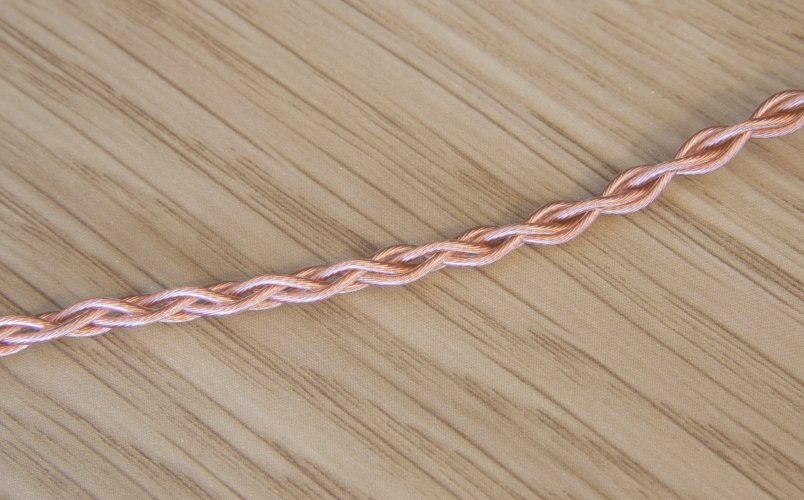
IEM comparisons
LETSHUOER Cadenza 12
The Cadenza 12 is still my all time favorite TOTL IEM to date. Keep this bias in mind as I tell everyone that I do like the Cadenza 12 over the Crimson. This is mostly because I like the highly resolving and neutral sound the Cadenza 12 provides. Both the Crimson and Cadenza 12 have what I would consider vastly different tunings. The Crimson is a dynamic sounding V/W shaped IEM that works very well with everything. The Cadenza 12 is a neutral turned IEM that also does mostly everything well but just a bit more safe. The Cadenza 12 can’t compete with the treble energy the Crimson provides but I found the detail retrieval to be slightly better on the Cadenza 12. Does that constitute a $700 price increase over the Crimson? Not even close. However, I do really enjoy the tuning and fit of the Cadenza 12 over the Crimson for my ears specifically. Read my note on fitment above.UM MEST MKIII
Both the MKIII and Crimson do wonder bass and soundstage/imaging. I’m gonna start off by noting that I found the MEST MKIII has some of the widest soundstage due to their unique bone conductor. Which provides a neat light echo to the entire stage which gives a high sense of space in tracks. The Crimson is just really good at a big sounding stage but without any of the tricks. Which is impressive given that both have about the stage soundstage width and depth to my ears. The bass impact on both is fantastic but I do find the bass sounds a little more controlled on the Crimson but doesn’t lack the slightly thinner mid bass the MKIII has. The mids on both are about the same with both sounding accurate and natural. The vocals on both are darn close to my ears and neither are artificial sounding. The big difference comes to the upper mids and treble. The MKIII has more upper mid presence and then starts to trail off in the upper treble. The Crimson can be much sharper sounding in the treble area and it has way more energy in the upper treble unlike the MKIII. I think this is where one has to choose very strong treble performance or a safe and more tame treble between the two. Both pull in great details and the resolution on both is really good.. For my personal preferences I really like the Crimson tuning but I have a hard time choosing between the two.
Amping Combinations
Hiby R6 PRO II
The R6 P2 is my favorite neutral-warm DAP and I like the pairing with the Crimson. The R6 P2 does well at not coloring the sound when listening with the Crimson. It also does well at bringing out a bit more energy when paired with the Crimson. The bass is nice and strong, the mids are fast and accurate, the vocals are smooth and natural sounding. The upper mids and lower treble do sound a little less intense here but I think the upper treble is still fast and detailed. Staging is close to the desktop stack I use but still very wide and deep sounding. Overall, an easy pairing to love.



